- Visit 100 Countries
- Visit 500 UNESCO Sites
- Landmarks of the World

Is it possible to visit Bath without visiting the place that gave the city its name in the first place? We suppose it is, but we think you’d be missing out on some great history and architecture if you didn’t go to the Roman Baths so we’d highly recommend a visit to this really great site.
Want to save this for later? Click the Pinterest button on the left for a pinnable image!
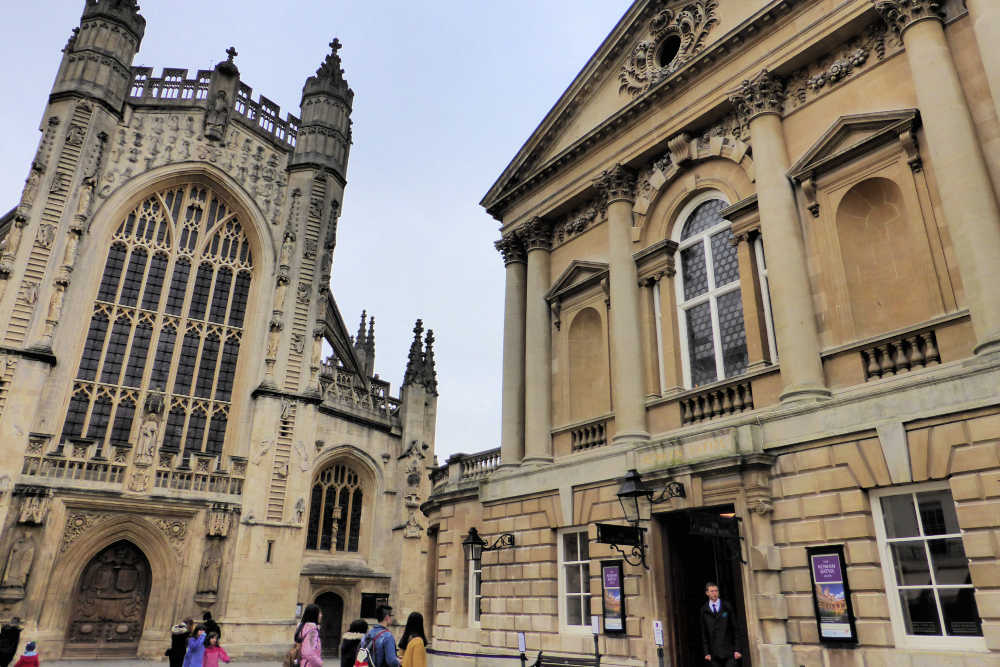
This post may contain affiliate links. Please read our full disclosure policy here .
Two traditions merged to create what is known today as the Roman style of bathing. One was the Greek public baths that had individual hip baths in heated rooms and cold water showers in their exercise halls. The other was Italian where the folks had small rooms, like saunas, in their farmhouses. These two styles came together in the 2nd century BC to create a leisurely approach to bathing that could take all afternoon and was an end in itself, not simply a way to get clean.
The hot spring that feeds the baths was known and worshipped to the goddess Sulis. When the Romans arrived in Britain they built a temple around the existing spring and a settlement grew up around it called Aquae Sulis. It is believed that locals cast curse tablets into the spring to request recourse for actions they felt aggrieved by. 130 of these tablets have been found in varying conditions.
The Roman Baths include, not only the Great Bath and Sacred Spring, but also heated rooms and cold plunge pools that visitors can view and learn more about how they heated these rooms.
READ MORE: Weekend Guide to Bath: 48-Hour Itinerary

HIGHLIGHTS OF THE ROMAN BATHS
Tours of the Roman Baths are self-guided with the included audio-guide. The audio-guide is available in 12 languages, with a guide just for children and another commentated by the author Bill Bryson.
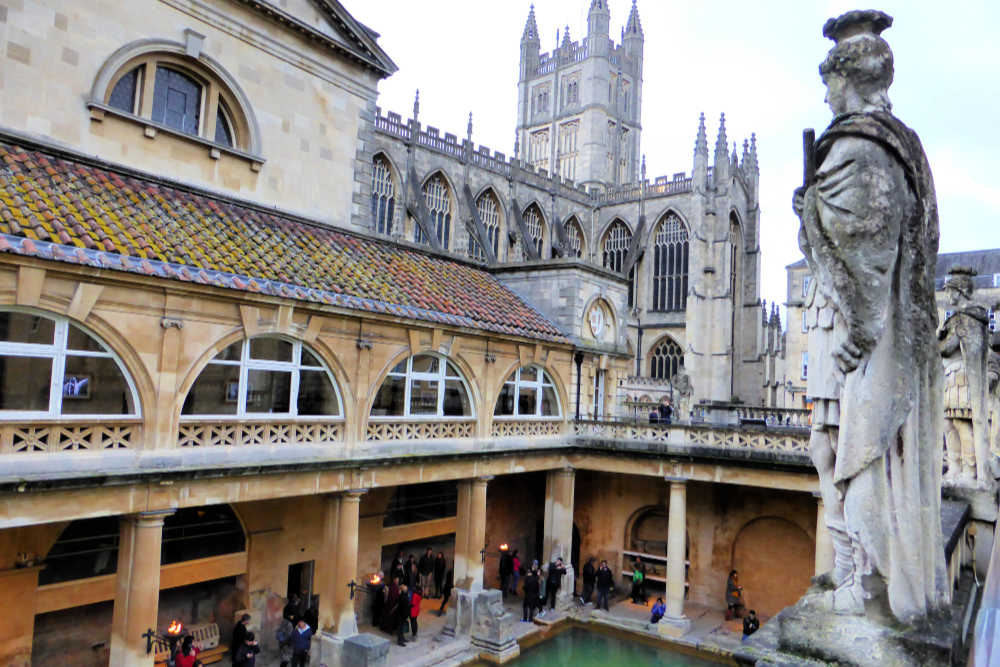
THE TERRACE
The terrace is lined with Victorian statues of Roman emperors and governors of Britain and they date back to 1894. Although my favourite view of the baths, the terrace really only allows you to see about a quarter of the whole site. Much of the Roman Baths extends under ground level, beneath the streets and squares nearby.
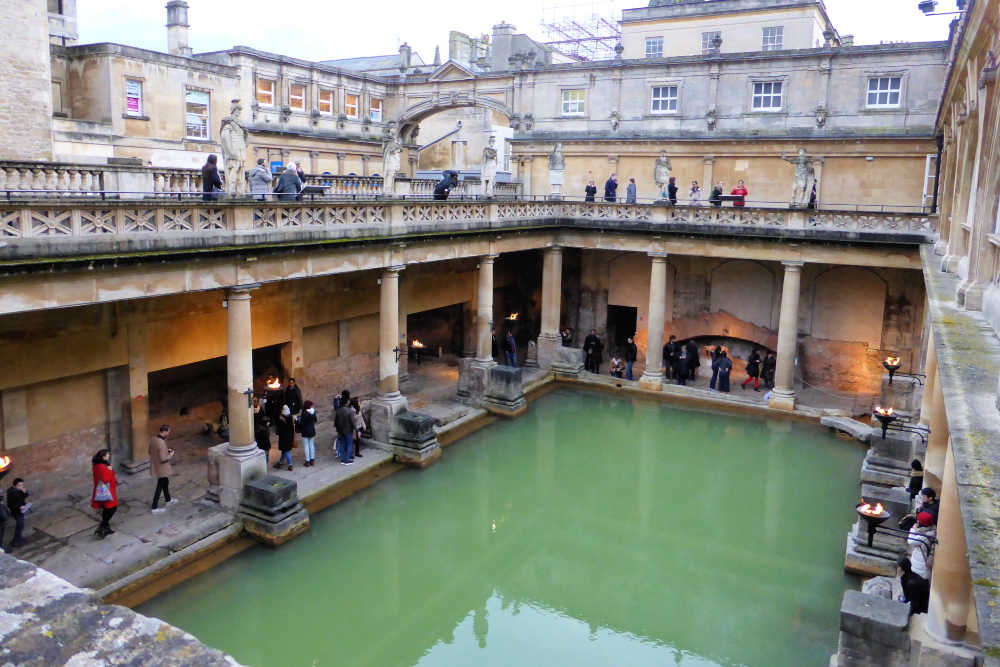
THE GREAT BATH
The Great Bath is lined with 45 sheets of lead and filled 1.6 meters deep with hot water from the springs. With little niches all around the sides, it would have been ideal for bathing as these would have held benches for the bathers and maybe even some small tables for food and drinks. During Roman times it was actually enclosed under a barrel-vaulted ceiling that was about 40 meters high.
With one look at the green water, many people probably wonder why anyone would want to bathe here. It doesn’t look very clean or particularly inviting but back in the day it actually wasn’t so green. With a roof over it, most of the sunlight would have been kept out and it wouldn’t have been quite the breeding ground for algae that it is today. Even though it is drained and cleaned frequently, the algae still builds up and gives it the characteristic green hue it has today.
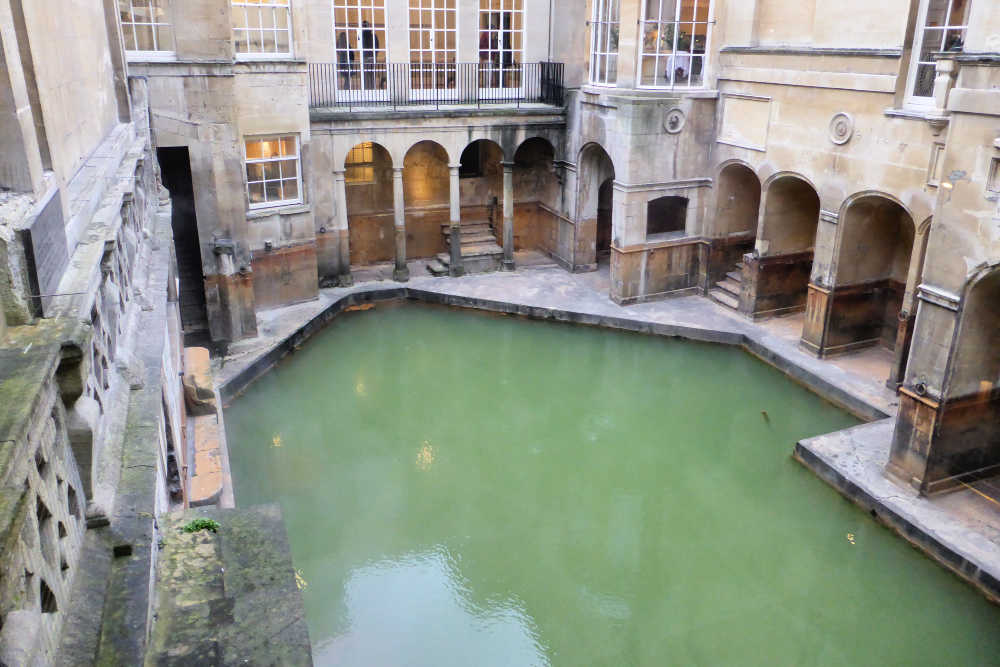
SACRED SPRING
Originally called Aquae Sulis , the town became known as Bath after the Romans moved in and created the firsts baths and temple buildings around the Sacred Spring in 76 A.D. Water temperatures in the Sacred Spring reach 46° C (114°F) and it was here that the spirit of the goddess Sulis Minerva dwelt and was worshipped. The local people also wrote curses about other people, for things like theft, on lead or pewter and threw these into the Sacred Spring to the goddess for her intervention with the thieves.
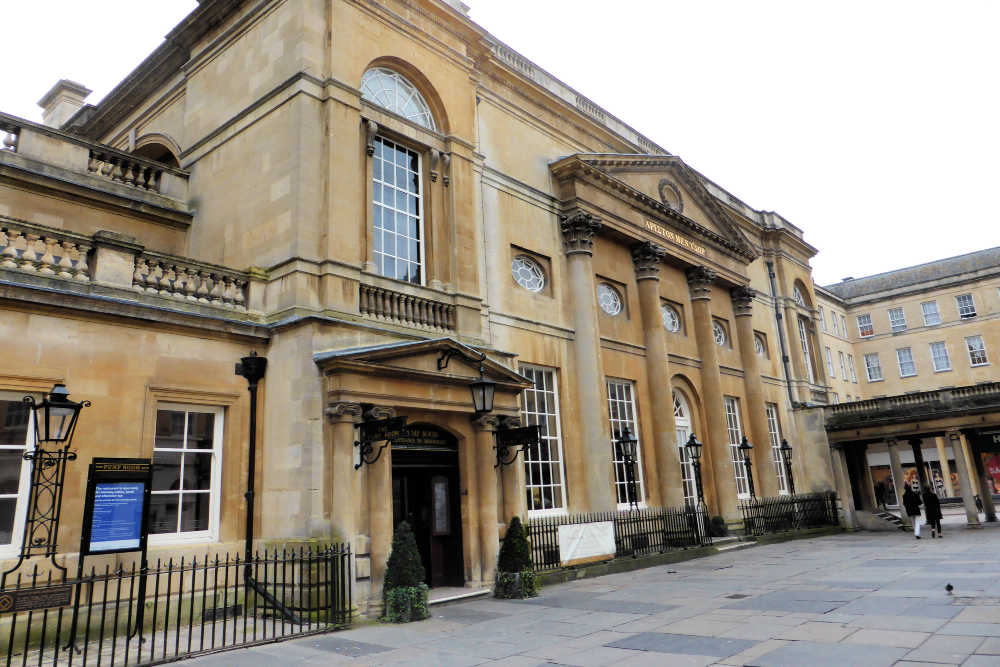
The Pump Room was added on much later, in the 18th century, and includes steps, or “slips”, that allow bathers to enter the water from passages below the Pump Room. Today the Pump Room is home to one of Bath’s most elegant places for British dining, perhaps a great place to stop for afternoon tea.
Visitors can also try a drink of the hot spa water at the fountain in the Pump Room. It contains 43 minerals and has been used for healing purposes for two thousand years. No worries though, if you aren’t able to dine at the Pump Room you can still enjoy a cup of the spa water at the end of the tour of the Roman Baths. Some say it tastes terrible but I didn’t think it tasted that horrible. Definitely give it a try if you visit.
READ MORE: Looking for more great things to see and do in Bath? Check out these 21 things to do in Bath !
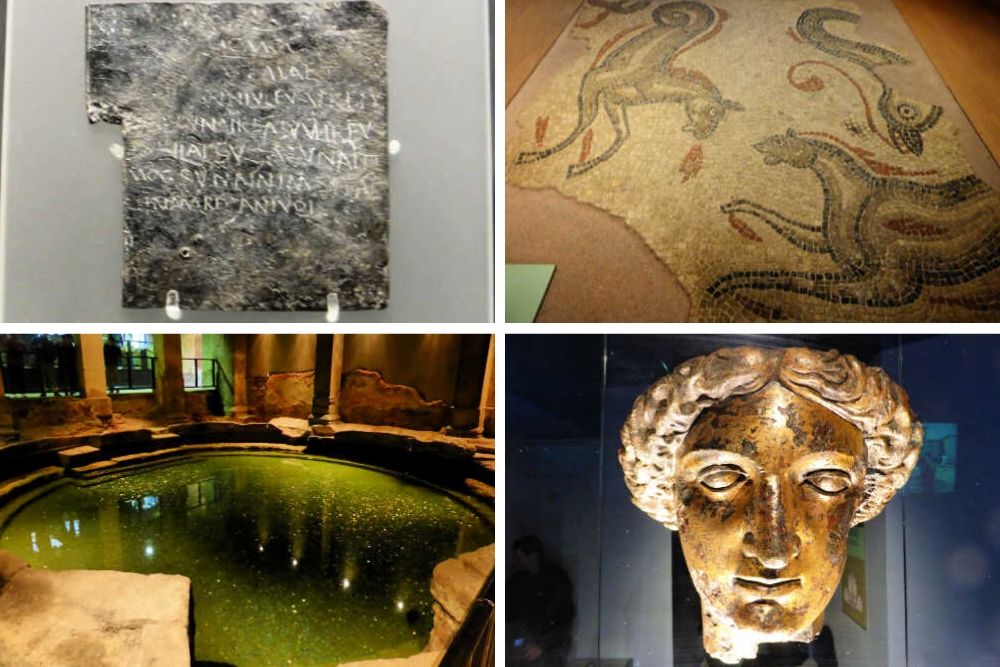
PLAN YOUR VISIT TO THE ROMAN BATHS
Information last updated December 2019
HOW TO GET THERE
The Roman Baths can be found at Abbey Church Yard, Bath, BA1 1LZ .
The nearest station is Bath Spa (Great Western Mainline) which is less than 10-minutes walk away. You can catch a bus (3, D1 discover or D3 discover) from the bus station outside Bath Spa to Guidhall which is just 1-minutes walk from the entrance to the baths.
Parking is available five-minutes walk away at Manvers Street Car Park . Parking is £1.60 per hour, with a minimum stay of two hours, up to £15 for 12 hours.
HELPFUL LINK:
- If you need an app that will navigate you around whether walking, driving or using public transport and even works offline then click for a guide about how to use Here WeGo .
OPENING HOURS
Opening hours vary throughout the year, but the core hours are 0930-1700 with earlier and later hours during high season, including late opening until 2100 in the summer. The baths are closed on the 25th and 26th December. For full opening times please check here .
As most of the attraction is indoors or at least undercover, any time of year is a good time to visit, only the terrace is exposed to the elements. We would recommend you allow at 90-minutes to two hours to fully explore the baths.
HOW TO BUY TICKETS & SAVE MONEY ON ADMISSION
Basic admission prices vary based on the season and whether you visit on a weekday or weekend. Basic prices range between £16-£23 for adults, £8.50-£15.50 for children 6-18 years and £21.50 for over 65s and student visitors. Family tickets for 2 adults and up to 4 children are £41-£63 and for one adult and up to 4 children £28.50-£45.50. One carer per disabled visitor can visit for free.
Museum saver prices which include admission to the Fashion Museum and Victoria Art Gallery are £26 for adults, £16 for children 6-18 years, £24.50 for over 65s and student visitors. Family museum saver for 2 adults and up to 4 children are £70 and for one adult and up to 4 children £49. This makes the museum saver a much better deal during high season!
You can save 10% on any ticket price by purchasing online in advance.
ACCESSIBILITY
90% of the site is accessible, but to access all areas you will need to climb steps. Access to the lower museum and the baths is via accessible lifts.
For full accessibility details please visit the Roman Baths Accessibility page.
ARE THE ROMAN BATHS WORTH THE VISIT?
The Roman Baths are the heart of the history of Bath and as such should definitely be on a visitors itinerary. There is much to see at the site beyond the great bath that you’ll see in all the pictures. Learning about the history of how the site was used as well as viewing the many artefacts that have been found in the museum is fascinating. The audio-guide is full of detail and hearing Bill Bryson’s take on the baths is a joy for fans of his work.
See what others think of this attraction on Trip Advisor .
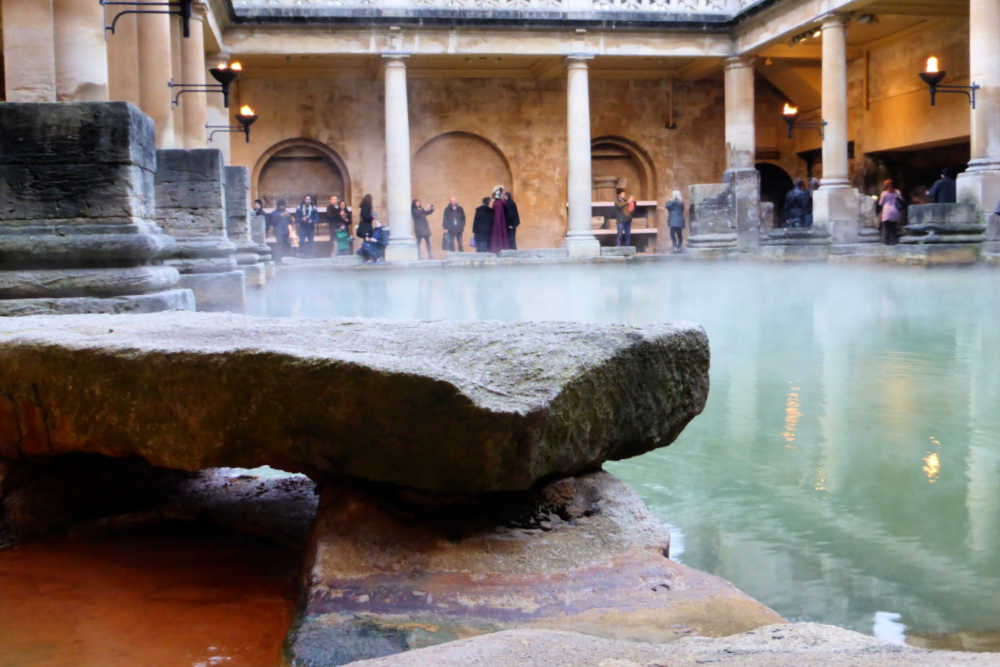
ADD TO YOUR BATH ITINERARY
Bath is most famous for the Roman Baths that the town is named for; heated from a natural spring with purported healing properties. The entire city was inscribed on the UNESCO World Heritage List in 1987 for its Roman remains and classic Georgian architecture. Visitors today can explore this compact elegant city and its many attractions.
- The free walking tour of Bath conducted by The Mayor of Bath’s Corps of Honorary Guides is easily the best value thing to do in Bath. Take a two-hour walk around this amazing UNESCO city with expert guides.
- With its stone depiction of Jacob’s Ladder on the west front, Bath Abbey is one of the most famous and beautiful things to see in Bath.
- Experience how Bath’s residents would have lived in the late 18th Century with a visit to No 1 Royal Crescent .
For a modern take on a Roman Bath, visit the Thermae Baths with their open-air rooftop pool filled and heated with the natural spring water the Romans would have used.
- Walk across the much-photographed Pulteney Bridge , though you won’t know you are on a bridge, as it has shops on both sides across the whole width of the bridge!
RESOURCES | PLAN YOUR TRIP TO BATH
To book flights, rental cars, accommodations, and activities for your trip, please check out our recommended travel providers, favourite apps and websites.
Some of the links in the post above are affiliate links. This means if you click on the link and purchase the item, we will receive an affiliate commission but this does not affect the price to you. Please read our full disclosure policy here .

RELATED POSTS
Guide to visiting cornwall’s geevor tin mine, weekend breaks in england, day trips from london.
Explore Bath's world heritage

Other things to do in Bath
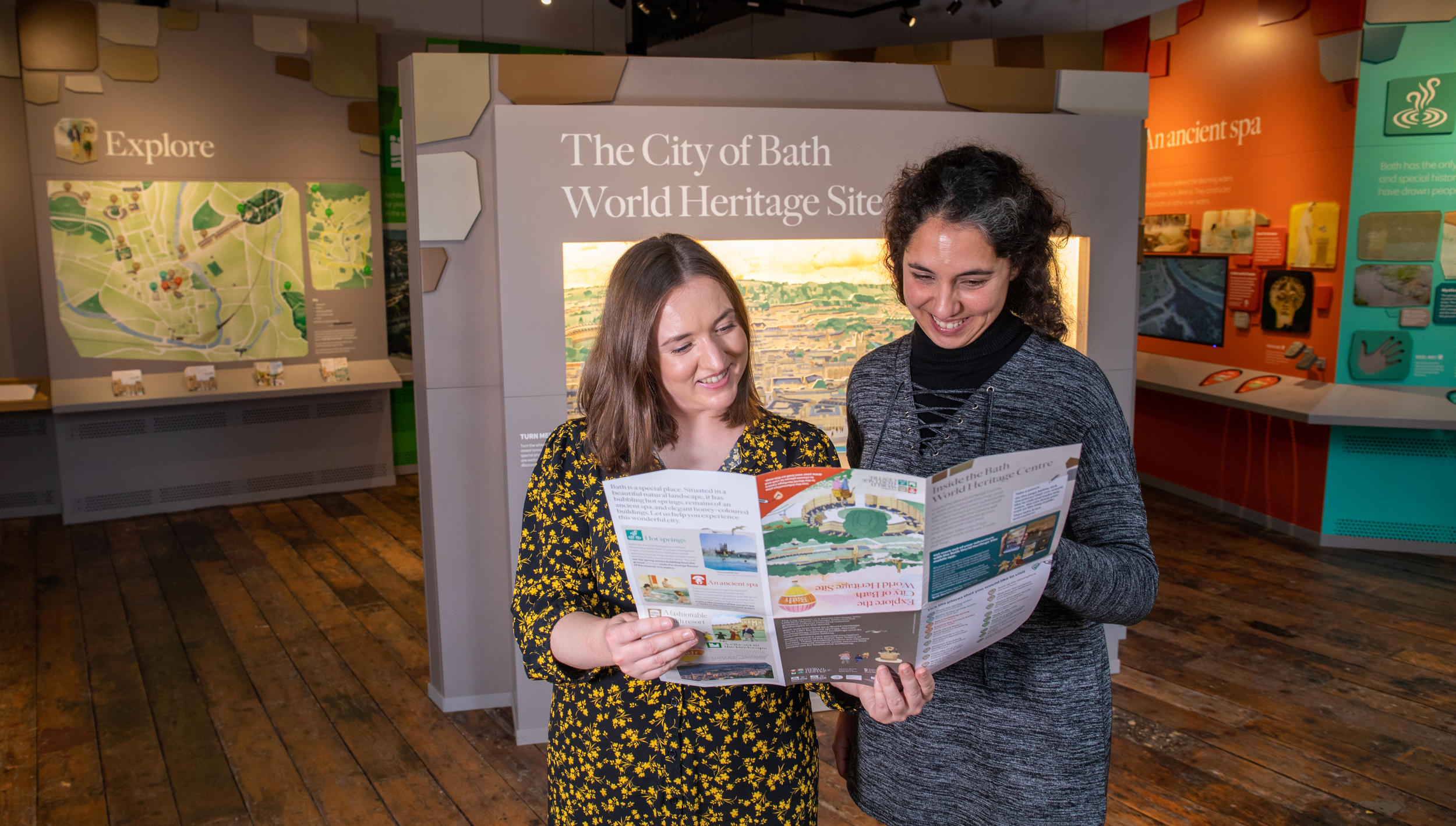
The City of Bath is exceptional in having two UNESCO inscriptions.
Bath world heritage, bath world heritage centre, world heritage guide, follow us on social media.

©antb/Shutterstock
Roman Baths
Top choice in Bath
Welcome to one of Northern Europe's most significant Roman sites. Today more than a million visitors a year come to see its historic finds, atmospheric pools and imaginative displays, making this one of Bath's top things to do. Best of all you can still sample the waters that drew the Romans here almost 2000 years ago.
The elaborate spa complex dates from around 70AD and was known then as Aquae Sulis. In typically ostentatious style, the Romans built a bathhouse complex above Bath's 115°F (46°C) hot springs. Set alongside a temple dedicated to the healing goddess Sulis-Minerva, the baths now form one of the world's best-preserved ancient Roman spas, and are encircled by 18th- and 19th-century buildings.

Inside the Roman Baths
The heart of the complex is the Great Bath , a lead-lined pool filled with steaming, geothermally heated water from the so-called "Sacred Spring" to a depth of 1.6m. Though now open-air, the bath would originally have been covered by a 45m-high barrel-vaulted roof.
More bathing pools and changing rooms are to the east and west, with excavated sections revealing the hypocaust system that heated the bathing rooms. After luxuriating in the baths, Romans would have reinvigorated themselves with a dip in the circular cold-water pool .
The King's Bath was added sometime during the 12th century around the site of the original Sacred Spring. Every day, 1.5 million liters of hot water still pour into the pool. Beneath the Pump Room are the remains of the Temple of Sulis-Minerva .
Digital reconstructions pop up in some sections of the complex, especially in the Temple Courtyard, and the West and East Baths, which feature projections of bathers. There is also a fascinating museum displaying artefacts discovered on the site. Look out for the famous gilded bronze head of Minerva and a striking carved gorgon's head, as well as some of the 12,000-odd Roman coins thrown into the spring as votive offerings to the goddess.

Surrounding buildings
The complex of buildings around the baths was built in stages during the 18th and 19th centuries. John Wood the Elder and the Younger designed the buildings around the Sacred Spring, while the famous Pump Room was built by their contemporaries, Thomas Baldwin and John Palmer, in neoclassical style, complete with soaring Ionic and Corinthian columns. The building now houses a restaurant , which serves magnificent afternoon teas. You can also taste free samples of the spring waters, which were believed in Victorian times to have curative properties. If you're lucky, you might even have music provided by the Pump Room's string trio.
Tickets and other practicalities
To dodge the worst of the crowds avoid weekends, and July and August. Tickets and time slots should be booked online in advance . Admission to the Roman Baths includes an audio guide, featuring commentary in 12 languages – there's also one especially for children and a guide in sign language. The majority of the site is accessible to wheelchair users, but there are some steps.
The water here is completely untreated and is not safe for swimming. However, you can sample the city's curative waters at the fantastic modern Thermae Spa complex , housed nearby in a shell of local stone and plate glass. The showpiece is the open-air rooftop pool, where you can bathe in naturally heated, mineral-rich waters with a backdrop of Bath's cityscape – a don't-miss experience, best enjoyed at dusk.
Abbey Churchyard
Get In Touch
01225-477785
https://www.romanbaths.co.uk/
Lonely Planet's must-see attractions

Glastonbury Tor
21.99 MILES
Topped by the ruined medieval Chapel of St Michael, the iconic hump of Glastonbury Tor is visible for miles around, and provides Somerset with one of its…

27.04 MILES
An ultramodern makeover at ancient Stonehenge has brought an impressive visitor centre and the closure of an intrusive road (now restored to grassland)…

Avebury Stone Circle
22.05 MILES
With a diameter of 348m, Avebury is the largest stone circle in the world. It's also one of the oldest, dating from 2500 to 2200 BC. Today, more than 30…

Brunel's SS Great Britain
11.72 MILES
This mighty, innovative steamship was designed by engineering genius Isambard Kingdom Brunel in 1843. You get to wander the galley, surgeon's quarters and…

Tintern Abbey
25.74 MILES
The haunting riverside ruins of this sprawling monastic complex have inspired poets and artists through the centuries, most notably William Wordsworth,…

No 1 Royal Crescent
For a glimpse into the splendour and razzle-dazzle of Georgian life, head for the beautifully restored house at No 1 Royal Crescent, given to the city by…

Chepstow Castle
22.69 MILES
Imposing Chepstow Castle perches atop a limestone cliff overhanging the river, guarding the main river crossing from England into South Wales. It is one…

Wells Cathedral
17.05 MILES
Wells' gargantuan Gothic cathedral sits plumb in the centre of the city, surrounded by one of the largest cathedral closes in England. It was built in…
Nearby Bath attractions
1 . Pump Room
The centre of this grand 19th-century room is filled with tables from the Pump Room Restaurant, but there's also an ornate spa fountain from which Bath's…
2 . Bath Abbey
Looming above the city centre, Bath's huge abbey church was built between 1499 and 1616, making it the last great medieval church raised in England. Its…
3 . Victoria Art Gallery
Bath's second-most-visited museum has collections that include everything from Turner and Gainsborough to contemporary art. The programme of temporary…
4 . Pulteney Bridge
Elegant Pulteney Bridge has spanned the River Avon since the late 18th century and continues to be a much-loved and much-photographed Bath landmark (the…
5 . Jane Austen Centre
Bath is known to many as a location in Jane Austen's novels, including Persuasion and Northanger Abbey. Although Austen lived in Bath for only five years,…
6 . Herschel Museum of Astronomy
In 1781 astronomer William Herschel discovered Uranus from the garden of his home, now converted into a museum. Herschel shared the house with his wife,…
7 . Georgian Garden
These tiny, walled gardens feature period plants and gravel walkways. They've been carefully restored and provide an intriguing insight into what would…
8 . The Circus
The Circus is a Georgian masterpiece. Built to John Wood the Elder's design and completed in 1768, it's said to have been inspired by the Colosseum in…
Explore the iconic Roman Baths
Bath, somerset.
See one of the best preserved Roman remains with your very own eyes on an exploratory trip to the Roman Baths.
1,170,000 litres of steaming spring water reaching 46 °C still fill the bathing site every single day. The Romans believed that this was the mystical work of the Gods but we now know that the water source, which comes from the King’s Spring, fell as rainwater around 10,000 BC.
Visit The Great Bath, the magnificent epicentre to the complex, and walk on the ancient pavements as the Romans did 2,000 years ago. Afterwards, spend some time exploring the interactive museum full of ancient coins and artefacts that were found in the baths.
Accessible features
Opening to visitors in 1897, this Ancient Monument had limited accessibility, but over the past ten years, the heritage attraction’s key focus has been on making it accessible to all visitors. Thanks to recently introduced lifts and step-free walkways, the Roman Baths is now 90% accessible for wheelchair users, and its innovative suspended walkway now allows visitors - both on foot and using wheelchairs - to experience the ancient Temple Precinct together.
If you've got limited mobility, you can borrow wheelchairs and walking stick seats free of charge, and there's even a small mobility scooter available if yours is too large for the lifts.
If you have hearing or visual impairments, there are British Sign Language and enhanced descriptive tours, audio tours in 12 languages and digital projections of Roman life shown throughout the site.
Information is also available in large print and braille, alongside tactile maps and models. For visitors with autism, there are information sheets available on the attraction’s website to help plan a stress-free visit.
- Find out more about the Roman Baths
- Find out more about the Roman Baths' accessibility
- Find more spa breaks in Bath
For more local tourist information:
- Twitter @VisitBath
- Facebook Visit Bath Facebook
- Website Visit Bath Instagram
- Website Visit Bath website
- Website Contact Visit Bath
Refine your search:

You may be interested in...
Enjoy quality time with the kids at Woolley Grange
Make some everlasting memories with the whole family at this kid friendly hotel on the edge of the picturesque Cotswolds.
Location: Bath, Somerset
Rainy Day Activities: Experience the underground world of Wookey Hole
There are legends aplenty about Britain’s biggest caves, where you’ll find a secret river and bewitching caverns.
Location: Wells, Somerset
Picnic in Bath's most elevated park
Enjoy stunning views of the World Heritage City of Bath from the steep hill-top setting of Alexandra Park.
Cycle The Two Tunnels Circuit of Bath
The Two Tunnels path has transformed a stretch of disused railway line into a walking and cycling track complete with music and light installations.
We've something we want to share
Want to receive travel tips and ideas by email?
VisitEngland would like to invite you to take part in a short survey about our website, it should take no more than a couple of minutes.
Go to the survey
To add items to favourites …
… you need to be logged in.
If you already have an account, log in.
Or register a new account
Access your account

Go South West England
How to visit the Roman Baths, Bath: an ancient spa & temple
Standing on the balcony of the Roman Baths, with statues on either side and the deep green pool of water sitting below, views of the abbey in the background is an awe-inspiring experience.
The baths themselves outstanding feat of engineering, one of the tallest buildings in the Roman world, that all originated in their passion for bathhouses and the fact that Bath is the only place in the UK with natural warm springs.
I used to live in Bath, and thanks to the fact that I got free entry to the attraction with my BANES resident card (more on this later!), I’ve visited the Roman Baths more times than I could count.
No matter how many times I’ve walked around them, I always find something new to wonder at.
Recently, I returned to Bath for the day to refresh my knowledge of them (and of Bath’s other attractions!) so I could write this post!
So, here’s everything you need to know when visiting the Roman Baths in Bath.
Table of Contents
Roman Baths history
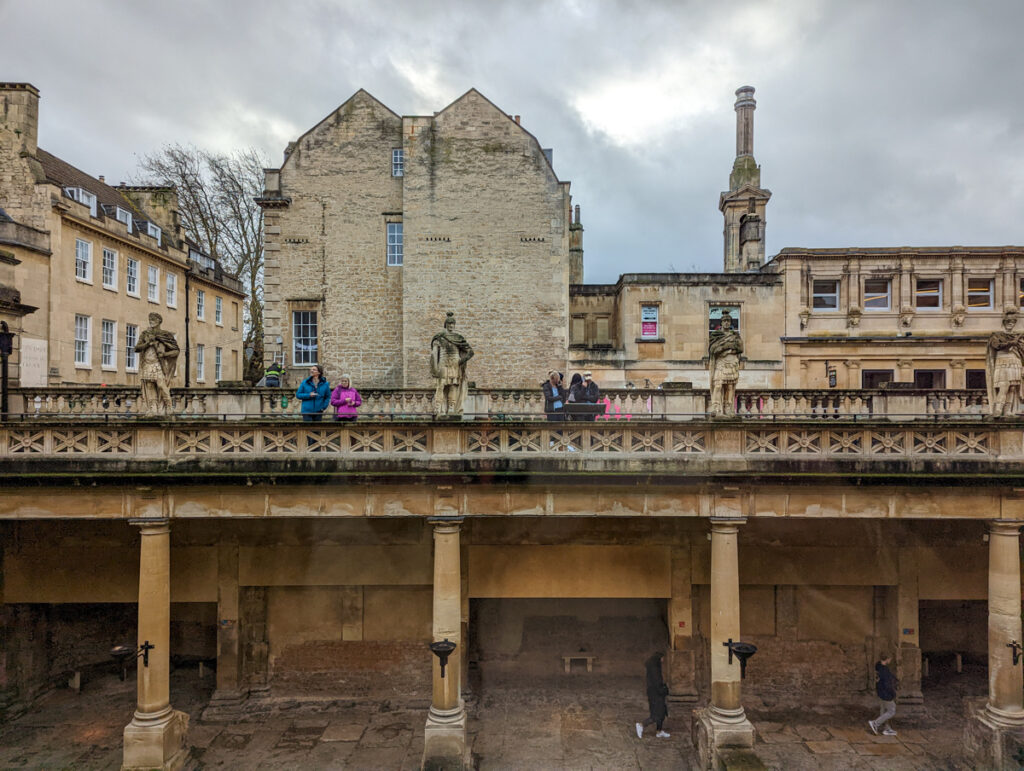
The Romans ventured over to Britain around AD 43, although Juilis Ceaser had ordered a few explorations of the country around 100 years before, which didn’t leave to conquest.
They arrived in Bath by AD 48.
At the time, the area was inhabited by the Donburi tribe, a Celtic group.
The Romans gradually took over, probably attracted to Bath originally because they knew about the hot springs here (the Donburi had been trading with Europeans for many years prior to the Roman invasion).
So, the Romans constructed their bathhouses, as they did in locations all over the world (from Rome itself to Carthage in Tunisia!).
The bathhouses were not just a place of leisure and relaxation, but also a site of worship and socialising.
The building was 20 metres high when it was built – which isn’t much nowadays, but then it was virtually a skyscraper!
The bathhouses were definitely standing by 75 AD, although it’s likely that they were built a few decades before.
By the 4th century, they were fully developed and were one of the most important buildings in Roman Britain.
After the Romans left Britain by 410 AD, the baths fell out of use, gradually being covered over in rubble and eventually fully covered.
It wasn’t until the Victorian era, when the public started to pay more interest to Britain’s heritage, that excavating work began.
They’ve been open to the public since 1897, although of course, the museum came later!
In 2011, the baths completed a £5.5 million redevelopment which aimed to make it more accessible and protect it for the next 100 years.
Where are the Roman Baths?
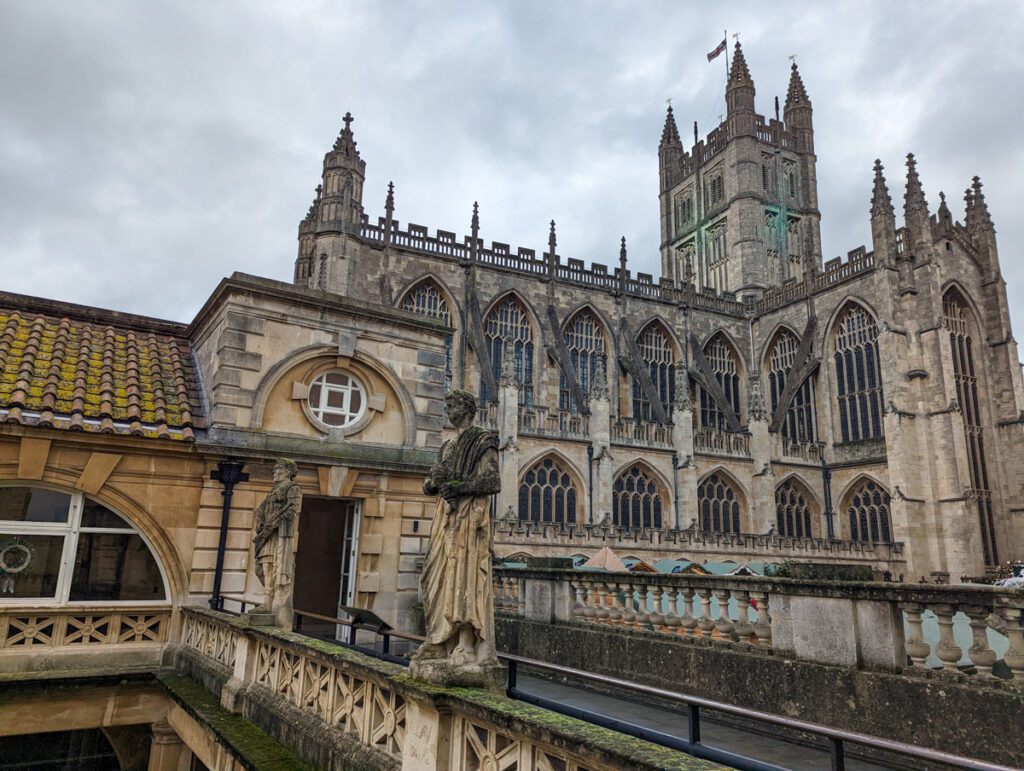
The Roman Baths are right in the heart of Bath’s city centre, next to the abbey and the pump rooms.
They’re just a six-minute walk from Bath Spa Station.
The address is: The Roman Baths, Abbey Church Yard, Bath BA1 1LZ.
Things to do at the Roman Baths
Walk around and take in the views.
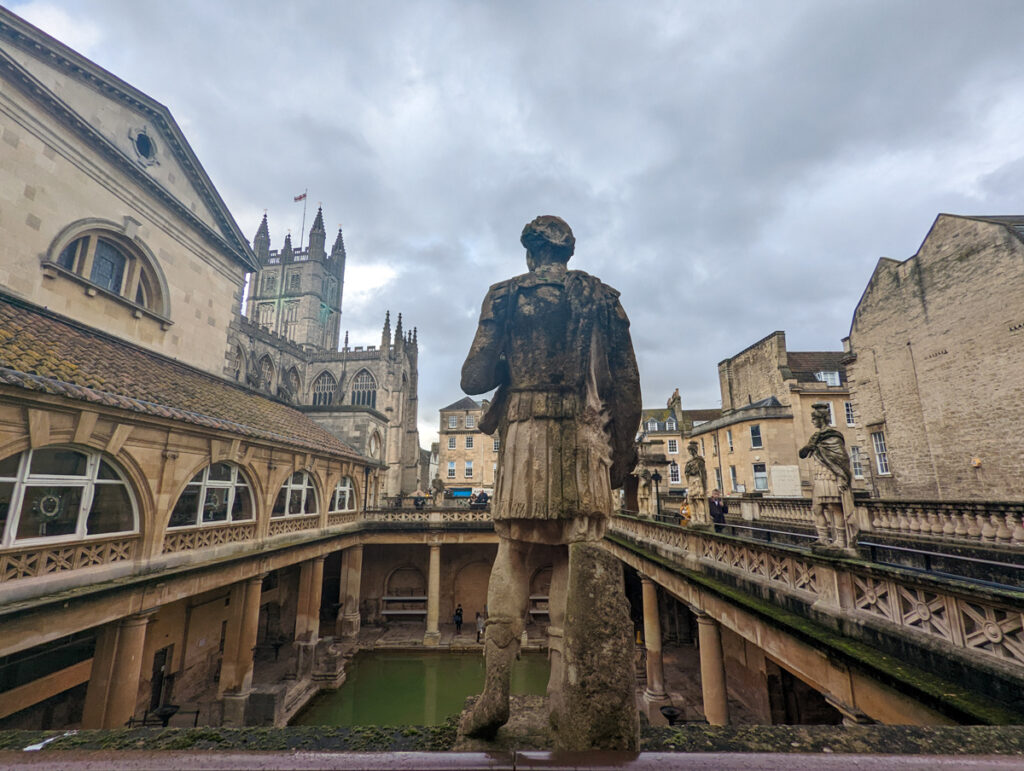
After you leave the ticket office, you’ll have a chance to walk around the upstairs terrace area, where you can look over into the filled pool.
This area is lined with statues; they aren’t Roman (they date back to the Victorian era when the bathhouses were excavated!) but they all represent Roman governors.
As you walk to the far side of the baths, you’ll take in some gorgeous photos of the building, the statues, and the abbey. I love this shot as it shows some of Bath’s layers of history.

Walk through the museum
Once you’ve marvelled at the views, head down into the Roman Baths museum.
Here, you’ll learn lots of detail about the baths and their place in the Roman world.
There are lots of exhibitions that make history come to life, plus opportunities to listen to an audio guide.
Some of the audio guide extracts are made especially for kids, and Bill Bryson has recorded others!
See the Temple pediment and Gorgon’s head
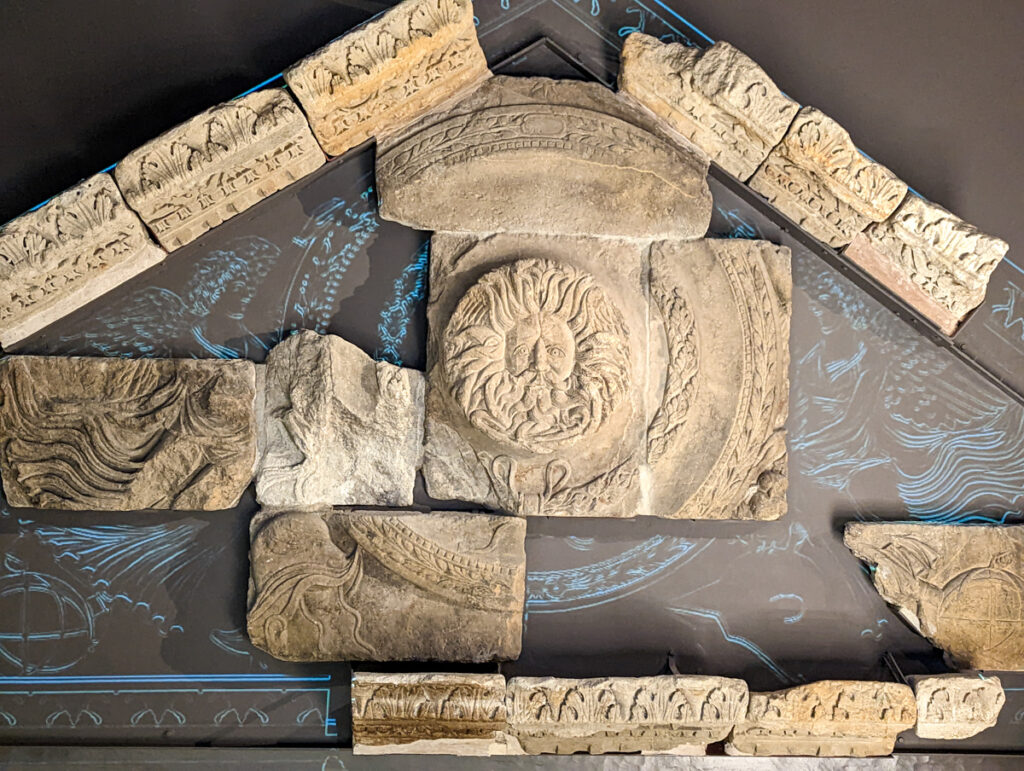
The Temple pediment and Gorgon’s head is a beautifully carved Roman statue that stayed preserved until 1790, when it was discovered.
It’s one of the most impressive Roman carvings in the world, showing incredibly sophisticated workmanship for this age, depicting Gorgon, who was a Greek mythological creature, who was immortalised by becoming the main deity of Bath.
Walk through the temple area
Once you’ve learned all about the Romans, it’s time to see their place of worship! Your tour takes you through the main temple area.
Although the baths are most famous for their spa facilities, this complex was actually foremost a temple, somewhere for people to pray to deities, often Gorgon or Minerva.
Nowadays, the ruins of the temple remain, and you can walk on the elevated flooring above them, finally approaching a statue of Minerva’s head at the end.
Walk out to the Great Bath
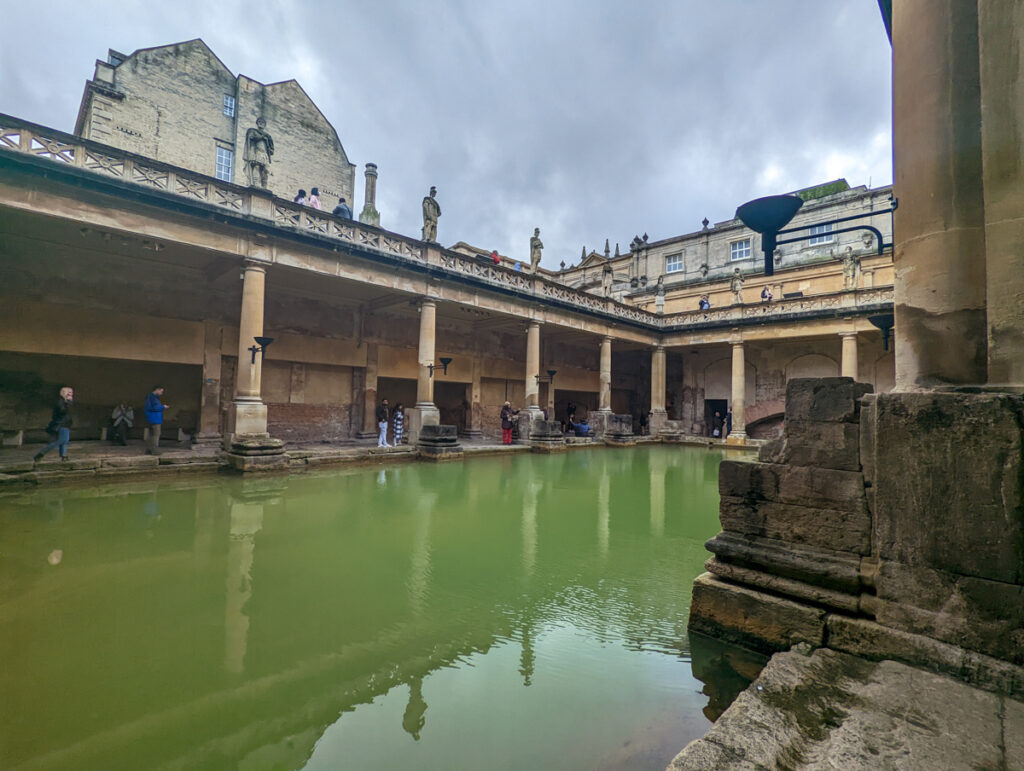
Your tour then takes you outside, to see the brilliantly blue-green pool of the great bath. Take a stroll around the side and admire the architecture!
This bath is synonymous with the city, and you can stand right at the water’s edge to take it all in. You can’t, unfortunately, swim in it – you’ll need to go to the Bath Thermae Spa to do that!
See the east baths
Once you’ve walked around the baths, there will be a sign directing you to the east baths. These are undercover baths that provide an immersive look at what Roman leisure was like, with projectors showing typical bath scenes.
Hear the sacred spring
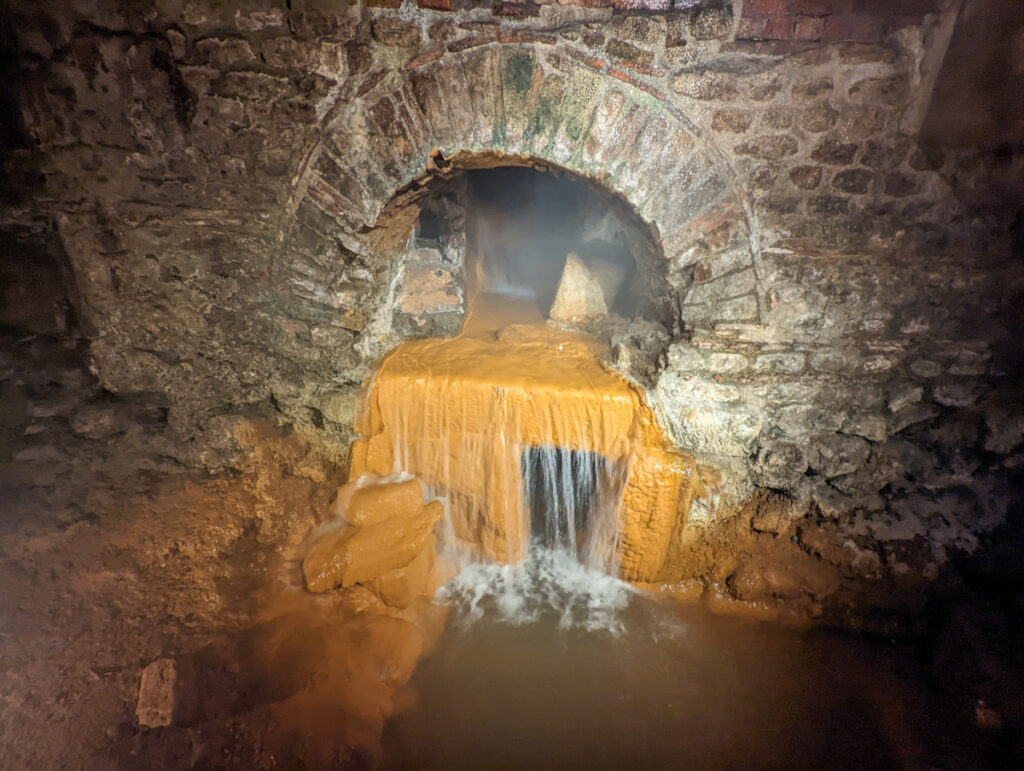
The sacred spring is a waterfall-like feature that gushes from one level of the baths to the other. This is entirely man-made, but it looks natural, and its a great reminder of the epicness of Bath’s hot springs!
Taste some of the water yourself!
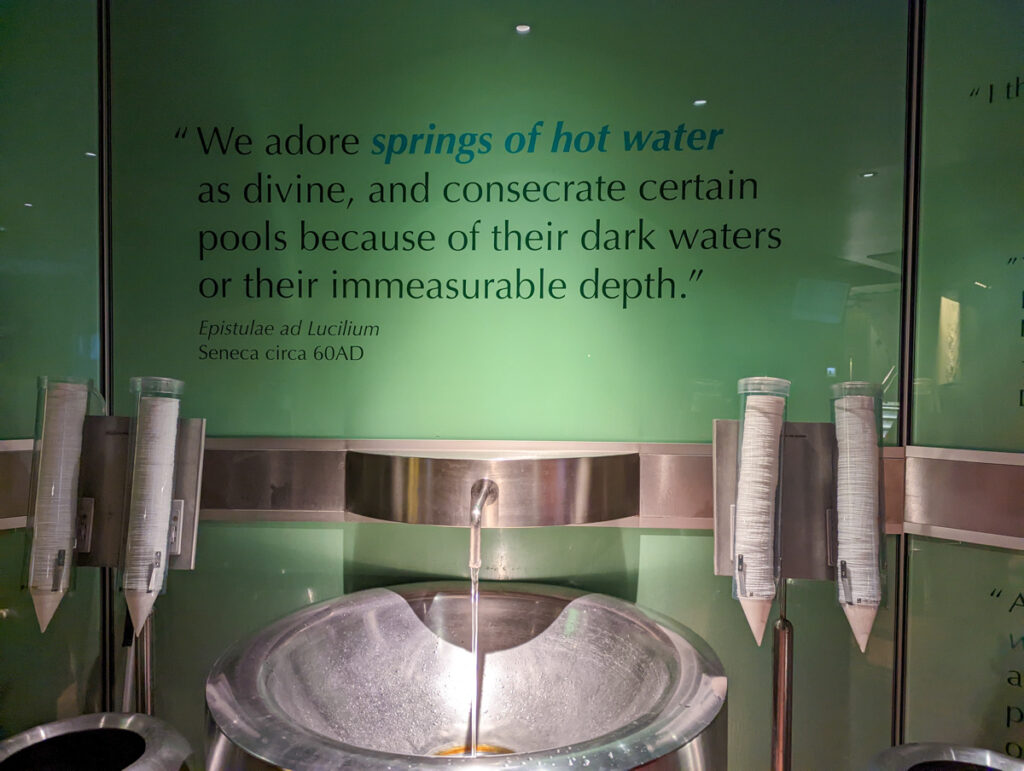
Once you’ve toured the water, why not taste some of it? It’s very mineral-rich, with around 2270 milligrams of minerals per litre, including sulphate, calcium and chloride amongst 20 others.
It’s alleged to have many healing properties – but I’ll be honest, it’s not the best tasting!
Roman Baths visiting information
How much does the roman baths in bath cost .
Standard tickets cost £20.50 at the weekend, or £18.00 on a weekday.
For students and seniors, it’s £19.50 at the weekend or £17.00 on a weekday.
And child rates are £13.00 at the weekend or £10.50 on a weekday.
This includes entry and the use of an audio guide.

Are there any concessions?
Yes, rates are cheaper for students and seniors.
Additionally, Bath residents (who hold a BANES card), full-time students at the University of Bath and Bath Spa University and discovery cardholders get free entry.
Children who have a Blue Peter badge also get free entry.
What are the opening hours?
The Baths usually open at 10 and close at various times throughout the year – in the winter, they usually close around 5:00 pm on weekdays and at about 8:00 pm on weekends.
Where to stay near the Roman Baths
The Gainsborough Bath Spa Hotel is the only British hotel that has on-site access to natural warm spring waters. Here, enjoy a spa village, a restaurant and a bar. All rooms boast high-quality bed linen, dressing gowns and comfortable slippers, along with nespresso coffee machines and flat-screen HD TVs.
The Apex City of Bath Hotel is a five minute walk away and is one of the best-value places to stay in the city. It boasts an indoor pool, gym, restaurant and bar and has comfortable and luxurious rooms.
Z Hotel is a budget Bath accommodation option. Althoguh the rates are low, the rooms are clean and comfortable, with flat-screen wall-mounted TVs and comfortable beds.
You can see all of the best places to stay around Bath here.
Places to visit near the Roman Baths
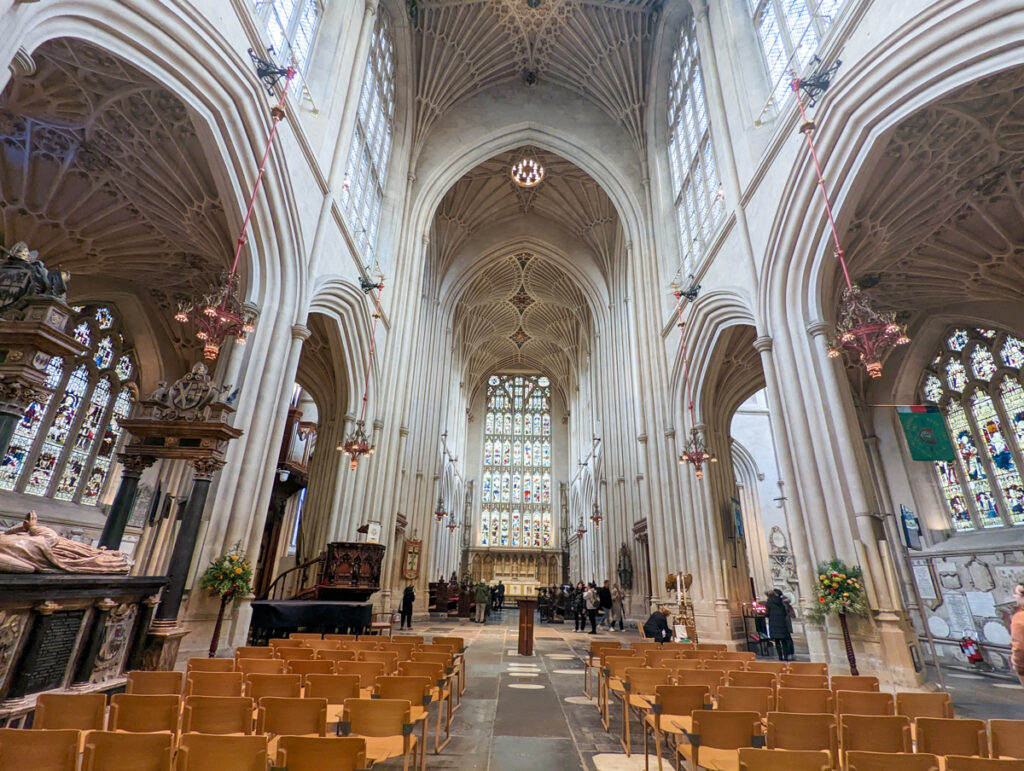
You’re in luck when you exit the Roman Baths, as many of the city’s best attractions are right next door.
Bath Abbey , the city’s main place of worship that has an extensive history spanning back to Medieval times, is literally right next door.
The other side, you’ll find the Pump Rooms , one of the best places in the city for afternoon tea.
You also only need to walk a few steps down the road to see the Thermae Bath Spa !
Are the Roman Baths in Bath worth visiting?
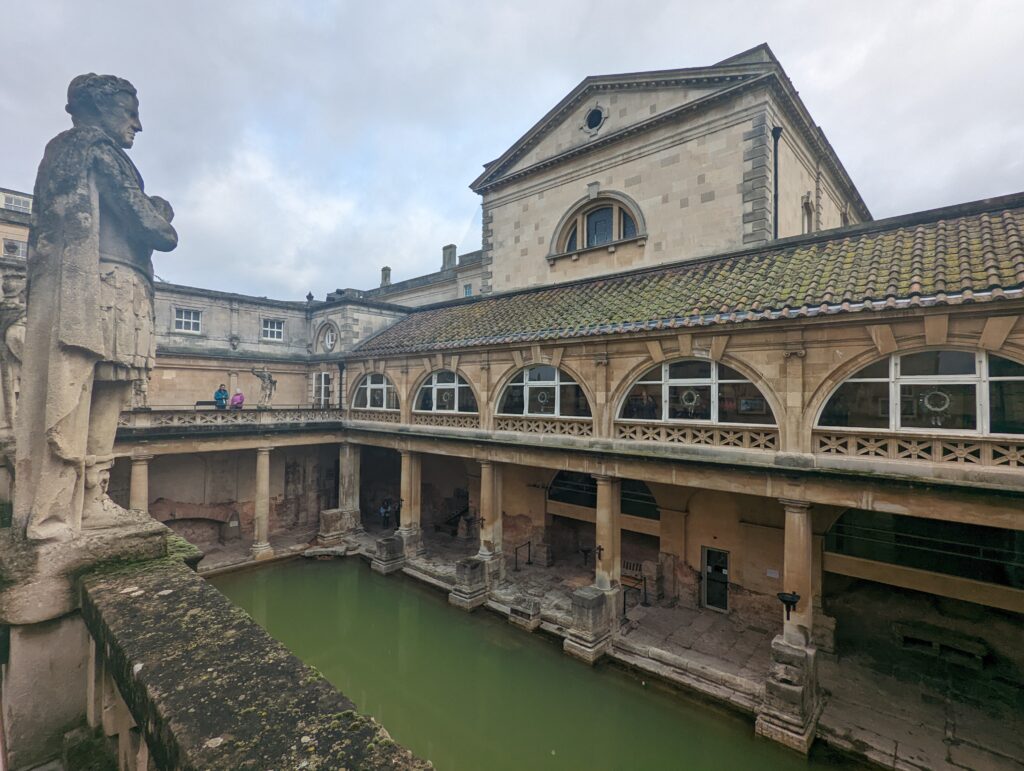
I think so!
They’re one of the most interesting and well-preserved Roman complexes in the country and give a valuable snapshot of what life was like back in these ancient times, which ultimately had huge impacts on the country, some of which are still felt today.
You’ll learn about the Roman lifestyle and see some impressive remains.
You could easily spend 1-2 hours here taking everything in; so it’s definitely worth your time, whether you’re spending a weekend in Bath or even living here!
Similar Posts

Bath walks: Best strolls in and hikes around Bath

Clip n’ Climb Weston-super-Mare: South West’s Highest Walls!

Where is the West Country? A geographical and cultural guide

18 Fascinating Cornwall Landmarks: The Old and New!
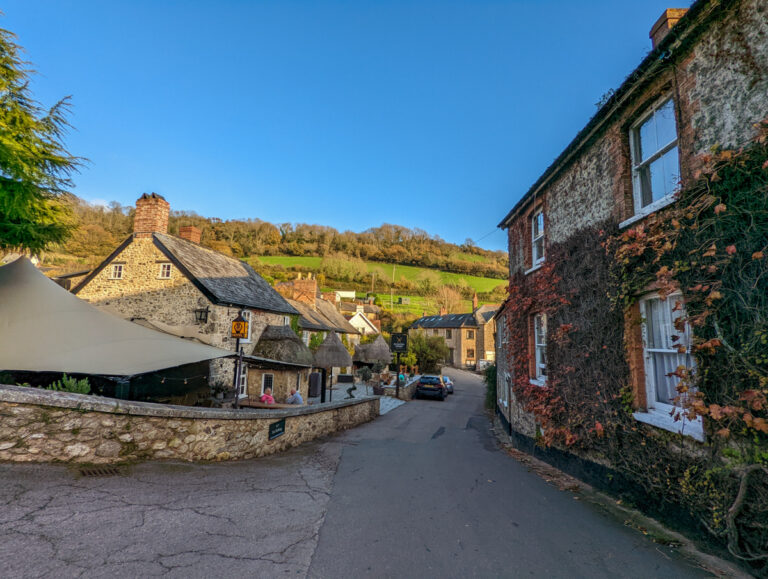
Things to do in Branscombe, East Devon (on Jurassic Coast!)
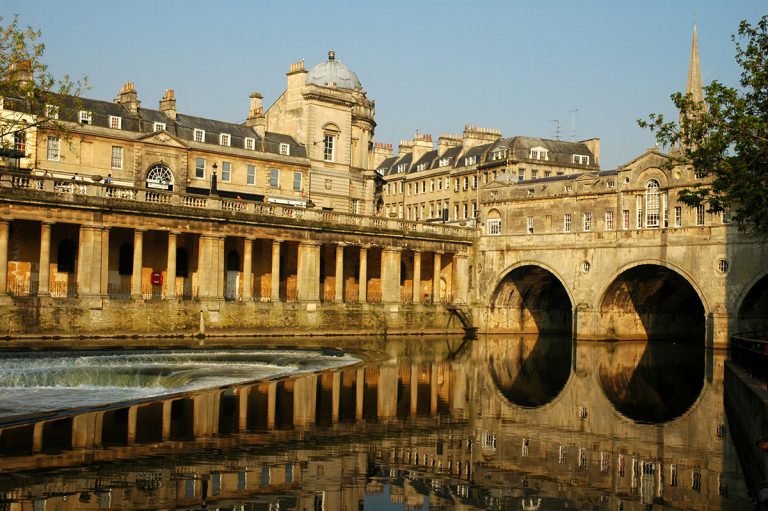
Weekend in Bath Itinerary
Leave a reply cancel reply.
Your email address will not be published. Required fields are marked *
Save my name, email, and website in this browser for the next time I comment.

- Meet the Team
- Work With Us
- Itineraries
- Italy Travel Guide
- Hawaii Travel Guide
- Travel Tips
Attractions
How to visit the historic roman baths in bath, england.
One of the most intriguing and interesting historical sights in South West England is the historic Roman Baths in Bath, England. It’s a sight you definitely must visit while in the area.
While it might be difficult to imagine a life where public baths were an integral part of community life, that was certainly the case for the ancient Romans who built the baths more than 2000 years ago. Visiting the baths will give you a unique perspective on what it would was like for the Romans.
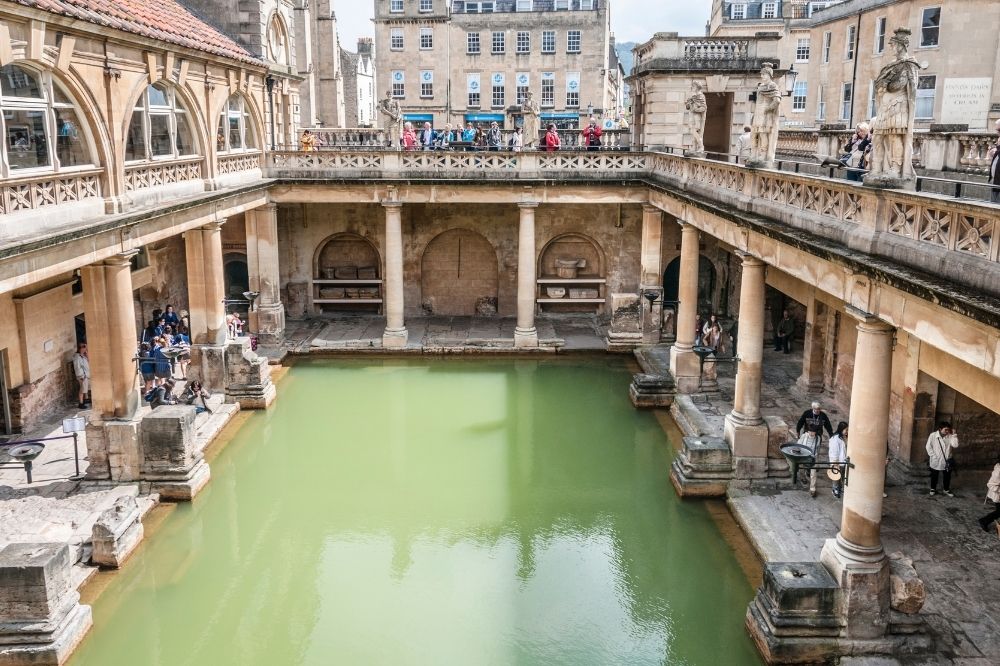
The city of Bath as a tourist destination has a lot to offer, both in terms of historical and modern attractions, as we learned recently on our tour of South West England . We could have easily spent a full week in Bath, even though it is a relatively small town.
We stayed very close to the city center, at the lovely Brooks Guesthouse , which made it very easy for us to walk to the main attractions, including the Roman Baths, which are just one of the great attractions of this incredible place.
Bath is less than a 2-hour drive from Heathrow, but you can also take a train that will bring you right to the city quickly and easily.
Read our other England articles:
- How to Spend 2 Days in Bath
- Visit the Thermae Bath Spa
- Plan a Visit to Stonehenge
- How to Spend 2 Days in Bristol
» If you’re looking for more help planning your trip, here’s our guide to traveling in England , our Essential Travel Guide to London , and How to Spend One Day in London .
Table of Contents
How to Plan Your Visit to the Roman Baths

You’ll want to book your timed tickets well in advance of your trip, so you can get the day and time of your choosing. It’s very easy to book tickets on line, or you can go on a guided tour with a walking tour of the city through Viator .
What Are the Historic Roman Baths?
The Roman Baths is an archaeological site that contains the remains of a large Roman bath complex, built around the year 138. The Roman Bath (a significant structure first discovered in 1590, and subsequently restored in the 18th century), is the main feature of the site.
The Roman Baths were used as a public bath house where the Romans bathed together for health purposes and for socializing. The water comes from natural hot springs below the surface that were discovered on that location long before the Roman invasion.
Inside the complex, y ou will learn all about the bath houses and how Roman society used them. The building that houses the Roman Baths, aside from being obviously historic and grandiose, doesn’t give away much from the exterior, but once you get inside you’ll see just how impressive this place is, especially The Great Bath, in the center of the building.
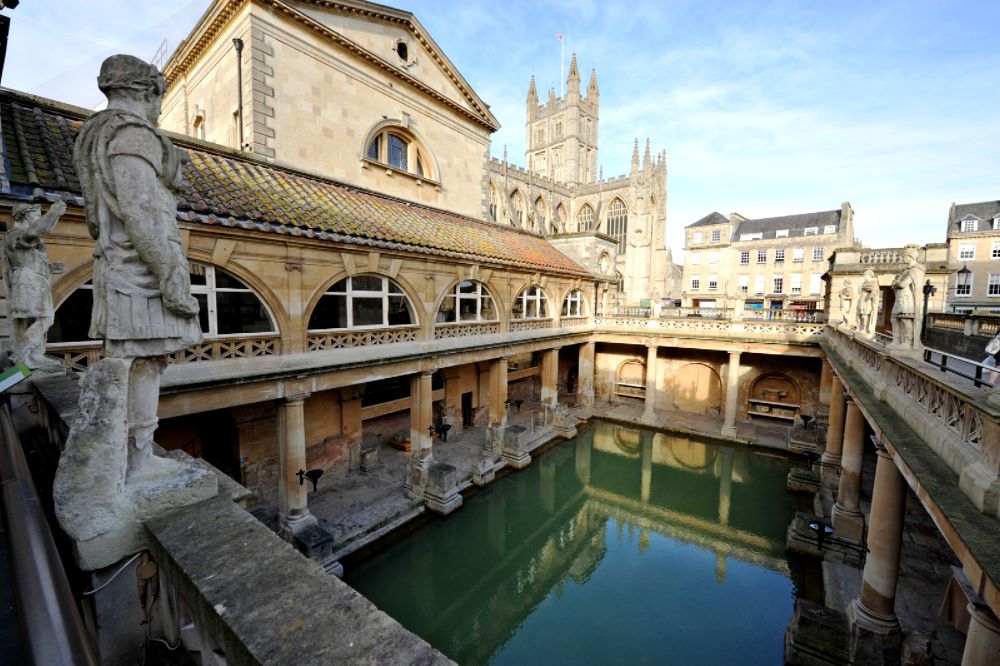
Buying Tickets for the Roman Baths
Tickets must be pre-booked in advance. The tickets range in price depending on the season. They can go from £ 17.50 in the winter to £27.50 in the summer, and they are cheaper on weekdays than weekends.
There are family ticket prices available, as well as some special deals which combine other attractions and give you a small discount.
We visited the Roman Baths on a Friday in March, which is by no means the height of the tourist season, so it was very pleasant and not crowded, but I can imagine that June to August would not afford the same leisurely visit that we had.
If you can visit outside of the high season, I would really recommend it, as you will definitely have a better viewing experience and less traffic inside the tight spaces to contend with.
Opening hours vary. The typical hours are 9am to 5pm, but each season has it’s own variation, so check the website to be sure before you go.
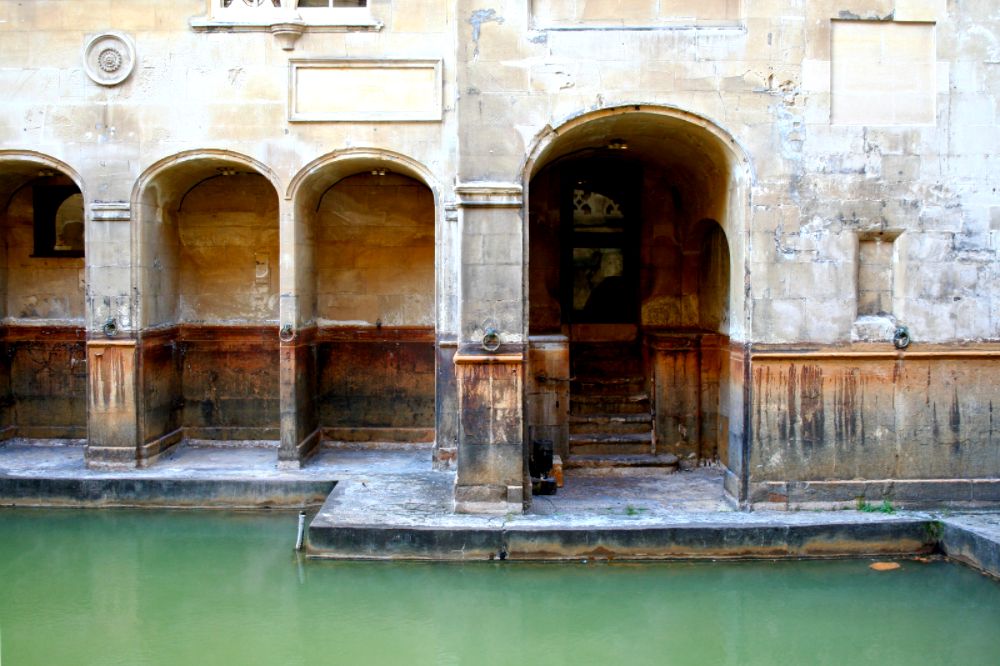
What to Do Inside
With your ticket you also receive a headset with an audio guide that you can follow around the complex. It takes about two to three hours to walk around, listening to the commentary that explains pretty much every aspect of the baths.
When you come upon something you’re interested in, you just locate the number corresponding to the commentary and punch it into your handset.
In this way, you can meander through the baths at your own pace and listen to as much or as little of the historical information as you want. It can be rewound or fast-forwarded to suit your preferences.
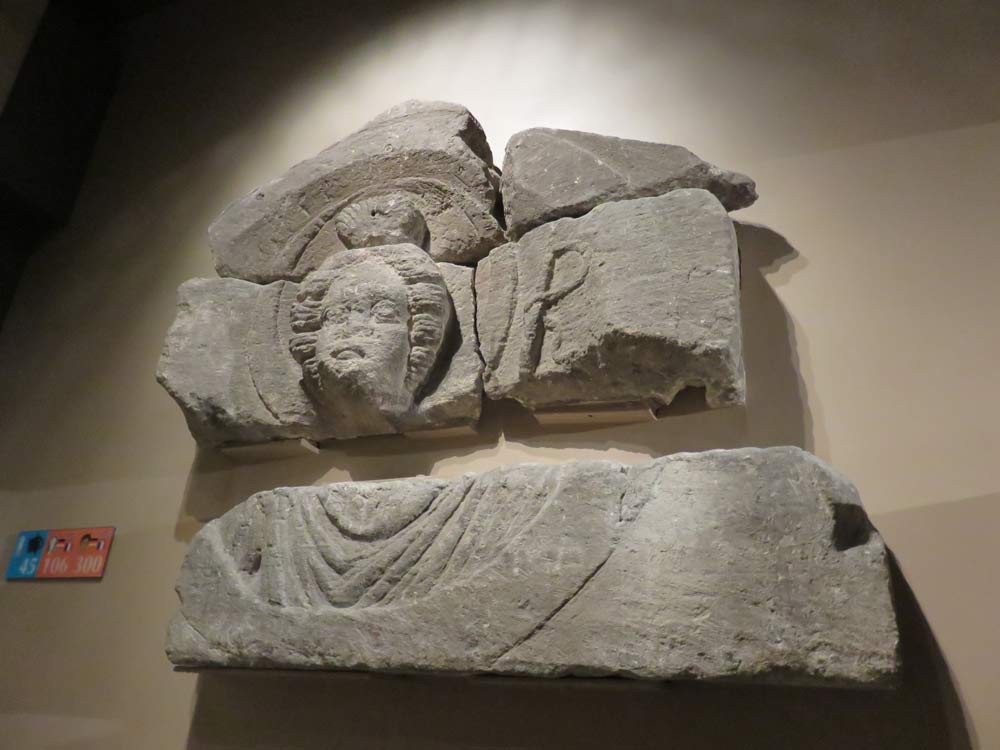
Some sections of the complex have been restructured throughout the centuries to suit the current inhabitants, and some sections have been preserved to keep them from crumbling, but with the use of a little imagination, you’ll get a very good idea what it might have looked like for the Romans who once bathed there.
The Roman Baths collection contains thousands of archaeological finds from pre-Roman and Roman Britain. The baths themselves are below the modern street level and have four main features to see:
- The Sacred Spring
- The Roman Temple
- The Roman Bath House
- Finds from Roman Bath
Steps of the Tour

- Start your tour by walking along the terrace, which overlooks the Great Bath and is lined with Victorian statues of Roman emperors and governors of Britain. This is where the best pictures can be taken, so plan to spend a bit of time here.
- You’ll then walk through parts of the museum that explain life in Roman society and the town of Aquae Sulis – the Roman name for Bath.
- Proceed through the walkway above the Temple Courtyard, and explore the area where Roman worshippers gathered to pray to the goddess Sulis Minerva.
- You’ll then walk through the sacred spring where the water for the hot springs still bubbles up today. There are many items from the springs that you can see, like coins that were made as an offering to the goddess.

- Next you will walk through the Great Bath, the centrepiece of the Roman Baths bathing complex. Surrounding the large pool are the changing rooms, saunas, heated and plunge pools that you can imagine the Romans indulging in, if you use a little imagination.
The Pump Room

Another section of the Baths is The Pump Room , which was used much the way it is today, as a separate gathering place in conjunction with the Baths – today it’s a restaurant.
It’s directly next door and can be reached easily through a set of stairs at the end of the tour. Drop off your audio headset, walk up the stairs and you’re ready for afternoon tea at The Pump Room.
Do keep in mind that The Pump Room is a very popular restaurant, so you absolutely must book ahead, even for afternoon tea.

If you’re going to be visiting Bath or the nearby area you really won’t want to miss seeing The Roman Baths. They are quite interesting and leave a lasting impression. I don’t think a trip to Bath would be complete without a visit.
A big thank you to VisitBritain for hosting our visit to Bath. See all the coverage of our trip to the south west of England . (As always, all thoughts and opinions expressed in this post are my own honest reflection on our travel experiences.)
YOU MIGHT ALSO LIKE

How to Spend 2 Days in Bath England

Visit the Thermae Bath Spa in Bath, England

7-day Itinerary in Southwest England

6 Remarkable Places to Stay in Southwest England
Be Prepared For Travel Planning is the most important part of any successful trip. Do it the easy way:
🧳 Travel Packing List | ✔️ Why You Need Travel Insurance | ✈️ What to Do Before You Leave Home
- Find and book the best hotel (our favorite booking site is Expedia)
- Research flight options (our favorite tool is Skyscanner )
- Book a tour (we always use Viator to find the best tours)
- Rent a car through Discover Cars (they search the best deals for you!)
Like this post? Why not save it to Pinterest? FOLLOW US on Pinterest , Instagram , Facebook for more great travel inspiration and tips.
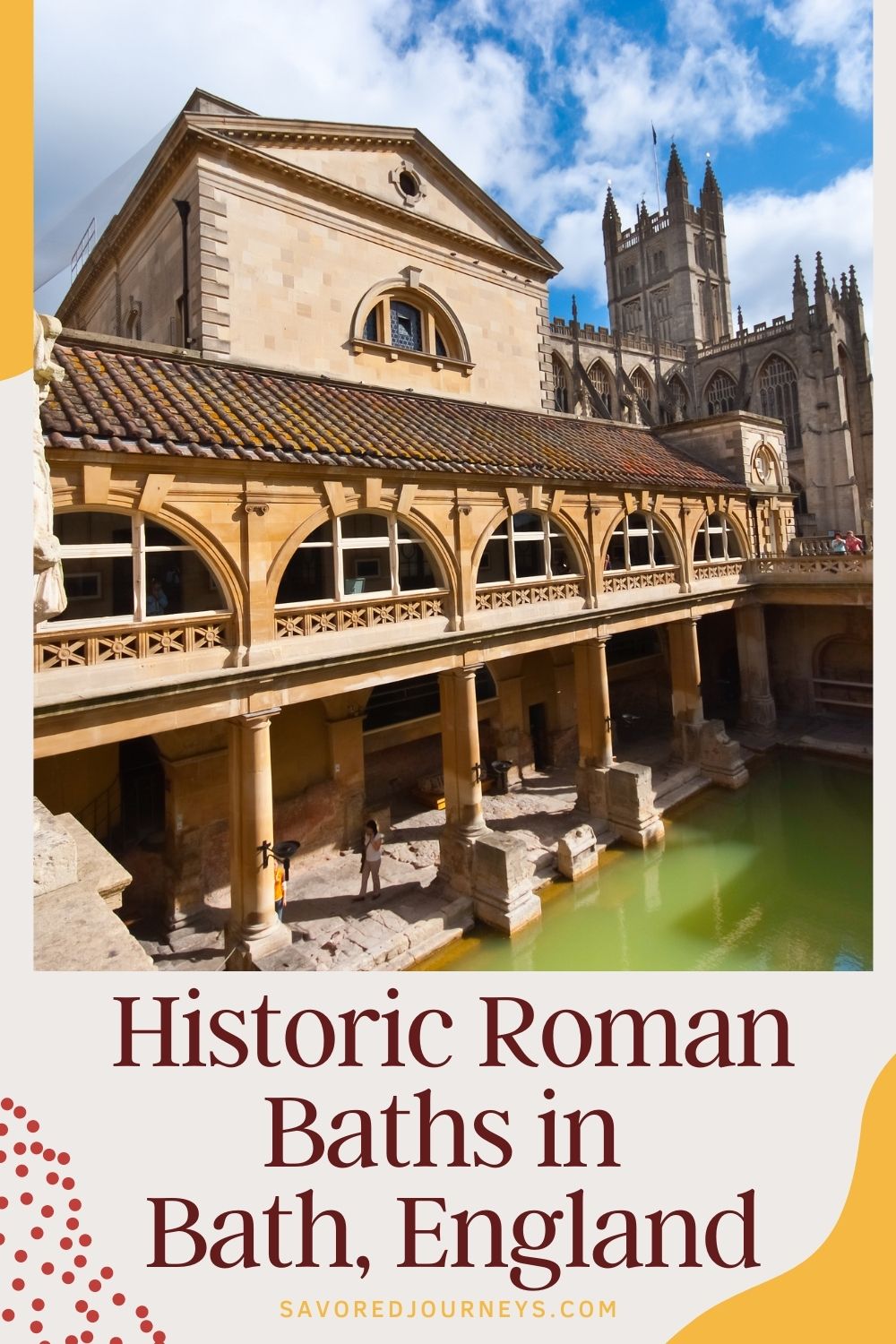
Laura Lynch, creator and writer of Savored Journeys, is an avid world traveler, certified wine expert, and international food specialist. She has written about travel and food for over 20 years and has visited over 75 countries. Her work has been published in numerous guidebooks, websites, and magazines.
19 thoughts on “ How to Visit the Historic Roman Baths in Bath, England ”
Such a great post! I would really love to visit this place one day. It’s very interesting and transports you to whole other era. Keep up the good work!
I’ve been to Bath a few weeks ago and I just LOVE this city so much! It’s so beautiful, I love the architecture and all the little shops and cafés. And so much history there as well! I haven’t been inside the baths because I only had a few days there and was actually visiting a friend. I guess I have to go back and actually experience the things Bath is so famous for 😉
I love that there are still remnants of British and Roman History dotted around the country! The baths are a true representation of a past life and it’s great that we can still visit them in all their glory! 🙂
I agree entirely, Vicki!
I’ve tried the hamam in Istanbul and Marrakech but I keep wondering if it’s the same in England! Will definitely look into this when I visit! Was this a press trip with Visit Britain?
Wow, this looks great! I have been to some Roman bath styled pool here is Czech Republic, but I guess it was not as large as this one. It must be awesome just to be soaking in the termal water now when the weather is chilly!
I really need to visit Bath! Like you mentioned, it’s quick and easy to visit from London (where I’m based). I’m thinking of using a weekend or potentially a long weekend to visit the city. Interested not only in the baths but also the architecture. Bath is a World Heritage Site which is something I really enjoy discovering and visiting.
You absolutely must check it out, Hugo! You’re so close by. Bath is a really fascinating place.
Bath is my favourite place in England and the first place I talk about when people ask me where they should visit in England. The Roman Baths are so fascinating and the whole city is just beautiful. Great post 🙂
I have been to Bath numerous times and it is among my favorite places in the UK. I loved the Roman Baths and especially afternoon tea at the Pumping Rooms they remind me of the Jane Austen books.
I missed out on visiting Bath when I was living in the UK, thank you so much for taking me there on this virtual mini tour:-).
The structures are quite old but they have this unique charm to them. I have heard a lot about these Roman Baths but I never had the chance to visit one yet.
It’s an awesome thing to see – all those old buildings. Definitely worth a visit if you get a chance!
I had heard of Bath before but just thought it was a town, never expected to see a roman bath there. Thanks for the inspiration!
It’s a pretty great town!
A roman bath in Bath, England? So fitting 🙂
Yes, quite fitting. 🙂
It’s beautiful what Romans made in their time. You should preserve it more. In Serbia we have many ruins from that time, so we should to. Hope in the future it will be more taken care, both yours and ours. Cheers From south and east Serbia!
Pingback: Soaking in the Warm Waters of Thermae Bath Spa (Bath, England) | Savored Journeys
Leave a Reply Cancel reply
Your email address will not be published. Required fields are marked *
Save my name, email, and website in this browser for the next time I comment.
- Travel Resources
Winter is here! Check out the winter wonderlands at these 5 amazing winter destinations in Montana
- Travel Destinations
How To Visit The Roman Baths In Bath, England
Published: October 26, 2023
Modified: December 28, 2023
by Minnie Emmert
- Arts & Culture
- Plan Your Trip
- Travel Tips
Introduction
Welcome to the Roman Baths in Bath, England, a fascinating historical site that takes you back in time to the ancient Roman era. Nestled in the heart of the picturesque city of Bath, the Roman Baths offer a captivating glimpse into the rich history and culture of this iconic destination.
As one of the best-preserved Roman sites in the world, the baths provide a unique opportunity to explore the remnants of Roman life from over 2,000 years ago. Whether you are a history enthusiast, an architecture lover, or simply curious about the past, a visit to the Roman Baths is an absolute must.
The Roman Baths are not only an archaeological wonder but also a significant cultural and historic landmark. The site combines stunning architecture, intricate detailing, and natural hot springs, making it a truly immersive experience for visitors.
Throughout this article, we will delve into the fascinating history of the Roman Baths, explore the different sections of the site, provide practical information for visiting, and offer some tips to make the most of your experience. So, put on your virtual toga and get ready to embark on a journey through time at the Roman Baths in Bath, England.
History of the Roman Baths
The history of the Roman Baths dates back to ancient times when the city of Bath, known as Aquae Sulis in Roman times, was a thriving spa town. The original bath complex was built in the 1st century AD, during the Roman occupation of Britain. The Romans were attracted to the area because of the natural hot springs that flowed beneath the ground.
The baths were originally constructed as a grand bathing and socializing complex. They were a place for both Romans and locals to relax, socialize, and worship the goddess Sulis Minerva, who was associated with healing and wisdom. The Roman Baths quickly became famous throughout the Roman Empire, attracting visitors from all over.
Over the centuries, the baths went through various phases of construction and expansion, with different emperors and rulers leaving their mark on the complex. The buildings were grand and opulent, showcasing the wealth and power of the Roman Empire.
However, during the decline of the Roman Empire, the baths fell into disuse and were eventually abandoned. The hot springs continued to flow, but the grand structures were left to decay and were buried beneath layers of sediment.
It wasn’t until the late 19th century that the Roman Baths were rediscovered and excavated. This led to a major restoration project, which aimed to uncover and preserve the ancient site for future generations.
Today, the Roman Baths stand as a testament to the ingenuity and engineering prowess of the ancient Romans. The site provides valuable insights into their daily life, beliefs, and cultural practices.
Visitors to the Roman Baths can explore the various sections of the complex, marvel at the stunning architecture, and learn about the rituals and traditions associated with bathing in Roman times. It is a truly immersive experience that brings history to life.
Next, let’s explore the location and opening hours of the Roman Baths, so you can plan your visit accordingly.
Location and Opening Hours
The Roman Baths are conveniently located in the center of the historic city of Bath, England. The address is Stall Street, Bath, BA1 1LZ. The site is easily accessible by public transportation, with several bus stops and a train station nearby. If you prefer to drive, there are parking facilities available in close proximity to the baths.
The opening hours of the Roman Baths vary depending on the time of year. During the peak season, which is generally from April to September, the baths are open from 9:00 AM to 6:00 PM. In the off-peak season, from October to March, the opening hours are from 9:30 AM to 5:00 PM.
It is important to note that the last entry to the Roman Baths is one hour before closing time. Therefore, it is advisable to plan your visit accordingly to allow ample time to explore the site.
The Roman Baths are open every day of the year, with the exception of December 25th (Christmas Day) and certain days when the site is closed for essential maintenance. It is recommended to check the official website or contact the site directly to confirm the opening hours and any closures before your visit.
Visitors can expect the Roman Baths to be busiest during weekends and school holidays. If you prefer a quieter and more relaxed experience, it may be advisable to visit on weekdays or during less busy periods. Additionally, visiting early in the morning or later in the day can also help avoid the crowds.
Now that you know the location and opening hours of the Roman Baths, let’s move on to ticketing and entry fees.
Ticketing and Entry Fees
To experience the wonders of the Roman Baths, visitors are required to purchase an entry ticket. The ticket prices vary depending on age, with discounted rates available for children, students, and seniors.
It is recommended to book your tickets in advance, especially during peak tourist seasons, as the Roman Baths can get quite busy. You can conveniently purchase your tickets online through the official website or opt to buy them on-site at the ticketing desk.
The entry fees for the Roman Baths include access to all areas of the site, including the Great Bath, the Terrace and Museum, the Sacred Spring, the Roman Temple, and the Roman Bath House. Guided audio tours are also available for an additional cost, providing insightful commentary and enriching your visit with historical information.
For visitors who plan to explore other attractions in Bath, it may be worth considering a combination ticket. These combination tickets offer access to multiple sites, allowing you to immerse yourself in the fascinating history of Bath at a discounted rate.
Children under the age of 6 can enter the Roman Baths for free, but they must be accompanied by a paying adult. Families visiting with young children will find convenient facilities such as baby changing stations and stroller-friendly paths throughout the site.
If you have any specific accessibility requirements, it is advisable to contact the Roman Baths in advance to ensure that your needs can be accommodated. The site offers wheelchair access to most areas, and there are accessible toilets available for visitors with disabilities.
Now that you know how to obtain tickets and the associated entry fees, let’s explore the various sections of the Roman Baths in detail, starting with the iconic Great Bath.
The Great Bath
The centerpiece of the Roman Baths is undoubtedly the Great Bath, a stunning pool of hot spring water that served as the main bathing area for the Romans. This grand structure is a testament to the engineering prowess of the ancient Romans and showcases their mastery in creating luxurious bathing facilities.
The Great Bath is a rectangular pool, lined with beautiful Roman tiles and supported by a series of arches. The water, heated by the natural hot springs, reaches temperatures of around 46 degrees Celsius (115 degrees Fahrenheit). As you stand on the walkway that surrounds the Great Bath, you can admire the steam rising from the water and imagine the scenes of socializing and relaxation that once took place here.
During your visit, you will have the opportunity to learn about the rituals and beliefs associated with bathing in Roman times. You can explore the interactive displays and exhibits that provide insights into the religious significance of the hot springs and the practices of the Romans who frequented the baths.
One particularly noteworthy feature of the Great Bath is the Gorgon’s Head, a stone carving of the face of Medusa. This striking and intricate carving is believed to have served a protective function, warding off evil spirits and ensuring the well-being of those who bathed in the waters.
As you wander around the Great Bath, you will also come across remnants of Roman statues and artifacts that have been uncovered during the excavation of the site. These artifacts offer a glimpse into the opulence and grandeur of the baths during their heyday.
Whether you are fascinated by ancient architecture, interested in the therapeutic properties of hot springs, or simply intrigued by the daily lives of the Romans, the Great Bath is a captivating attraction within the Roman Baths complex.
Next, let’s explore the Terrace and Museum, where you can further immerse yourself in the history of the baths and view a remarkable collection of artifacts.
The Terrace and Museum
Adjacent to the Great Bath, the Terrace and Museum offer a wealth of historical treasures and fascinating exhibits that provide deeper insights into the Roman Baths.
The Terrace, a raised promenade that overlooks the Great Bath, provides panoramic views of the entire complex. From this vantage point, you can admire the grandeur of the bathhouse and gain a better understanding of its layout. The Terrace also offers an opportunity to take stunning photos and capture the beauty of the Roman Baths.
Inside the Museum, you will find an impressive collection of artifacts that have been unearthed during the excavation and restoration of the Roman Baths. These artifacts showcase the skills of Roman craftsmen, as well as shedding light on the daily life and culture of the Romans.
Among the highlights of the museum’s collection are intricate mosaics, beautifully preserved Roman statues, and ancient coins. These artifacts are accompanied by informative displays and interactive exhibits that offer historical context and allow you to delve deeper into the stories behind the objects.
The Terrace also provides access to the sacred spring, the natural hot spring that supplies the waters of the Roman Baths. Enclosed within a protective structure, the sacred spring is a reminder of the spiritual significance the Romans attached to the site. As you gaze upon the steaming, mineral-rich water, you can imagine the awe and reverence it must have inspired in the ancient visitors.
Throughout the Terrace and Museum, knowledgeable staff members are available to answer any questions you may have and provide additional information about the history and significance of the Roman Baths. Don’t hesitate to engage with them and enhance your understanding of this remarkable site.
After exploring the Terrace and the Museum, make sure to take a stroll along the original Roman pavements, which lead you to the next section of the Roman Baths: the Sacred Spring.
Next, let’s delve into the fascinating history and significance of the Sacred Spring at the Roman Baths.
The Sacred Spring
The Sacred Spring is the heart and soul of the Roman Baths, as it is the source of the natural hot springs that have attracted visitors for thousands of years. This sacred spring provided the Romans with not only a luxurious bathing experience but also a spiritual connection to the goddess Sulis Minerva.
As you approach the Sacred Spring, you will encounter a beautifully preserved Roman archway known as the Archway of the Temple Precinct. This archway leads you to the Temple Courtyard, which was once a bustling hub of religious activity.
Within the Temple Courtyard, you will find the remains of the Temple of Sulis Minerva, the goddess to whom the Romans dedicated the spring. This sanctuary was believed to have healing powers, and visitors would come to make offerings and seek blessings from the goddess.
The Sacred Spring itself is a magnificent sight to behold. Steaming hot water emerges from beneath the ground, creating a shimmering pool that symbolizes the life-giving force of the spring. The water is filled with minerals that are believed to have therapeutic properties, and the Romans considered bathing in this holy water to be a form of purification and rejuvenation.
Adjacent to the Sacred Spring, you will find informative displays and interactive exhibits that explain the religious significance of the spring and the rituals that were performed by the Romans. These displays provide a deeper understanding of the spiritual beliefs and practices of the time.
As you explore the Sacred Spring, take a moment to marvel at its natural beauty and contemplate the centuries of history that have unfolded here. The atmosphere is serene and peaceful, making it an ideal spot for reflection and appreciation of the Roman’s reverence for the divine power of water.
After visiting the Sacred Spring, continue your journey through the Roman Baths by exploring the Roman Temple, an area where the Romans would have come to make offerings and seek divine favor.
Next, let’s discover the history and significance of the Roman Temple within the Roman Baths complex.
The Roman Temple
The Roman Temple, located within the Roman Baths complex, was an important place of worship and religious activity for the Romans who visited the site. This temple was dedicated to the goddess Sulis Minerva, a deity combining Roman and Celtic elements, and was a central part of the Roman Baths’ cultural and spiritual significance.
The Roman Temple was constructed in grand proportions, showcasing the architectural prowess of the Romans. Although only fragments of the original temple remain, you can still get a sense of its former magnificence. The surviving pieces include intricate stone carvings and decorative elements that provide clues about the temple’s design and the artistic style of the era.
Visitors to the Roman Temple can explore the remains of the temple precinct, which included open courtyards, altars, and other structures used for religious ceremonies and offerings. This area was intended to create a sense of awe and reverence, invoking the presence and power of the goddess Sulis Minerva.
One notable feature of the Roman Temple is the Sacred Pool, a small basin adjacent to the temple. This pool would have been used for ritual cleansing before entering the temple and partaking in religious ceremonies.
As you wander through the Roman Temple, take a moment to appreciate the cultural significance of this site. Imagine the Romans, clad in their togas, coming to seek the favor of the goddess, offering prayers and sacrifices in the hopes of receiving blessings and healing.
The Roman Temple provides a remarkable glimpse into the spiritual practices and beliefs of the Romans. It is a testament to their devotion to Sulis Minerva and their desire to connect with the divine in this sacred place.
After exploring the Roman Temple, it’s time to venture into the next section of the Roman Baths: the Roman Bath House, where you can learn more about the daily rituals and activities that took place within its walls.
Let’s continue our journey through the Roman Baths by exploring the fascinating history of the Roman Bath House.
The Roman Bath House
The Roman Bath House was the heart of everyday life at the Roman Baths. It was a sprawling complex of rooms and chambers that served various purposes, catering to the needs of the visitors who came to bathe, socialize, and indulge in the luxuries offered by the baths.
Upon entering the Roman Bath House, you would have been greeted by a series of changing rooms known as the Apodyterium. Here, visitors would disrobe and leave their belongings before proceeding to the bathing areas.
The next section of the bathhouse was the Tepidarium, a warm room where visitors would acclimatize to the higher temperatures before entering the hot bath areas. This room was designed to gradually increase the body’s exposure to heat and prepare it for the therapeutic and relaxing experience that lay ahead.
From the Tepidarium, visitors would move on to the Caldarium, the hot room of the bathhouse. Here, they would soak in the hot waters of the baths, allowing the heat to relax their muscles and cleanse their bodies. The Caldarium was heated by a sophisticated system of underfloor heating known as a hypocaust, which circulated warm air and warm water through the floors and walls.
Adjacent to the Caldarium was the Frigidarium, the cold room of the bathhouse. This room provided a refreshing contrast to the heat of the Caldarium and was often accompanied by a plunge pool or fountain for a quick exhilarating dip.
Throughout the bathhouse, visitors would have access to a network of interconnected rooms, including the Laconicum (a dry sweating room), the Palaestra (an exercise area), and various communal spaces where they could socialize, relax, and engage in leisure activities.
The Roman Bath House was not only a place for bathing and relaxation but also a hub of social interaction. It was a meeting place where people from all walks of life would gather to exchange news, engage in conversations, and establish connections.
As you explore the Roman Bath House, you can appreciate the intricate architectural details, such as beautifully preserved mosaics and intricate stonework, which adorned the walls and floors of the different rooms. These elements showcase the skill and craftsmanship of the Roman builders.
The Roman Bath House offers a glimpse into the daily lives of the Romans and their appreciation for the therapeutic and social aspects of bathing. It is a testament to the advanced engineering and design principles of the time.
Now that we have explored the different sections of the Roman Baths, let’s transition to the next section of our article, where we will discuss the Roman Baths in modern times and their significance as a cultural and historical landmark.
The Roman Baths in Modern Times
Today, the Roman Baths continue to captivate and inspire visitors from around the world. As a UNESCO World Heritage site, they are recognized for their historical and cultural significance, offering a window into the rich heritage of Bath and the Roman Empire.
The Roman Baths have undergone extensive restoration to preserve their original grandeur and architectural beauty. The site’s preservation and ongoing excavation work have allowed archaeologists and historians to uncover valuable insights into Roman life, from the social customs of bathing to the religious practices associated with the hot springs.
Visitors to the Roman Baths can explore the various sections of the complex, immersing themselves in the atmosphere of ancient Roman times. The combination of well-preserved structures, informative displays, and interactive exhibits provides a captivating experience that brings history to life.
In addition to the historical significance, the Roman Baths have become an iconic symbol of Bath itself. The picturesque setting, with the ancient buildings and steaming waters, creates a unique and memorable backdrop for visitors.
Throughout the year, the Roman Baths host various events and activities, such as guided tours, music performances, and even torchlit summer evening visits, enhancing the visitor experience and offering a different perspective on this remarkable site.
The Roman Baths also boast a modern visitor center, equipped with amenities including a gift shop, a café, and educational resources. These facilities ensure that visitors have a comfortable and enjoyable visit, with the opportunity to learn more about the history and significance of the baths.
Beyond its historical value, the site also serves as an educational resource, offering school programs and workshops to engage students and promote understanding of the Roman era. The Roman Baths have become an important resource for scholars, archeologists, and researchers studying ancient civilizations.
As Bath’s most iconic attraction, the Roman Baths draw visitors from all over the world, contributing to the local economy and cultural vibrancy of the city. The baths are a testament to the enduring power of history and the fascination with ancient civilizations.
As you walk through the Roman Baths and soak in the atmosphere of this ancient site, you can’t help but be transported back in time. It’s a truly immersive experience that highlights the legacy of the Romans and their enduring influence on Bath and the world.
Now that we have explored the Roman Baths in modern times, let’s move on to some practical tips for visiting this remarkable historical site.
Tips for Visiting the Roman Baths
Visiting the Roman Baths in Bath, England is an experience that should be planned and prepared for. To make the most of your visit, consider the following tips:
- Plan your visit in advance : Check the official website for any updates on opening hours, ticket availability, and any special events happening during your visit. Booking your tickets online in advance can help you avoid long queues at the ticketing desk.
- Visit during off-peak hours : If possible, plan your visit during weekdays or in the early morning or late afternoon to avoid crowds. This will allow you to explore the site at a more relaxed pace.
- Wear comfortable shoes : The Roman Baths comprise a large area to explore, including multiple sections with different flooring surfaces. Ensure you wear comfortable shoes to navigate the site comfortably.
- Allow ample time : The Roman Baths are a place worth exploring thoroughly. Allocate sufficient time to explore all the sections, read the informational displays, and immerse yourself in the history and atmosphere of the site.
- Consider taking a guided tour or audio guide : To enhance your understanding of the Roman Baths and gain deeper insights into its history, consider joining a guided tour or using an audio guide. These resources provide fascinating details and context about the different areas of the baths.
- Bring a camera : The Roman Baths offer numerous photo opportunities, from the grand architecture to the steaming waters. Capture the beauty and history of the site through photographs, but be mindful of any photography restrictions that may apply.
- Bring a reusable water bottle : Exploring the Roman Baths can be thirsty work. To stay hydrated, bring a refillable water bottle. There are water fountains available throughout the site where you can fill up your bottle.
- Respect the site : As you explore the Roman Baths, be mindful of the historical significance and cultural importance of the site. Follow any guidelines and rules to help preserve and protect this ancient monument for future generations.
- Take your time at the end of your visit : After your exploration, take a moment to relax and reflect in one of the cafés or sitting areas near the Roman Baths. Contemplate the wonders you have discovered and soak in the atmosphere of this historical gem.
By following these tips, you can ensure a memorable and enjoyable visit to the Roman Baths, allowing you to fully appreciate the historical and cultural significance of this iconic site.
And with that, we come to the end of our journey through the Roman Baths in Bath, England. We hope you found this article informative and inspiring, and that it has piqued your curiosity to discover more about this captivating historical treasure.
Enjoy your visit to the Roman Baths and embrace the opportunity to step back in time to the days of the ancient Romans.
Safe travels!
The Roman Baths in Bath, England, offer a remarkable journey into the past, where you can immerse yourself in the rich history and culture of the ancient Romans. From the grandeur of the Great Bath to the intricate remains of the Roman Temple, the baths provide a captivating experience that transports you back to a time of opulence and indulgence.
As you explore the different sections of the Roman Baths, you will gain insights into the daily life, religious practices, and social dynamics of the Romans who once frequented these hallowed grounds. The beautifully preserved structures, informative displays, and interactive exhibits allow you to truly appreciate the historical and cultural significance of this UNESCO World Heritage site.
Visiting the Roman Baths requires careful planning and attention to detail. By following the tips provided, you can make the most of your visit, ensuring a memorable and enjoyable experience. From booking your tickets in advance to allowing ample time for exploration and contemplation, these tips will help you navigate the site with ease and fully appreciate its wonders.
The Roman Baths serve as a reminder of the enduring legacy of the Roman Empire and their contributions to architecture, engineering, and culture. By visiting this iconic destination, you are not only connecting with the past but also embracing the opportunity to be a part of a living history, where the age-old tradition of bathing and relaxation continues to be cherished to this day.
Whether you are a history enthusiast, a lover of architecture, or simply seeking a unique and enriching experience, the Roman Baths in Bath, England, offer a journey through time that will leave a lasting impression. So, don your metaphorical toga and set forth on an unforgettable adventure to discover the wonders of the ancient world at the Roman Baths.
Safe travels and enjoy your exploration of this remarkable historical site!

- Privacy Overview
- Strictly Necessary Cookies
This website uses cookies so that we can provide you with the best user experience possible. Cookie information is stored in your browser and performs functions such as recognising you when you return to our website and helping our team to understand which sections of the website you find most interesting and useful.
Strictly Necessary Cookie should be enabled at all times so that we can save your preferences for cookie settings.
If you disable this cookie, we will not be able to save your preferences. This means that every time you visit this website you will need to enable or disable cookies again.

Visiting the Roman Baths in Bath, England
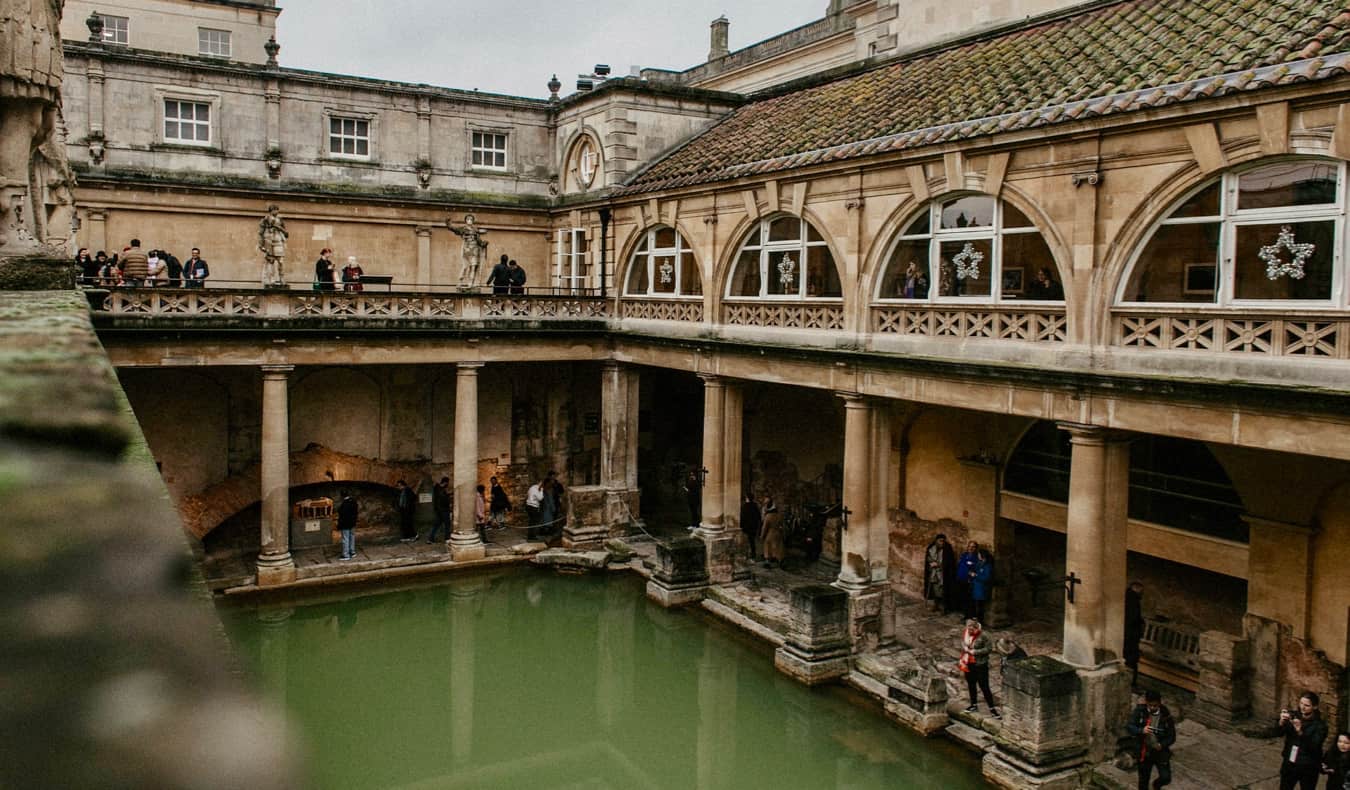
Originally built centuries ago by the Romans as a spa/bath retreat, Bath is still one of the most beautiful, historic, and visited cities in England .
The Romans came here when they invaded Britain because of the hot springs that bubble up from the earth. The local people thought this place had spiritual significance, and when the Romans came, they felt the same and dedicated this site to Minerva, the goddess of wisdom. Despite being on the edge of the frontier, the city grew to become a major religious and cultural center. People came from all around to pray to Minerva and use the baths, which they believed had special healing powers.
After the Roman Empire crumbled, so too did the baths of Bath. Over the centuries, the Roman structure collapsed and the city was built over them. Medieval leaders eventually constructed their own baths, and pilgrims came to the hot springs in order to be healed of various ailments. Time and construction hid the original Roman structure, a new spa was constructed nearby, and life in Bath went on.
In the early 19th century, the owners of the house on top of the original baths hired a crew to find the source of water leaks and stumbled upon the ancient structure. Subsequent digging revealed the whole complex, and soon excavations were underway to unearth this historic treasure.
Today, most of the structure has been unearthed, though archaeologists suspect there are still a few more buildings in the area.
Now, everyone wants to visit Bath to check out these ancient Roman baths in England! It’s the most popular thing to do here.
The ancient Roman baths are inspiring. Since the city is built on top of them, you enter from street level, where a terrace lets you look down into the baths, which are over six feet below the ground. The preservation techniques employed here are excellent, and this is one of the best-preserved Roman sites I’ve ever seen.
The audio tour, which is narrated by famed travel writer Bill Bryson , gives an amazing level of detail and information. The displays do a wonderful job of explaining the history of Bath, the Roman occupation, the significance behind all the artifacts, and the excavation process. I always hate walking away from historic sites with questions, but Bath’s displays and audio tour are so complete that I had none.
I’m always amazed by Roman engineering, especially their sewer and aqueduct system. It’s amazing that a people primitive in so many ways could build piping, heating, and sewer systems that were so complex. The history geek in me finds it all fascinating.
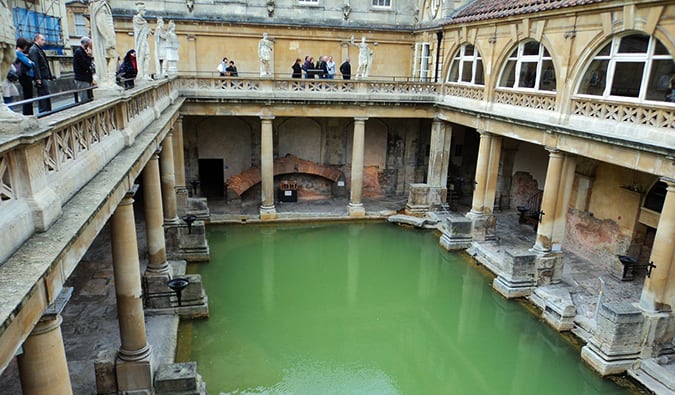
The city’s allure isn’t just the Roman baths, though, but also the historic abbey, where famed philosopher Thomas Malthus is entombed. Plus, the town is beautiful, and most of the buildings are as they appeared a few centuries ago. I don’t know what architectural style they’re built in, but if I had to guess, I’d say “pretty.”
One of the real highlights for me was the river in town. Parks line the Avon River, and people lounge out with picnics as the famous Pulteney Bridge overlooks a little cascade in the river. The bridge is covered with shops and reminded me of the covered bridges in Florence.
Salisbury is still the most beautiful city I’ve seen in England, but Bath is a close runner-up.
All over England , people kept telling me, “Ohh, you’ll like Bath. It’s really nice.” They were right. The only thing I didn’t like was my camera battery dying halfway through my trip, leaving me far short of all the pictures I would have taken. Bath is a real gem.
How to Get to Bath, England
For a day trip, trains run from London take around 90 minutes. One-way fares start around 40 GBP. Buses from London take about 2hrs 30min and cost around 10 GBP each way.
If you have a car, it’s about a 2hr 30min drive from London. Use Discover Cars if you want to rent a vehicle. They have the best selection and prices.
If you’re coming from nearby Bristol, the trip is only around 30 minutes by car. Trains from Bristol run regularly and take around 15 minutes, costing 10 GBP each way.
How to Visit the Roman Baths in England
The Roman Baths are right in the center of Bath on Stall St. The entrance is in Abbey Church Yard. Opening hours vary depending on the season so check the website for an up-to-date schedule (they are generally open from 9am-5pm, however, with extended hours in the summer).
Admission costs 27.50 GBP on weekends and 25.50 GBP on weekdays. Audio guides are free.
For a more detailed experience, take a guided walking tour around the city with Get Your Guide . You’ll learn a ton about the city and have a much more in-depth experience before you explore the baths.
Get Your In-Depth Budget Guide to Europe!

My detailed 200+ page guidebook is made for budget travelers like you! It cuts out the fluff found in other guides and gets straight to the practical information you need to travel while in Europe. It has suggested itineraries, budgets, ways to save money, on and off the beaten path things to see and do, non-touristy restaurants, markets, bars, safety tips, and much more! Click here to learn more and get your copy today.
Book Your Trip to Bath: Logistical Tips and Tricks
Book Your Flight Use Skyscanner to find a cheap flight. They are my favorite search engine because they search websites and airlines around the globe so you always know no stone is left unturned.
Book Your Accommodation You can book your hostel with Hostelworld as they have the biggest inventory and best deals. If you want to stay somewhere other than a hostel, use Booking.com as they consistently return the cheapest rates for guesthouses and cheap hotels. My two favorite places to stay here are:
- St. Christopher’s Inn
Don’t Forget Travel Insurance Travel insurance will protect you against illness, injury, theft, and cancellations. It’s comprehensive protection in case anything goes wrong. I never go on a trip without it as I’ve had to use it many times in the past. My favorite companies that offer the best service and value are:
- Safety Wing (for everyone below 70)
- Insure My Trip (for those over 70)
- Medjet (for additional repatriation coverage)
Looking for the Best Companies to Save Money With? Check out my resource page for the best companies to use when you travel. I list all the ones I use to save money when I’m on the road. They will save you money when you travel too.
Got a comment on this article? Join the conversation on Facebook , Instagram , or Twitter and share your thoughts!
Disclosure: Please note that some of the links above may be affiliate links, and at no additional cost to you, I earn a commission if you make a purchase. I recommend only products and companies I use and the income goes to keeping the site community supported and ad free.
Related Posts

GET YOUR FREE TRAVEL STARTER KIT
Enter your email and get planning cheatsheets including a step by step checklist, packing list, tips cheat sheet, and more so you can plan like a pro!


The Roman Baths in Bath – what to see when you visit
The Roman Baths in Bath are one of the city’s unique attractions and the number one thing to see in this charming UNESCO World Heritage city. A hot spring was enclosed in the 2nd century AD, the Romans built their temple to the Goddess Sulis Minerva here, and fashionable Georgian society flocked in the 18th century to take the waters.
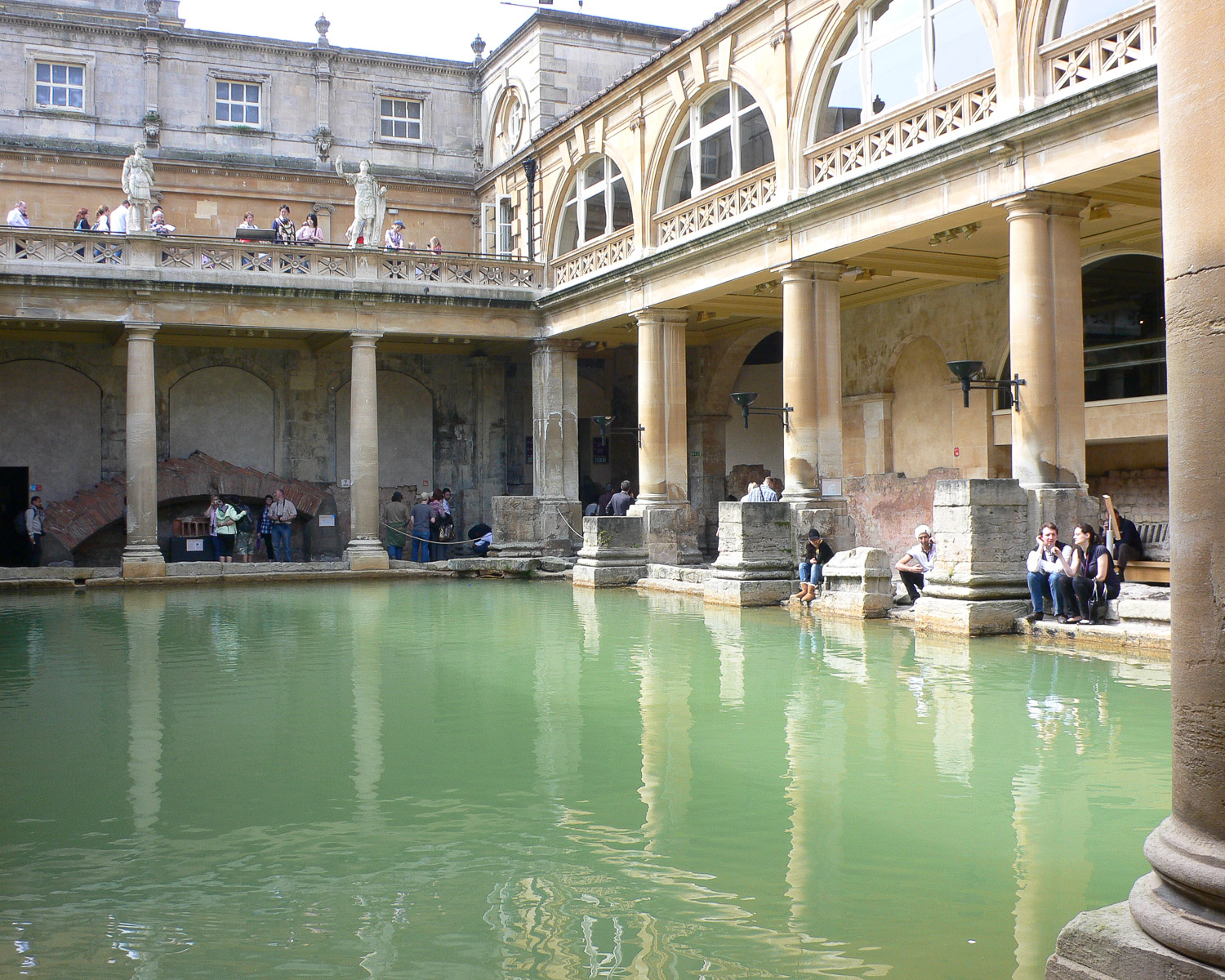
As a local living nearby in Bristol, the Roman Baths are the first place I take visitors when we have a day out in Bath.
This article may contain affiliate links that provide commission on purchases you make at no extra cost to you. As an Amazon Associate I earn from qualifying purchases.
Table of Contents
The baths in Roman times
Hot baths built over a natural spring existed well before Roman times and were enclosed in the 2nd century AD. They become the focal point for worship at the temple of the Goddess of healing, Sulis Minerva.
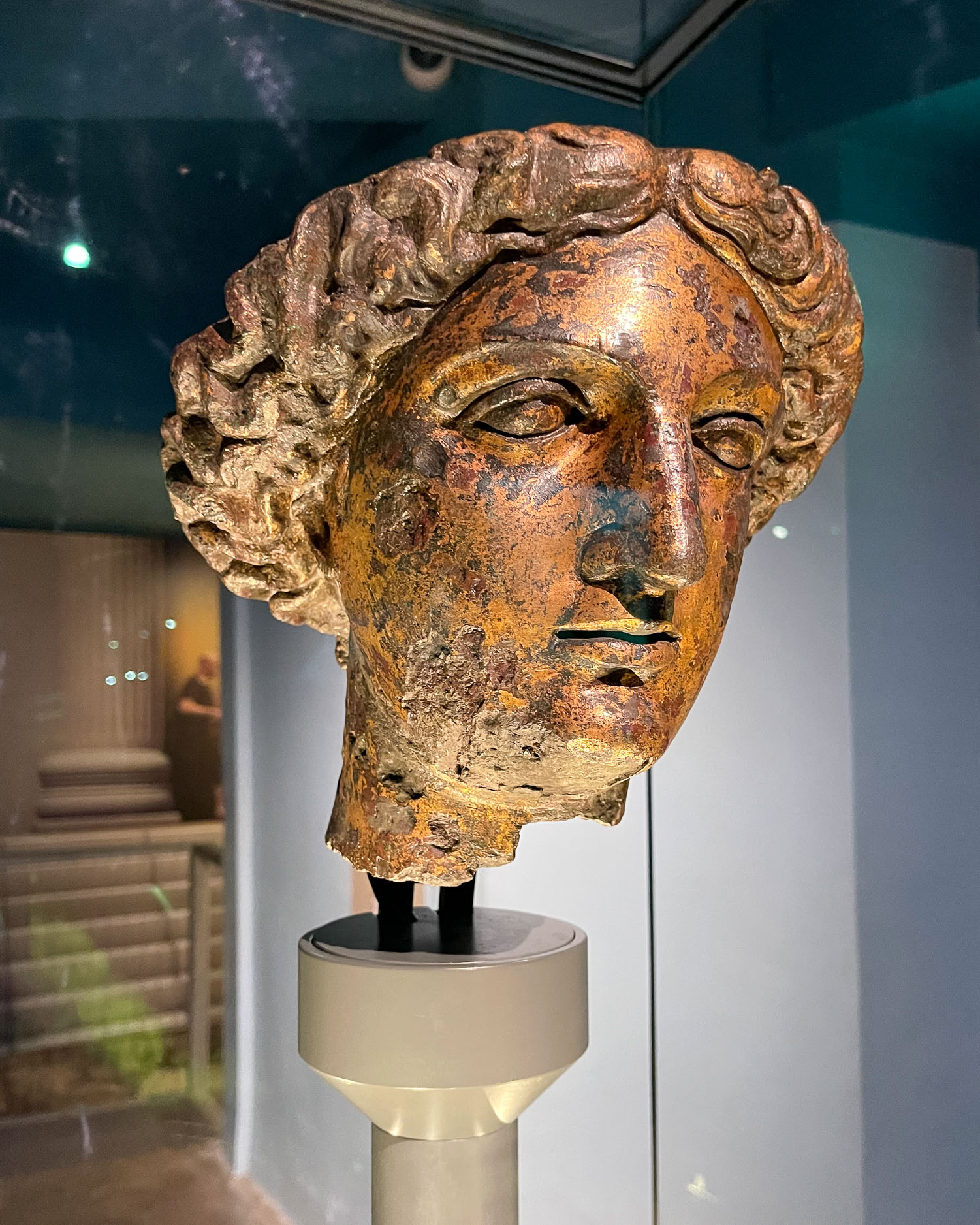
The Roman Baths that grew up were unusual for their size and for the amount of hot water that was freely available. Most baths around the Roman Empire used smaller plunge pools and a limited amount of hot water, since heating water was expensive.
The baths were a cross between a public leisure centre and a site of devotion to the Goddess, with a temple courtyard and altar next to the spring.
Sitting in the centre of the city, the Roman Baths are now surrounded by the cathedral and shops. Originally they stretched over a much larger area and some of the remains are under the level of the surrounding streets.
Also read my article: 21 Best things to do in Bath – a local’s guide
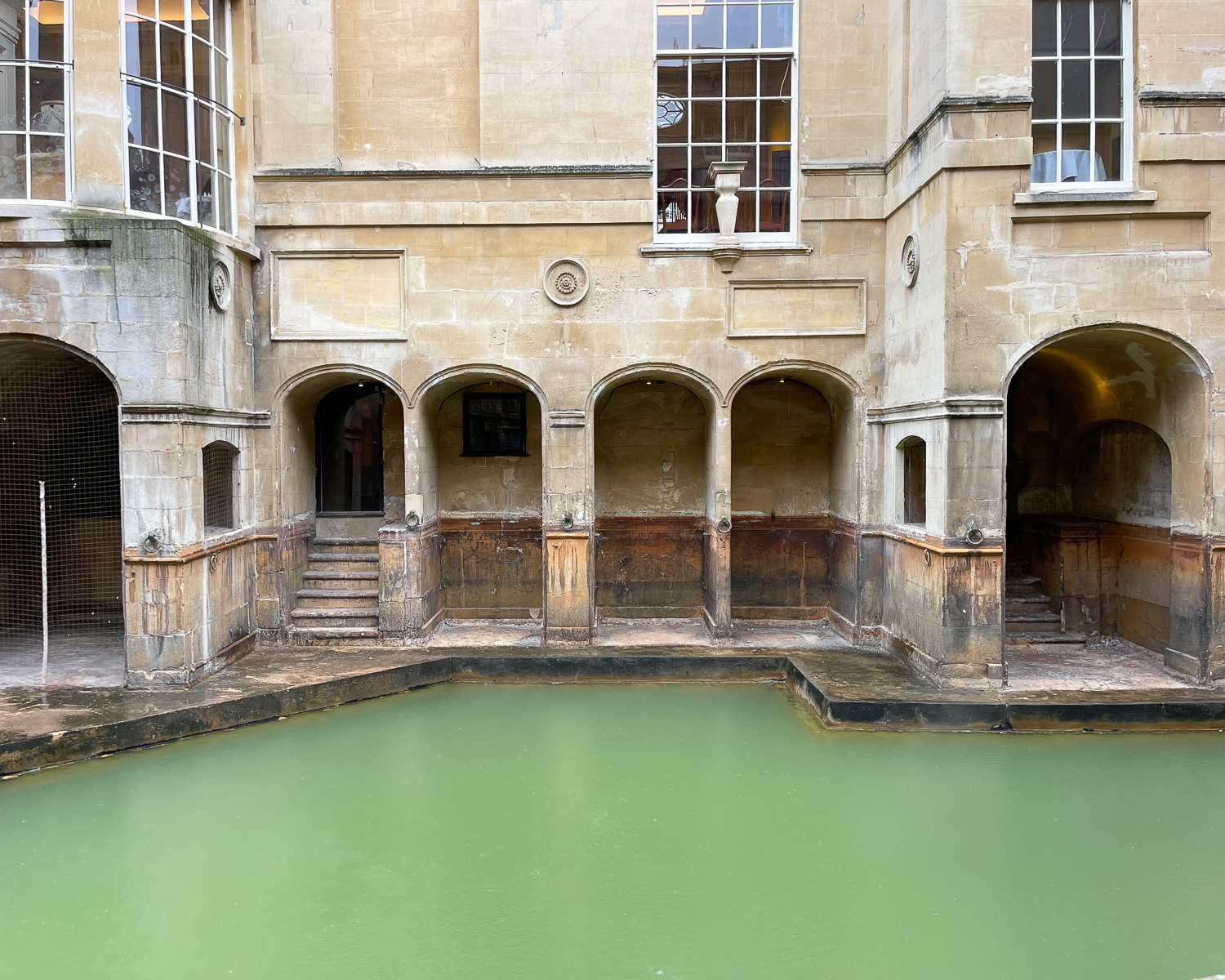

The Baths in the 18th and 19th century
In the 18th century the Grand Pump room was built next to the main spring as a place where people could socialise and taste the health-giving spring water. These fashionable visits to Bath mentioned frequently in the novels of Jane Austin.
During the 19th century the wider extent of the Roman Baths were uncovered, the columns and statues of the Great Bath reconstructed and the baths reopened to the public in 1897.
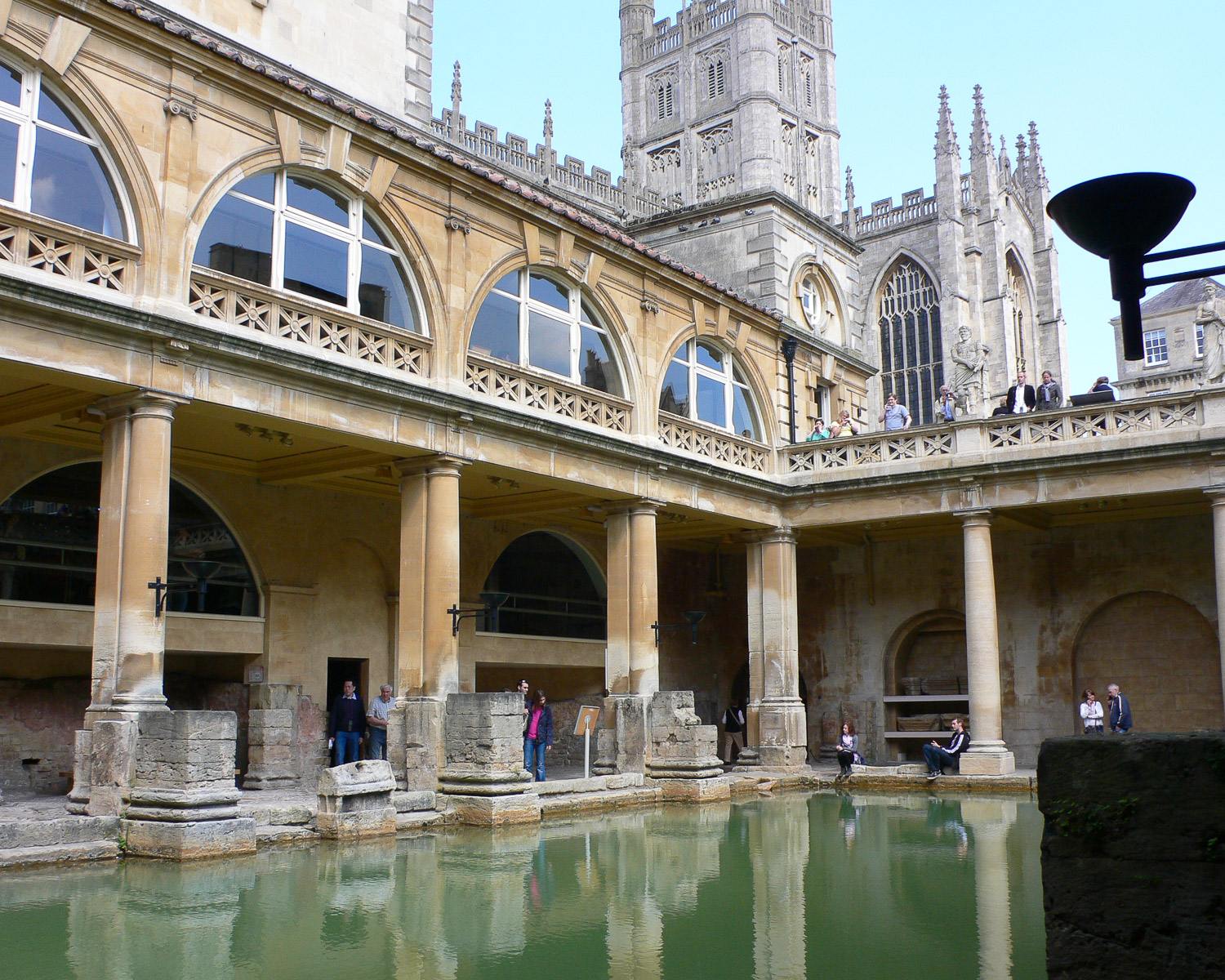
A Tour of the Roman Baths in Bath
As you enter the bath complex you are given an audio guide that can play in several languages. The tour can be stopped and started at each point on the tour which worked well and allowed everything to go at their own pace.
At certain points there is commentary designed for children and also reflections by travel writer Bill Bryson on his experience of the baths.
Where to stay in Bath – discover the best hotels and neighbourhoods
The Great Baths and King’s Bath
The starting point for the tour of the Baths is the terrace above the Great Baths, which was created in 1897 when the baths were re-opened with imposing statues of Roman Emperors who had connections with England.
Moving around, you can get a view of the other different baths in the complex, including the smaller original King’s Bath. This was a mysterious, sacred place containing the original spring water, steaming and gently bubbling like the whisper of the goddess.
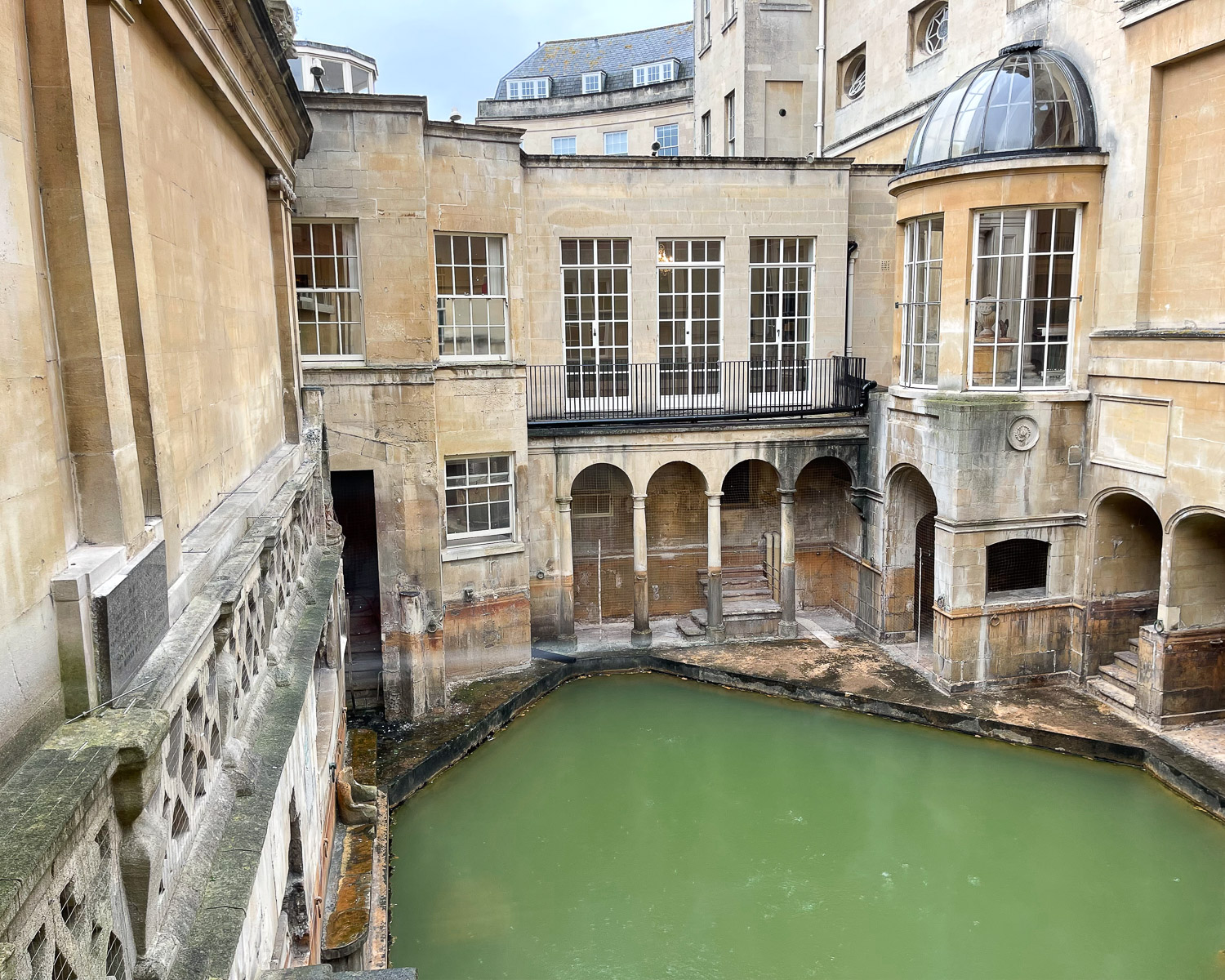
Into this pool, prayers or curses, written on small lead tablets were often thrown to ask for the goddess’s help. Listen for the voices of the angry plaintiffs across the century requesting punishment for the person who had stolen their cloak or other possessions.
Read my article: 18 Exciting museums to visit in Bath
Roman Remains at the Baths
The remnants of the carved stone pediment of the temple have been constructed with a central Gorgon’s head looking more ancient Briton than Roman.
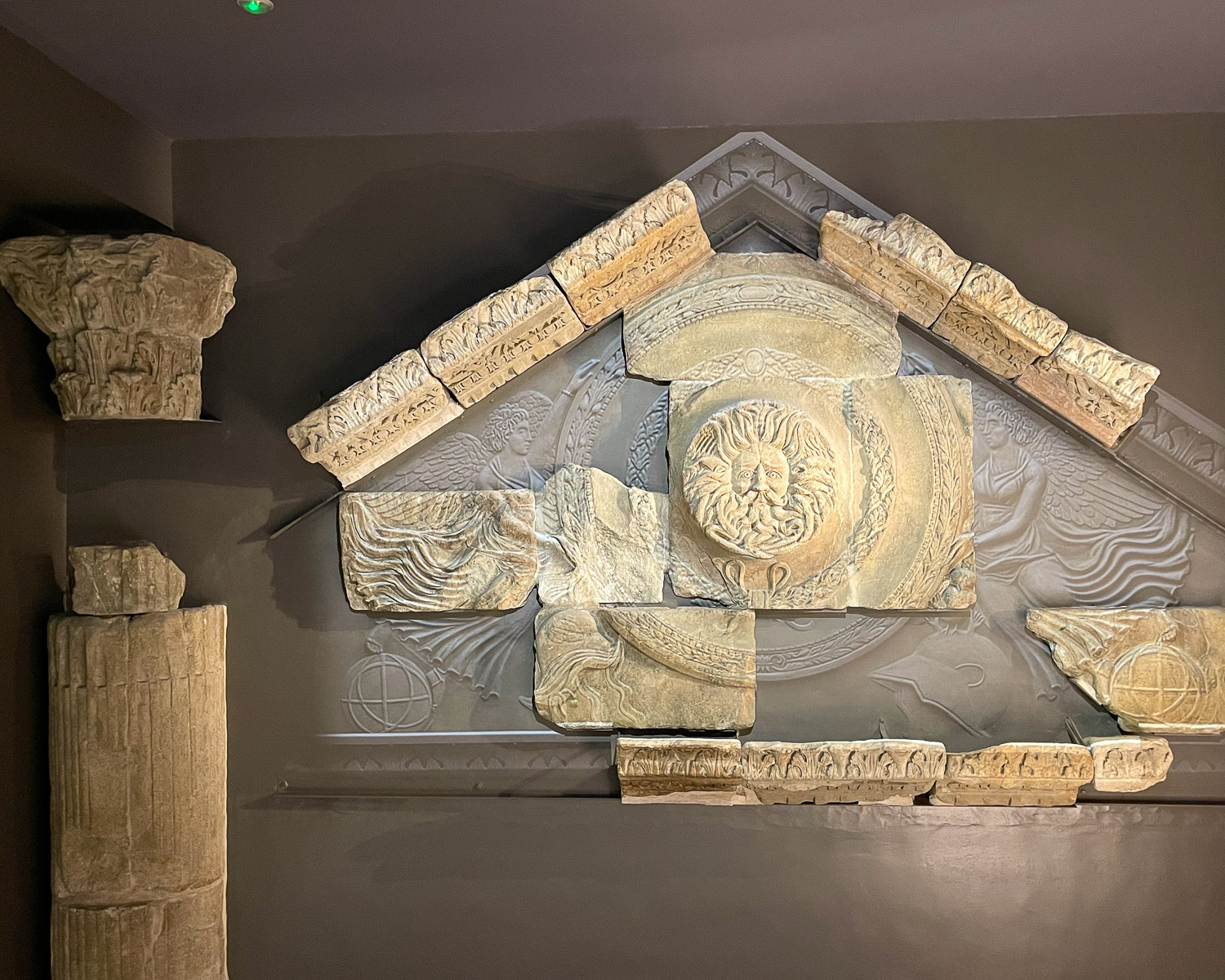
Later in the tour you reach the Roman level of the baths to walk around the original temple courtyard At this lower level is the original Roman brick overflow for the spring which channeled the water away to discharge in the nearby River Avon.
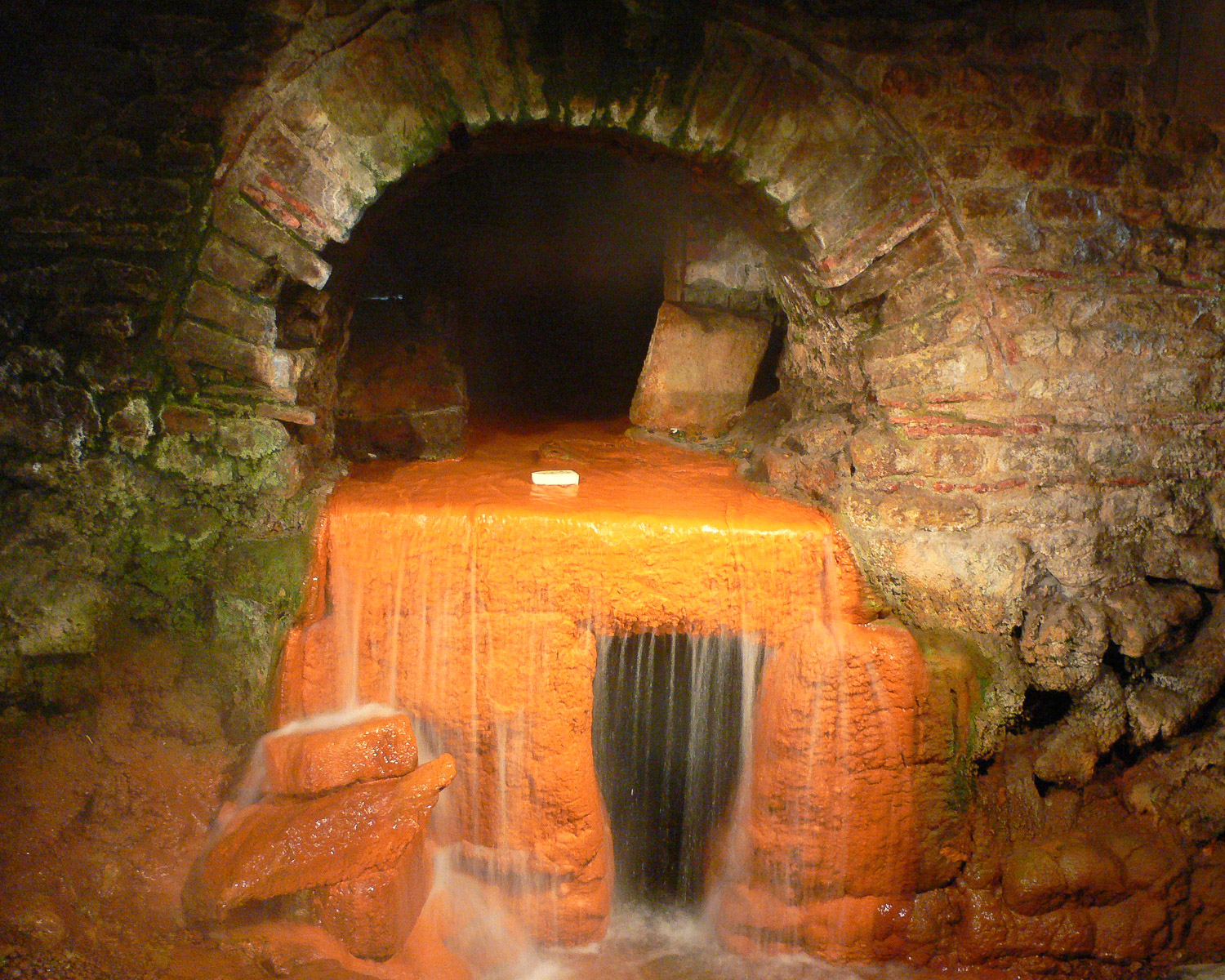
The scene at the temple and baths in Roman times is brought to life by short film clips of people going about their business. A bored Roman matron attended by her servant girl, the young family walking by and temple priests full of their own importance, remind us of the real people who walked upon these stones.
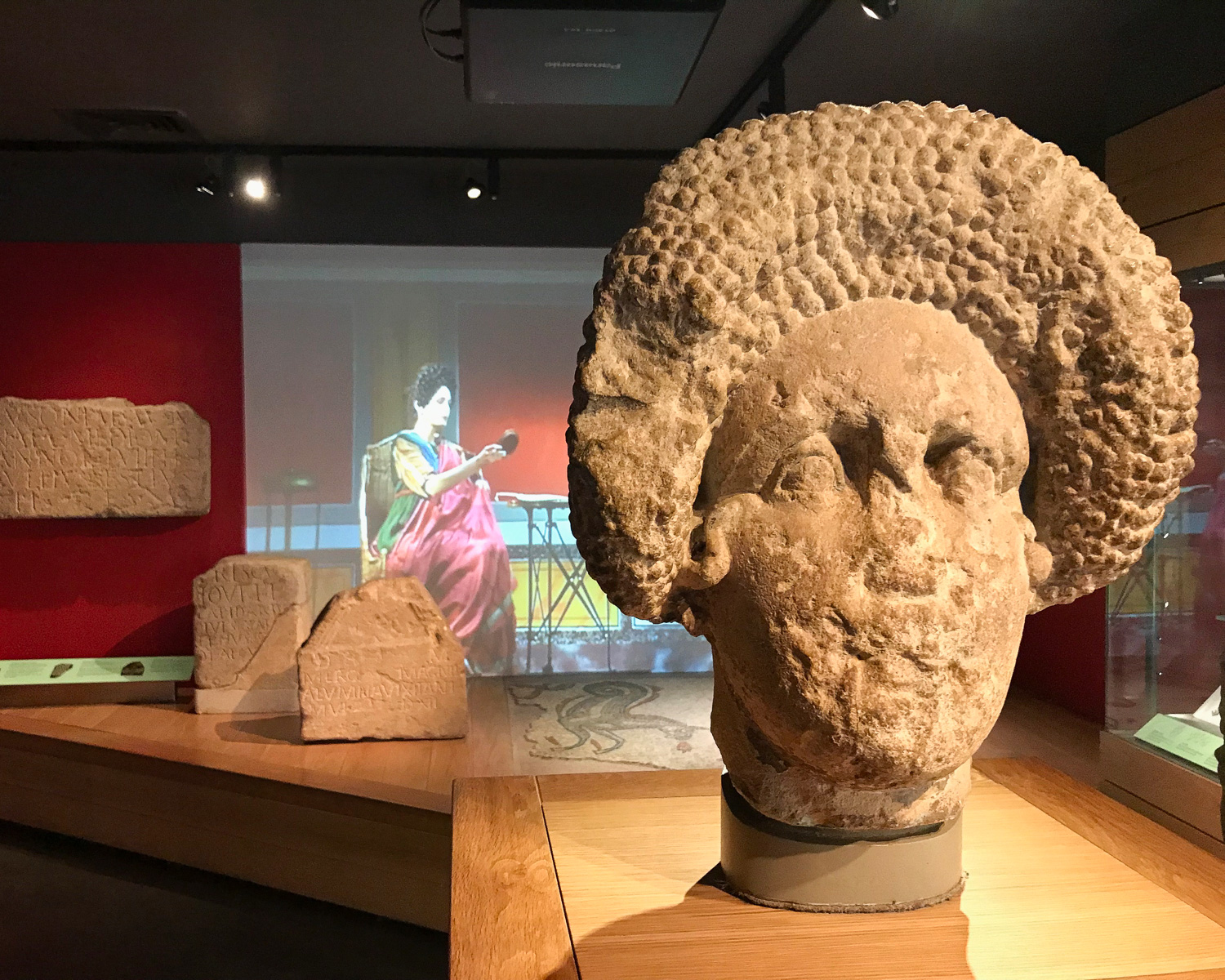
Our tour ends at the lower level of the Great Bath where visitors can sit by the water getting a sense of what it was like to come here to relax, bathe and socialise. It really feels like an open air swimming pool that you’d love to jump into and cool off.
Read my article: How to find a fabulous spa break in Bath
The Pump Room
As a final part of your visit it’s worth walking through the pump rooms, where you can also have afternoon tea, and you can taste the mineral water from the spring served from an elegant Georgian urn. It doesn’t taste particularly pleasant. But then if it did, it wouldn’t have such a reputation for health giving properties would it?
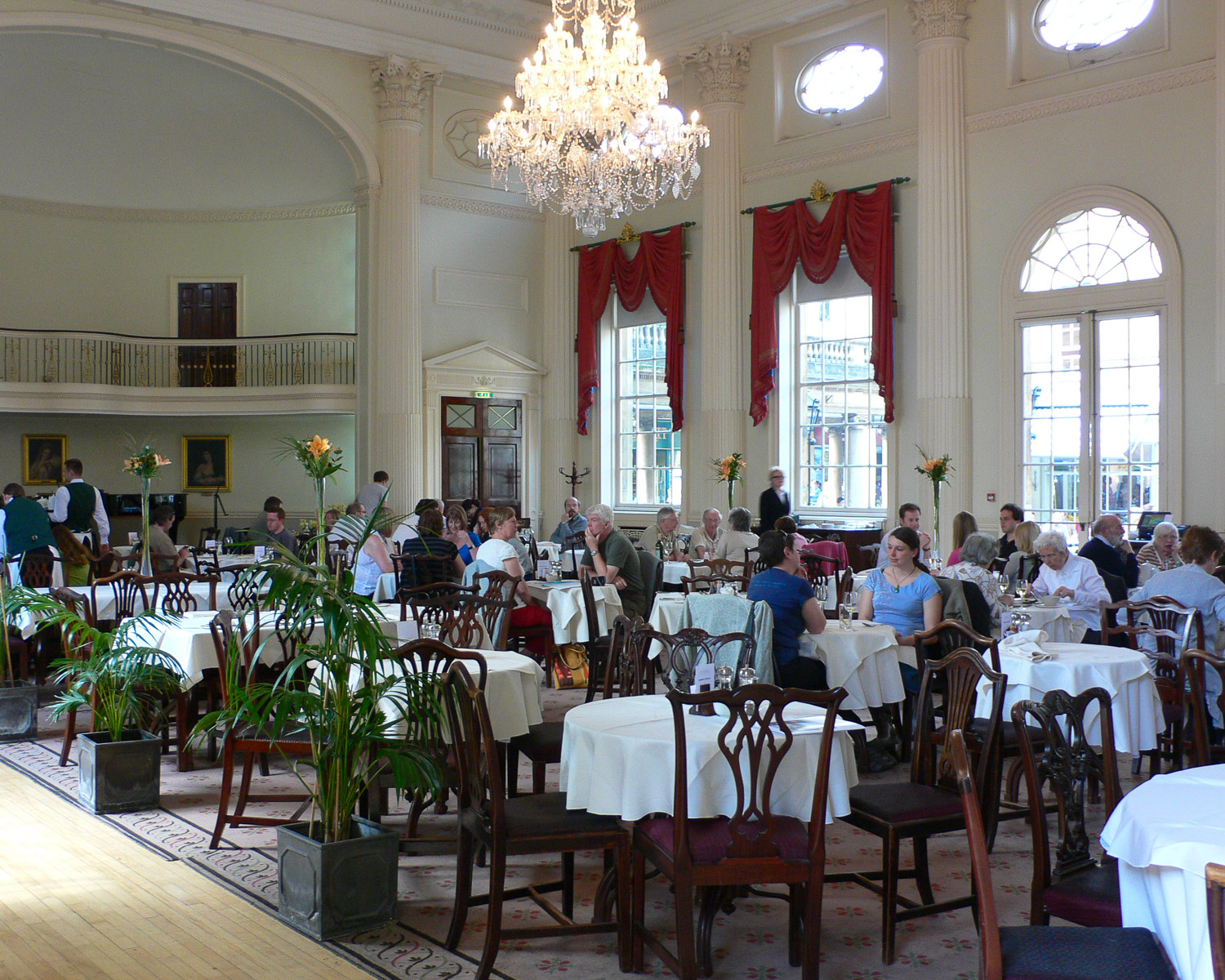
Plan your visit to the Roman Baths
Open: Daily all year round. Opening hours: 9am – 6pm (variable with day and season)
Ticket Price: Standard adult ticket from £21.50
Website: Romanbaths.co.uk Address: Abbey Church Yard, Bath, BA1 1LZ
Read more about 18 Exciting museums to visit in Bath

Read more articles from Bath
21 Best things to do in Bath – a local’s guide
How to find a fabulous spa break in Bath
Christmas in Bath – Christmas markets, what’s on and more!
Click to subscribe to our monthly newsletter, news and reader offers

Great Britain Bucket List: England, Scotland and Wales || The Travel Tester
Tuesday 9th of January 2018
[…] of Escape // Landlopers // Nomadic Matt // Rhyme and Ribbons // Mrs O Around the World // Heather on her Travels // The Little Backpacker // Travel with a […]
Cool Spa Bath images | Jacuzzi Prices
Saturday 29th of December 2012
[...] This photo links to my weblog write-up www.heatheronhertravels.com/fancy-a-dip-at-the-roman-baths-at-bath/ [...]
Travel Podcast in Western Egypt - Alexandria, Marsa Matrouh and Siwa | Heather on her travels
Wednesday 7th of December 2011
[...] large round pool with clear green water with the bubbles coming to the surface, reminding me of the Roman springs at Bath near where I live. We sat and had some lemon grass tea in a cafe next to the Cleopatra’s [...]
Wedding dress exhibition at the Fashion Museum in Bath | Heather on her travels
Friday 29th of April 2011
[...] Fancy a dip at the Roman Baths in Bath? Dressing up at the Fashion Museum in Bath [...]
Where Heather travelled in 2010 | Heather on her travels
Saturday 1st of January 2011
[...] French exchange friend all the tourist sites, including some I’d never seen such as the Roman Baths which are a must see for any visitor. Sometimes you have to be a tourist in your own back [...]

Visiting The Roman Baths In Bath England
The Roman Baths are the top attraction in Bath England. Dating back to 75 A.D., the baths are the best preserved ancient baths in Northern Europe. In 1987, they became a UNESCO heritage site.
This guide gives you an overview of the history of the Roman Baths, what to see when visiting the complex, and must know tips for visiting.
This 1st century bath complex was a meeting point for patricians who came to bathe, drink the curative waters, and socialize. The baths fell out of use with the Roman exodus from Britain. But they were rediscovered and excavated in the late 19th century.
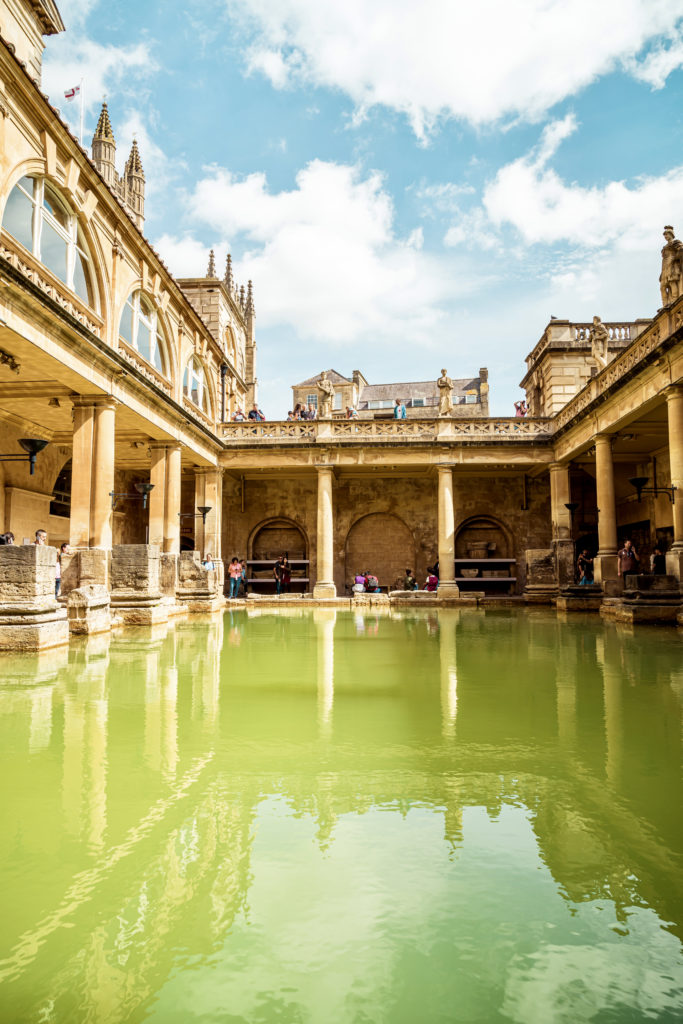
Today, visitors can see the in situ remains. Walking through them has a time warp feel, with the matte green waters of the baths perfectly reflecting the Roman facades. You’ll feel as though you’re stepping right back into Roman Britain.
The baths receive more than a million visitors a year. People come to see its historic finds, atmospheric pools, and imaginative displays.
History Of Bath: The Romans Arrive
The Roman arrived in Britain in 43 A.D. The Roman war machine made easy work of the far flung city.
READ : Nutshell History of Ancient Rome
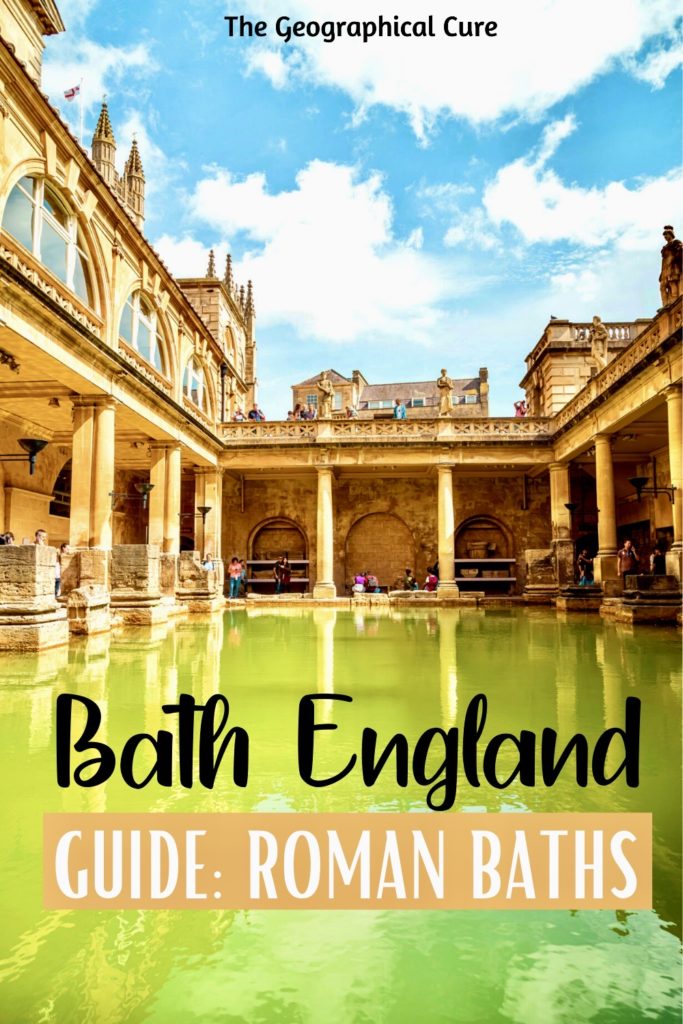
The Romans knew what a jewel they had. They had seen the steam rise from a marshy area in the water.
They knew Bath held a hot spring, the perfect spot for a bath the Romans so loved. After gaining control of the spring, they proceeded to create a complex of baths, pools, and a temple on a sacred Celtic spot. It was operational by 75 A.D.
The bathing and temple complex was surrounded with a stone wall, constructed during the 3rd Century. It encircled an area of 23 acres, although whether this was defensive is debated.
The Romans used the bath house for religious and recreational (bathing) purposes.
There were public ceremonies in the baths. They would sometimes include the sacrifice of an animal in dedication to Sulis Minerva.
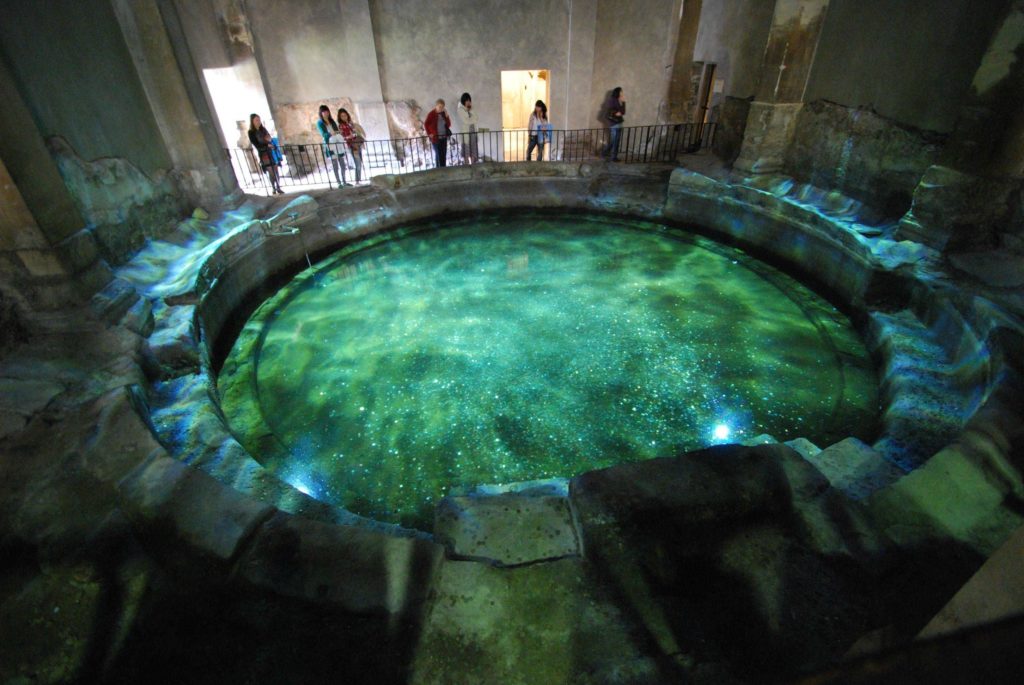
But the baths were also the place to socialize. Food and drink were served in the bath, including oysters and snails. Patricians would gamble, play cards, entertain clients, and listen to musicians.
The water wasn’t really green, as it appears. It was colorless, but took on its green hue from algae growth caused by heat and daylight.
The water was revered as a cure for all sorts of ailments, like gout, rheumatism, and skin diseases.
In 480 A.D., however the Roman Empire collapsed. The Romans departed Bath and the baths fell into ruins and were eventually buried.
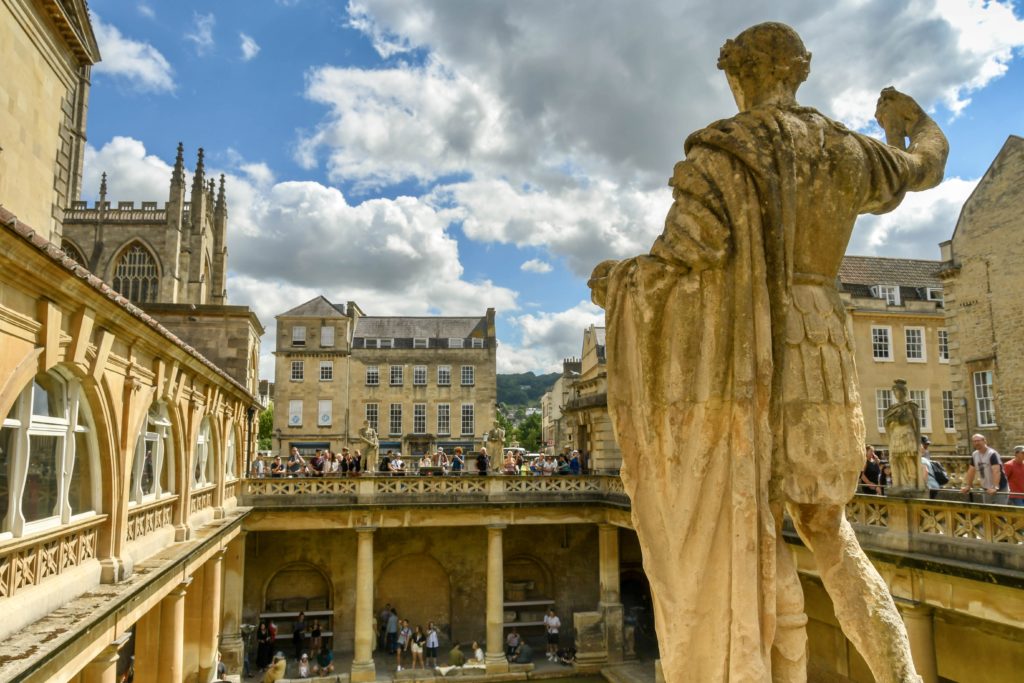
Inside The Roman Baths
Here’s what you can see at the Roman baths. You visit on a one way self guided tour. Definitely get the audioguide!
1. Overview
There are four parts of the bath complex: (1) the great bath house; (3) the Sacred Spring; (3) the Roman Temple; and (4) the museum.
The city of Bath is built on top of the baths. You enter from street level.
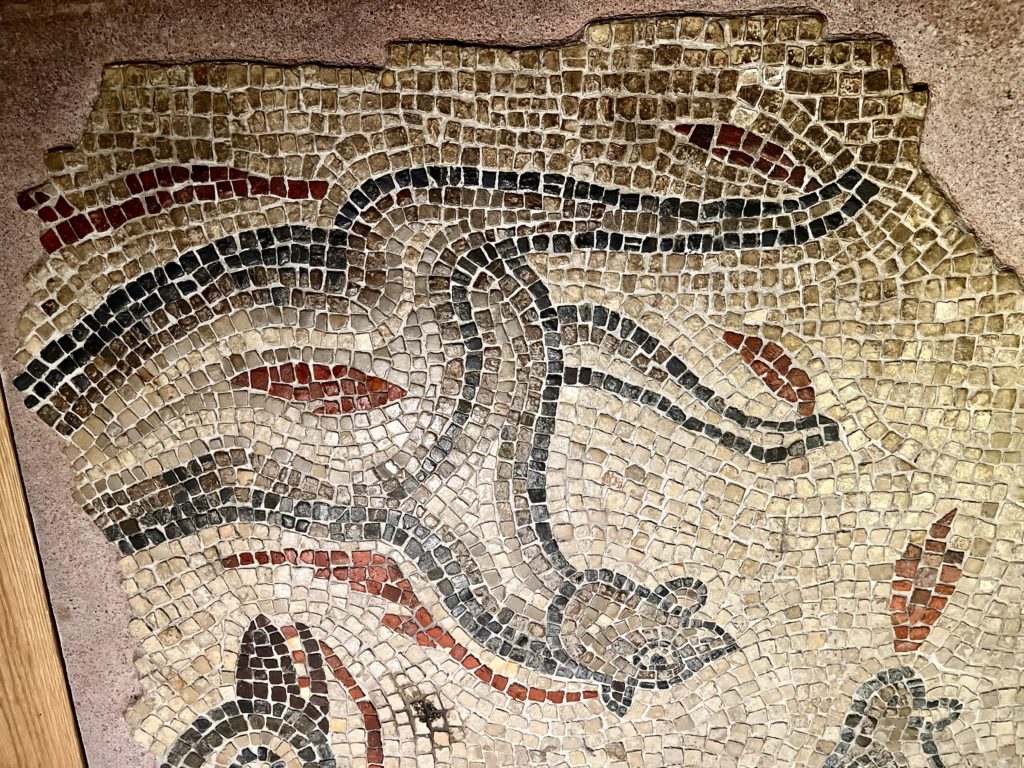
A long terrace lets you look down into the baths, which are over six feet below the ground. This breathtaking view is one of the highlights of the Bath complex.
The terrace is filled with sculptures of Roman emperors and generals, including Julius Caesar, Claudius, and Hadrian. You can look at them up close. You then pass from the terrace through hallways and rooms.
READ : History of the Roman Emperors
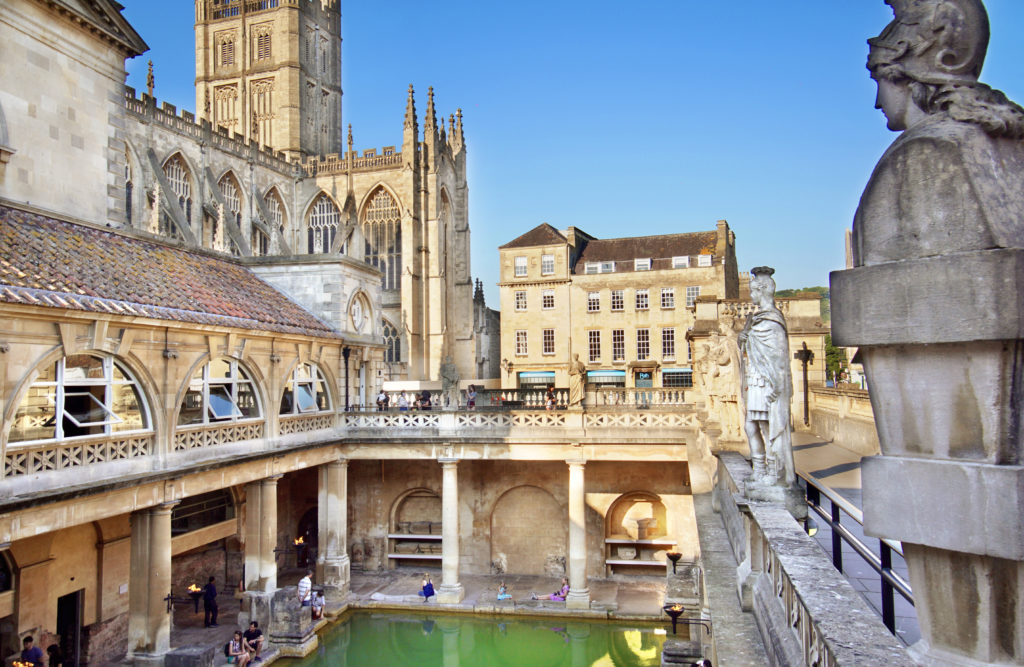
2. Temple of Sulis Minerva
In the series of darkish rooms inside the complex, you’ll see the in situ remains and ornate architectural fragments of what was once the magnificent open air Temple of Sulis Minerva.
She was the goddess of the thermal spring. Sulis wasn’t a Roman goddess though. She was a local Celtic deity from the Iron Age.
The Romans deduced that Sulia was the equivalent of their goddess Minerva. So they used both names.
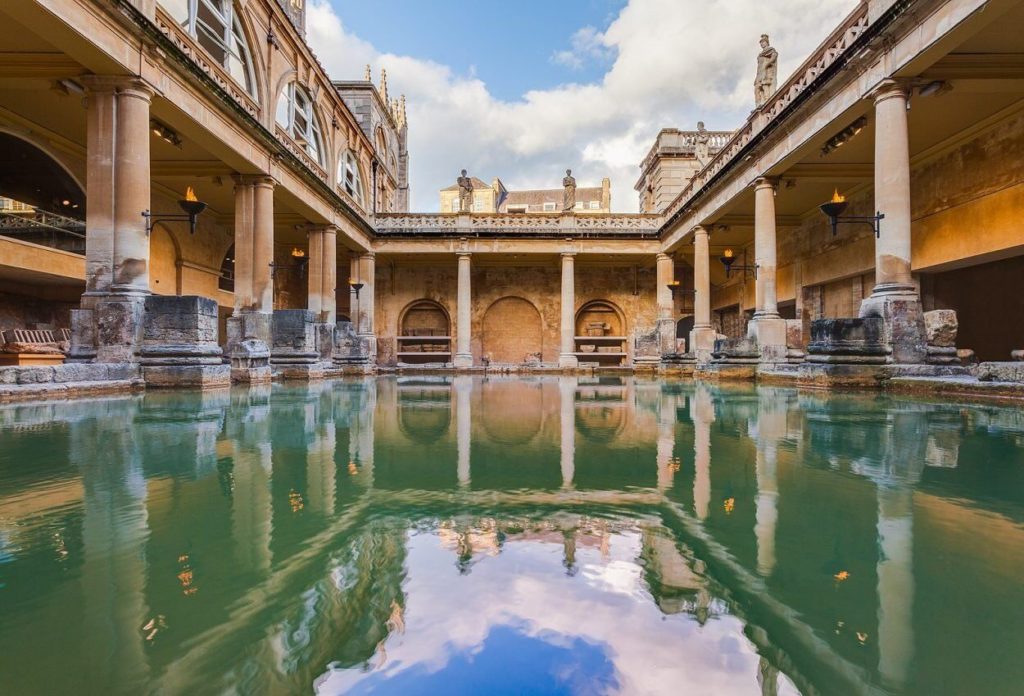
In its heyday, the temple was a classical masterpiece worthy of Rome itself. it was set on a high podium reached by steep stairs.
Its porch was dominated by four massive Corinthian columns supporting an ornate pediment. There was a small room where priests would tend to the flames burning around a life size cult statue of Sulis Minerva.
The ornamental blocks from its front facade are one of the most important exhibits in the museum. They were excavated in 1981-83.
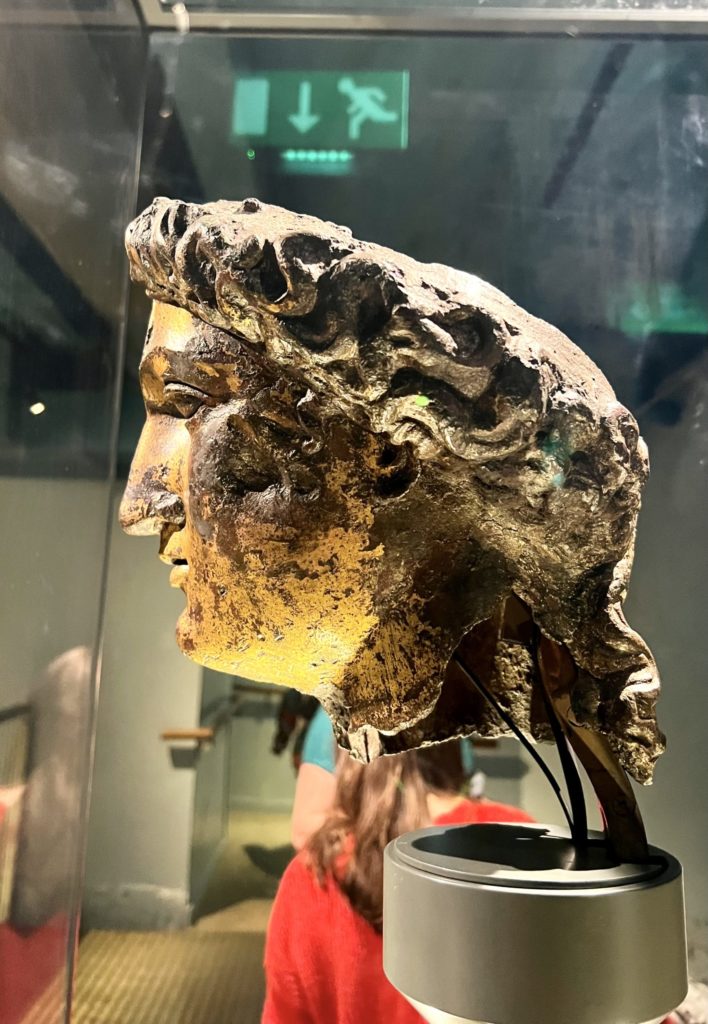
In the museum areas, you’ll find diagrams, dioramas, and models. There are artifacts like coins, mosaics, tombstones, religious masks, and busts. Videos and holograms are used to make the ruins come alive.
Look out for the famous gilded bronze head of Minerva and a striking carved gorgon’s head from the temple pediment.
The gilded head is one of the best known objects from Roman Britain. It was found in 1727 by workmen digging in a sewer.
You’ll even see “curse scrolls.” The Romans inscribed curses on tablets made of sheets of pewter or lead.
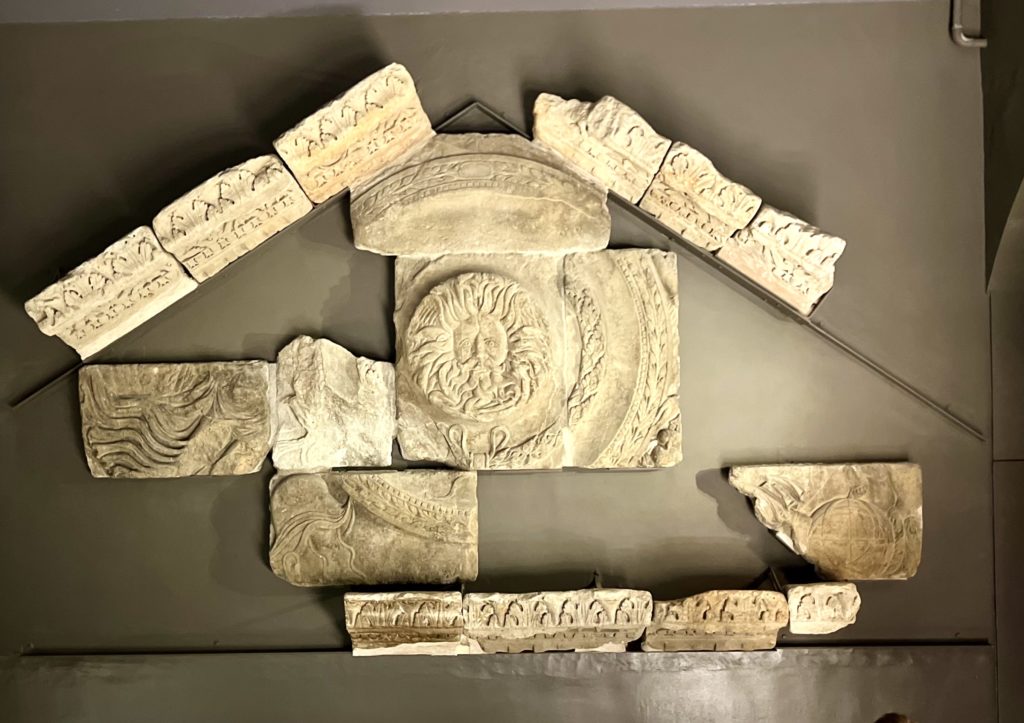
They threw the curses into the springs hoping to procure justice from Sulis Minerva. Archaeologists discovered the curses during excavations.
The curses are pretty funny. They reveal the petty side of human nature. They were almost like modern day tweets.
One scroll, for example, asks that the thief who stole his gloves lose his “mind and eyes.” Another person sought revenge for the theft of a bronze vessel, asking that it be “filled with the blood of the thief.”
There’s also a large scale model of the temple and the bath complex. You will get an idea of how it looked to Roman citizens.
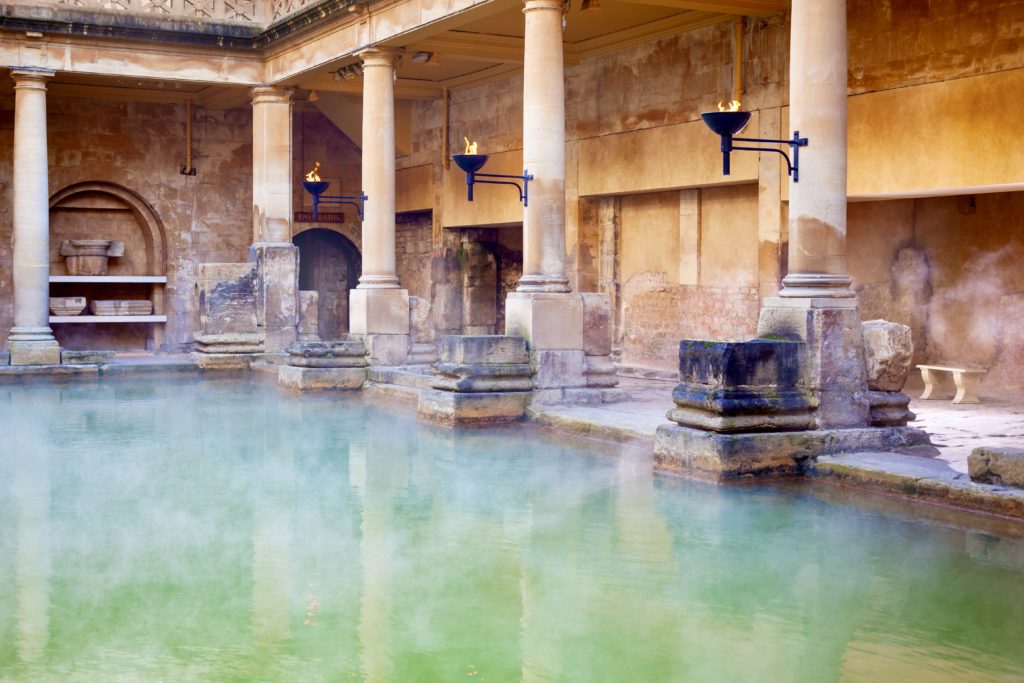
4. Great Bath
Your downward progress ends at a beautiful smoldering pool known as the Great Bath. It’s the showstopper of the bath complex.
The Great Bath is an elegant hall with a rectangular swimming pool surrounded by broad paved walkways. It was the largest pool in the bathing complex.
The pool is lined with lead and filled with steaming, geothermally heated water from the so-called “Sacred Spring” to a depth of 5 feet.
The bath is open-air. Originally, it was covered by a 145+ feet barrel vaulted roof made of brick.
There are pillars, long arches, and statues of Roman generals and emperors at the top. At one time, patterned mosaics decorated the floors.
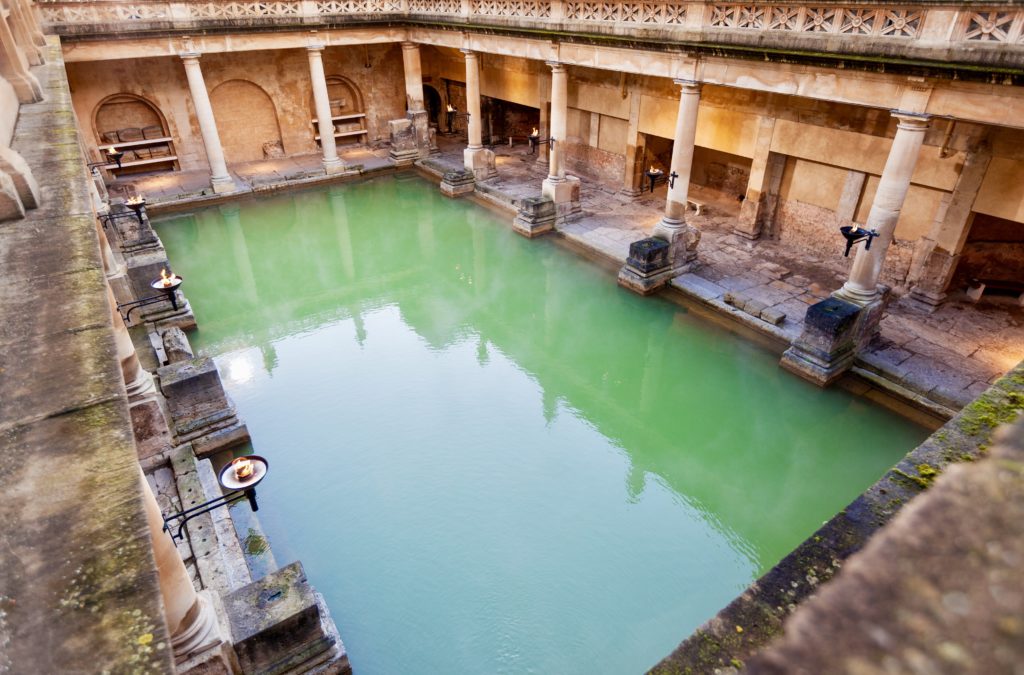
Niches around the Great Bath would have held benches for bathers and possibly small tables for drinks or snacks. A large flat slab of stone is set across the point where hot water flows into the bath. It’s known today as the diving stone.
Despite its architectural beauty, the bath couldn’t have functioned without Roman engineering to ensure the flow of water.
The Romans used lead piping and bronze sluices to ensure the supply of hot water and steam to the different bathing facilities. Brick stockeries and chimneys allowed hot air from furnaces to circulate in the treatment rooms.
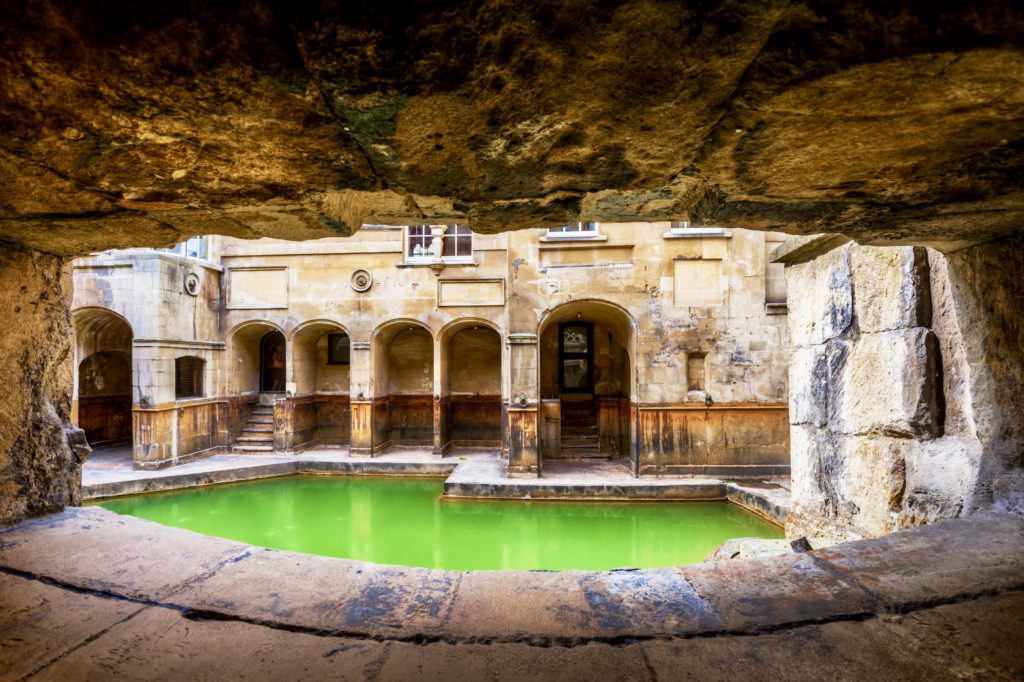
5. Other Baths
But the baths don’t end there. To the east and west are more Roman pools, changing areas, hot rooms, cold plunge pools, etc.
The Romans followed a specific regimen after bathing in the Grand Bath. They would warm up in the tepidarium , sweat in the caladrium , and then jump in the cold frigidarium to close the pores. You can see the ruins of these different areas.
Excavated sections also reveal the hypocaust system that heated the bathing rooms.

6. Pump Room
The famous Pump Room is a restaurant and tea room that built by Thomas Baldwin and John Palmer. It’s a historic building in the Abbey Church Yard.
In Georgian Bath, the Pump Room was the social heart of Bath, where the rich and famous wanted to be see and be seen in Georgian Bath. The novelist Jane Austen would have patronized it.
The Pump Room is built in a Neoclassical style, complete with soaring Ionic and Corinthian columns. It’s physically in the same building as the Roman Baths.
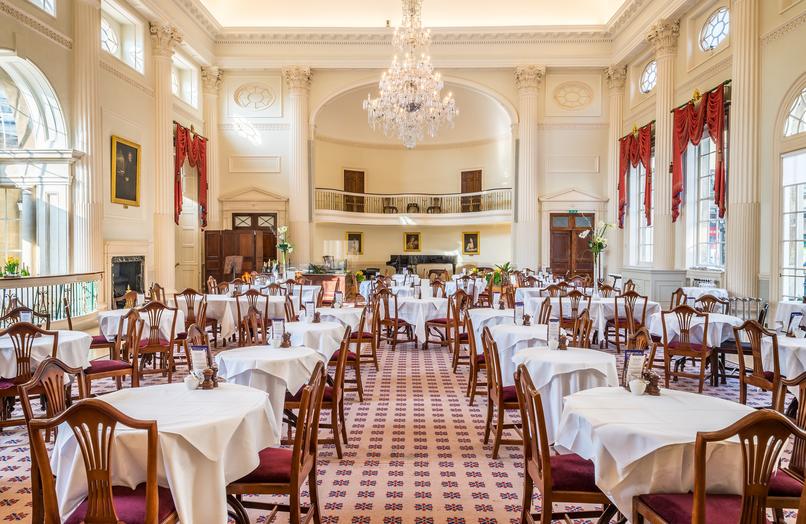
But it has a separate entrance, very close to the entrance of the Roman Baths. From inside, you have a birds eye view of the Roman Baths from its balcony.
You can taste free samples of the thermal spring waters, to test the Victorian hypothesis that they had curative properties.
The Pump Room also has a restaurant, which serves magnificent afternoon teas. If you’re lucky, you might even have music provided by the Pump Room’s string trio.
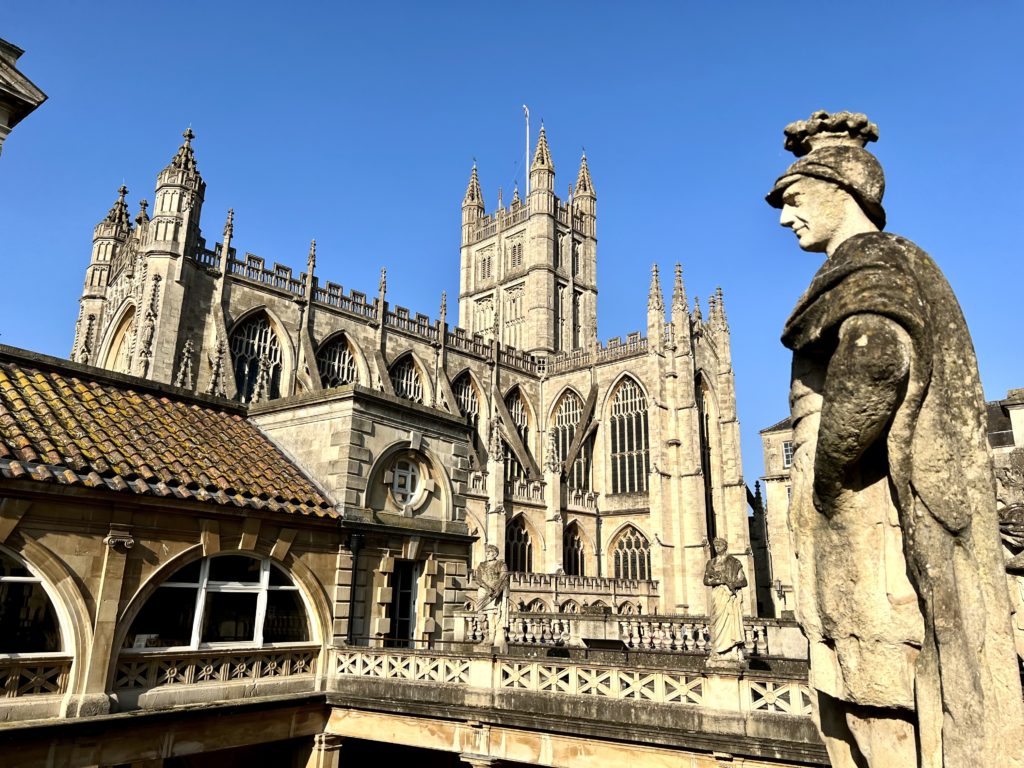
Tickets & Tours
Admission to the Roman Baths is £ 20-25 per ticket, depending on when you go. You should book in advance. Click here to book a ticket on the website.
I was just there on a March weekend and it was fully booked. The price includes an audio guide offering plenty of interesting information. You can pick it up after you hand in your ticket.
You can also take a guided 2 hour walking tour of Bath with an entry to the Roman baths .
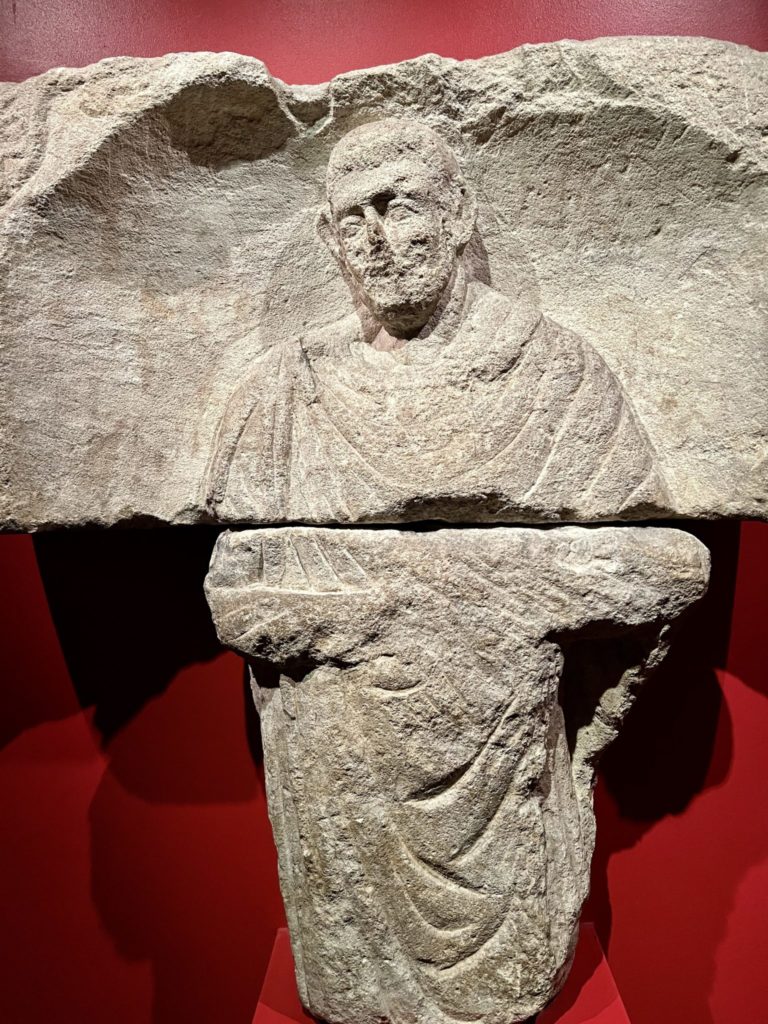
How To Get To The Roman Baths
It’s very easy to get to Bath by train. From London Paddington Station, it takes 1.5 hours to arrive at Bath.
If you want to drive, Bath is about 85 miles from London. The trip takes just under 2 hours, if there’s no traffic.
Many people visit on a guided tour. If you’re based in London, you can also book a guided day trip tour to both Bath and Stonehenge . You can also book a guided tour that includes Stratford-Upon-Avon, Stonehenge and Bath .
The second tour is long and packs a lot in. But if you’re short on time, it’s an ideal way to see several several marquis attractions in England.
A variant of this tour takes you on a day trip to Windsor Castle, Stonehenge, and Bath .
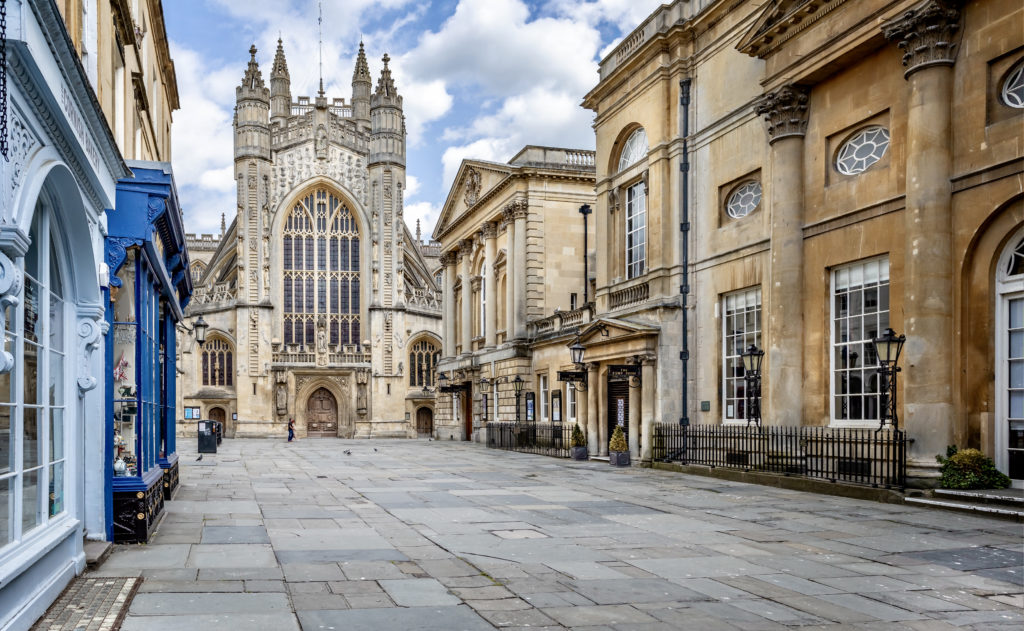
How to Visit the Roman Baths in England
Here’s what you need to know to visit the Roman Baths:
Address : The Roman Baths, Abbey Church Yard, Bath, BA1 1LZ.
Hours : In July and August the Roman Baths are open until late evening.
Admission to the Roman Baths is £ 20-25 per ticket, depending on when you go. You should book in advance. The Baths are often sold out.
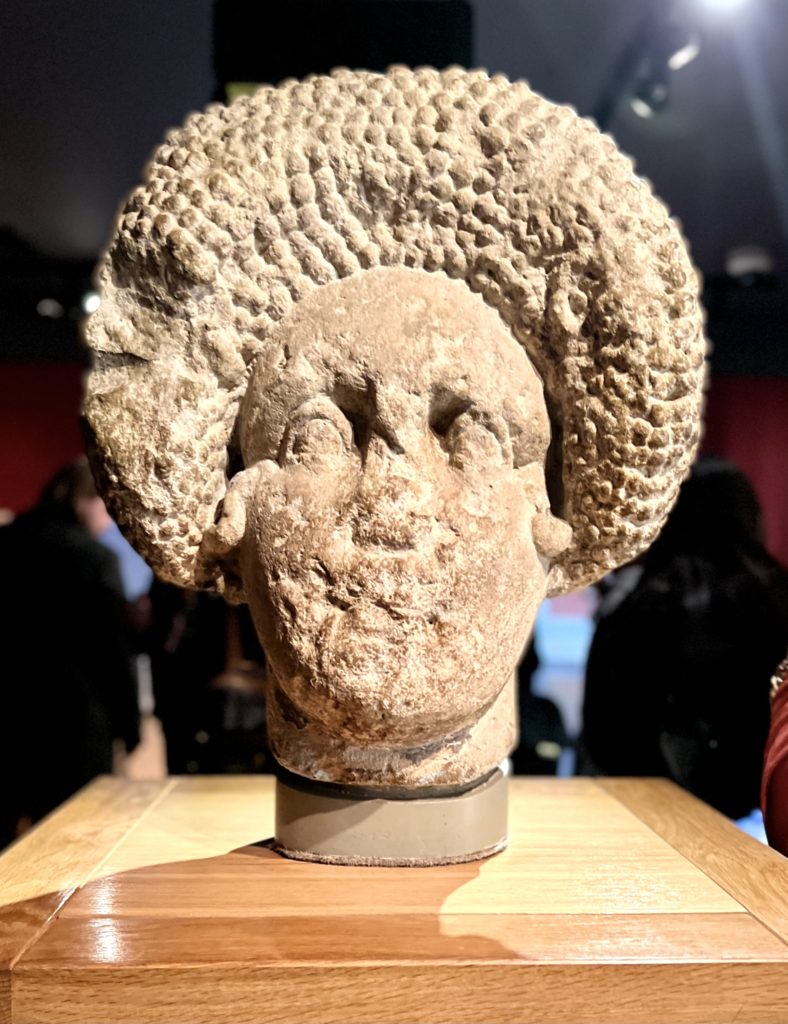
Click here to book a ticket on the website. Tickets must be purchased no later than midnight the day before your visit.
Admission to the Roman Baths includes an audio guide, with commentary in 12 languages. You pick it up to the left after you’ve turned in your ticket at the entrance office.
Pro Tip : The museum has a separate audioguide for children to help make the ancient site come to life. There are also costumed actors, playing Roman citizens, who will interact with visitors.
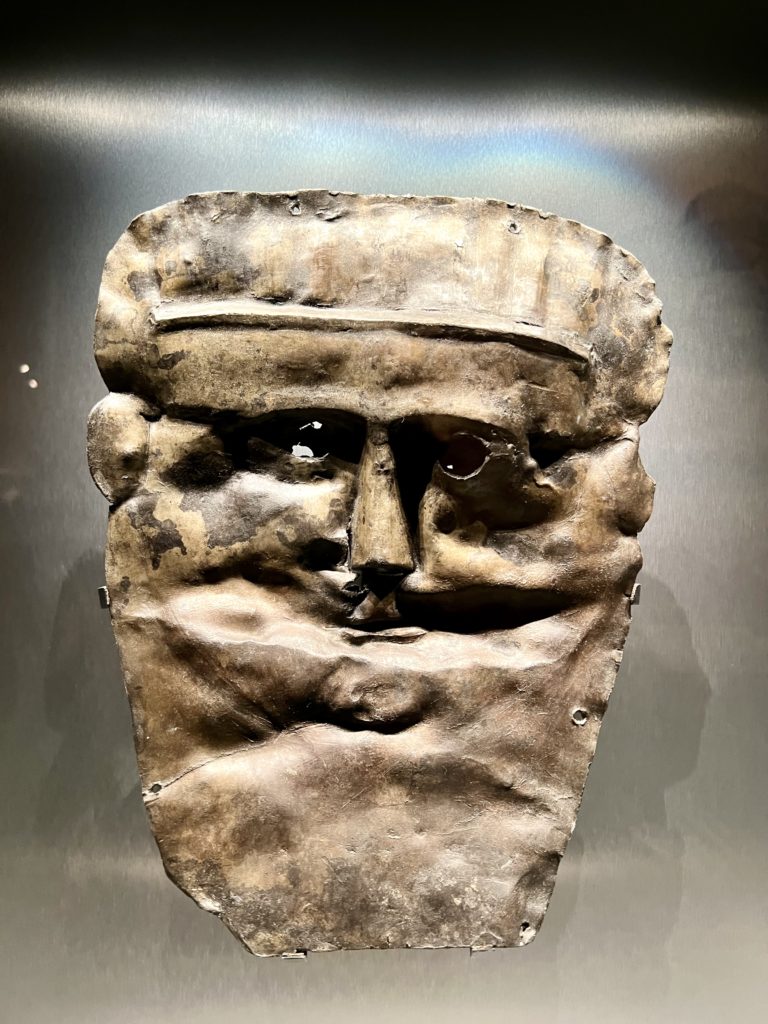
How Long To Visit : 1-2 hours
When To Visit :
The Baths can get very crowded, especially in peak summer months. The London coach tours begin arriving around lunch time and through the afternoon. If you’re visiting independently, head to the baths in the early morning or the late afternoon.
I hope you’ve enjoyed my guide to visiting the Roman Baths in Bath. You may want to check out my one day itinerary for Bath to see what else to do in Bath. Here are some of my other other London area travel guides and resources:
- 5 Day Itinerary for London
- Harry Potter Places in London
- Tourist Traps To Skip in London
- Guide To the National Gallery of Art
- Guide To the Wallace Collection
- Guide To the Tower of London
- Free Museums in London
- Virtual Tours of London
- Guide To Free Museums in London
- Guide To Hampton Court Palace
- Guide To Hatfield House
If you’d like to visit the Roman Baths in Bath, pin it for later.
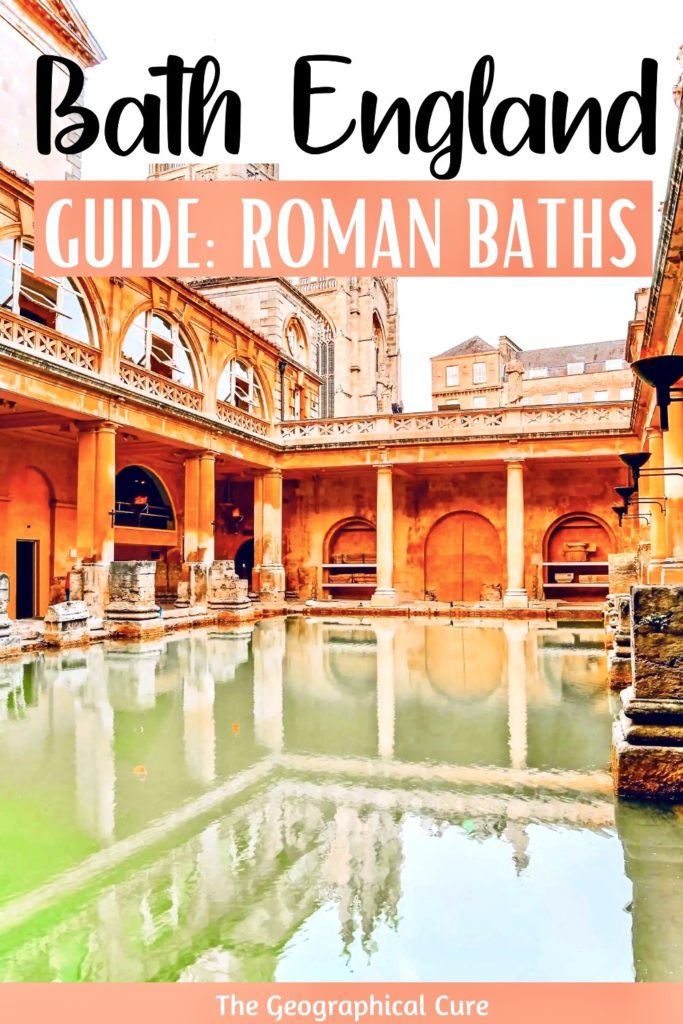
Leave a Comment Cancel reply
Save my name, email, and website in this browser for the next time I comment.
Last Updated on April 6, 2022 by Leslie Livingston
Taking The Red Eye
A Modern Guide to Travel
- Skip to primary navigation
- Skip to main content
- Skip to primary sidebar
- Skip to footer
Destinations , Inspiration · February 8, 2024
The Roman Baths in Bath: All You Need to Know
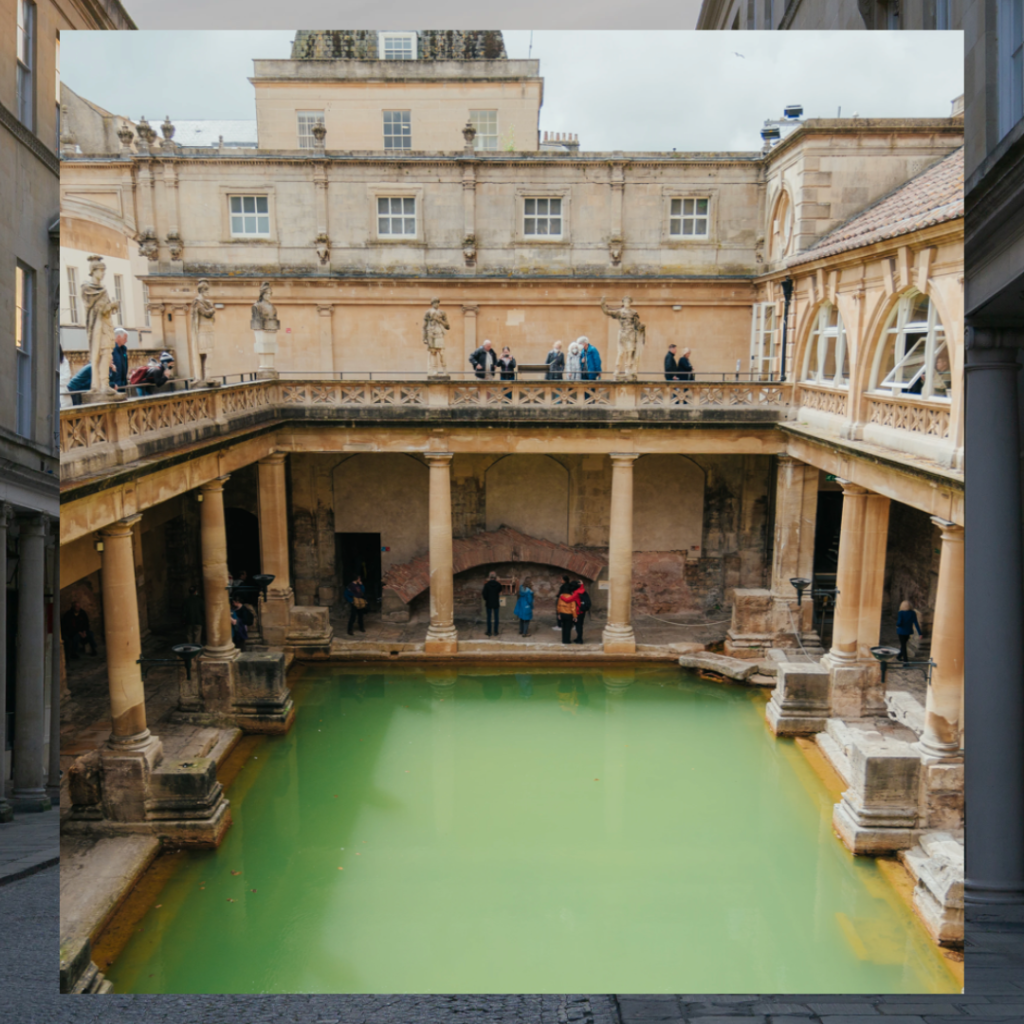
The Roman Baths in Bath are about as iconic as the city itself. Steeped in history, there is a reason why there are always queue upon queues of people wanting to visit.
The Baths are situated next to Bath Abbey, which makes them easily accessible on foot from most parts of the city centre.
As a travel writer and someone who has grown up near the city, I have explored the city and all it has to offer, it is somewhere we know well, and have written about for other publications. Therefore, this article has been drawn from all of my own experience.
But before you visit, we will provide you with everything you need to know. From the best times, and what to expect from your visit, we’ve got you covered.
Here is Everything You Need to Know Before Visiting The Roman Baths in Bath:
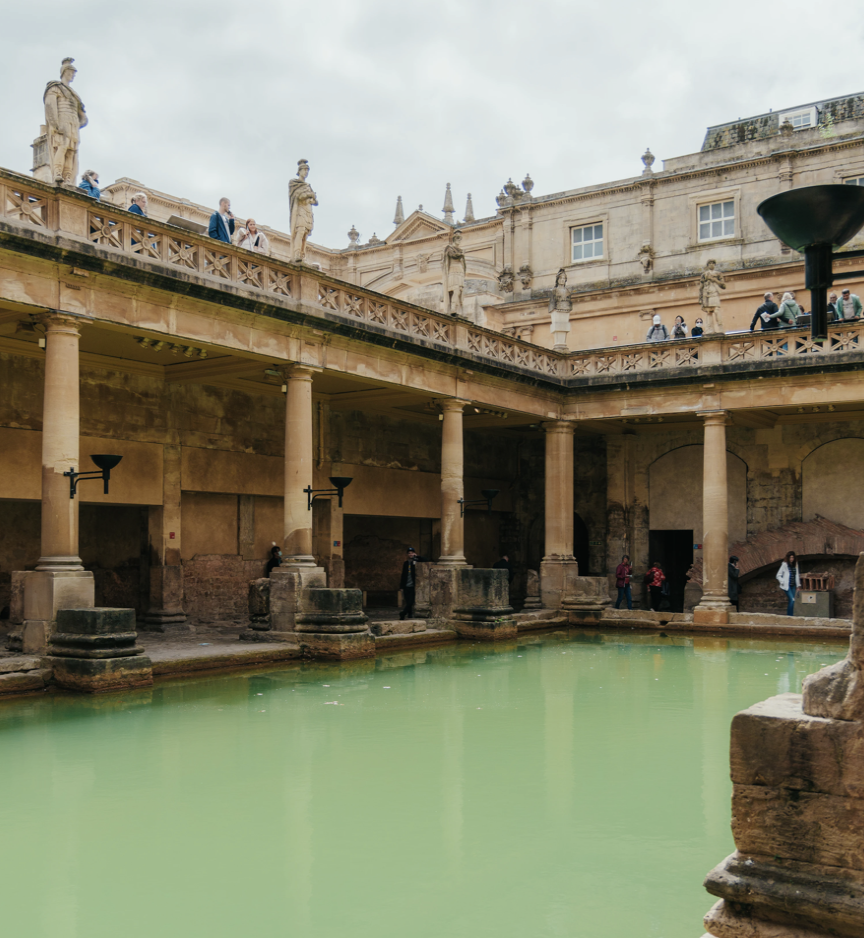
What Are The Roman Baths in Bath?
The Roman Baths in Bath, England, are among the best-preserved Roman thermae (bath complexes) globally. Built around 70 AD, the Roman Baths in Bath, England, stand as a testament to Roman ingenuity and cultural influence, earning them recognition as a UNESCO World Heritage Site . These meticulously constructed thermae weren’t simply bathing facilities; they served as vibrant social hubs, religious centers, and testaments to Roman engineering prowess.
Remaining a major tourist spot in Bath, the complex offers visitors a window into Roman life. It encompasses various features, including a caldarium (hot bath), tepidarium (warm bath), frigidarium (cold bath), and a swimming pool. Additionally, a temple dedicated to the goddess Sulis Minerva stands on the site of a natural hot spring. Roman engineering shines through the Baths, with vaulted ceilings soaring overhead, hypocaust heating systems efficiently warming the spaces, and mosaics and statues adding vibrant artistry. These elements collectively reveal the ingenuity and artistic spirit of the Roman builders.
Is it Worth Visiting the Roman Baths in Bath?
They Roman Baths are absolutely worth visiting, particularly as they are a UNESCO World Heritage Site.
UNESCO has recognized the Roman Baths as one of the best-preserved Roman baths in the world for their historical and cultural significance. The Roman Baths are among the best-preserved Roman remains in the world, offering a unique glimpse into Roman bathing culture and engineering. You can walk on the same pavements used by Romans 2,000 years ago and explore excavated ruins like the Great Bath, the temple, and bathing chambers.
The Baths offer a glimpse into the everyday life of a Roman citizen. You can also explore the ruins and learn about the different uses of the baths.
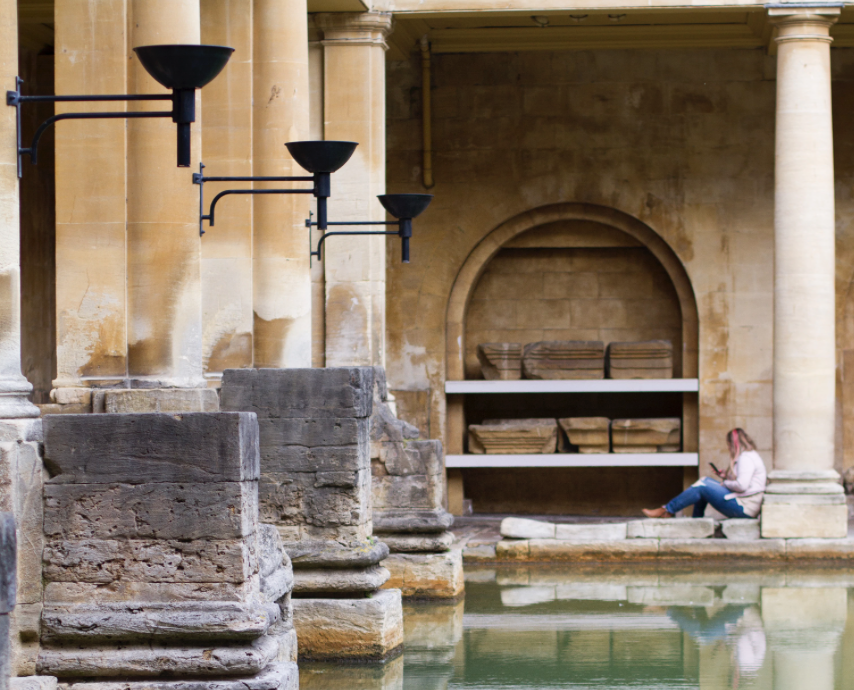
What Makes the Roman Baths So Special?
The Roman Baths in Bath are special for a number of reasons.
First, they are one of the best-preserved Roman baths in the world. The complex includes a variety of features, including a caldarium (hot bath), tepidarium (warm bath), frigidarium (cold bath), and swimming pool. There is also a temple to the goddess Sulis Minerva, which was built on the site of a natural hot spring.
Second, the Roman Baths are a UNESCO World Heritage Site, which means that they are recognized as being of outstanding universal value. The baths are a testament to the engineering and cultural achievements of the Roman Empire.
Third, the Roman Baths are a popular tourist attraction, but they are also a place where people can learn about Roman history and culture. The complex includes a museum with a variety of exhibits on the Roman Baths and Roman life in Britain. Visitors can also take guided tours of the baths and learn about their history and construction.
How to Get to The Roman Baths
The Roman Baths are located in the heart of the city at Abbey Church Yard, BA1 1LZ. They are next to Bath Abbey, and just a short walk from many other popular tourist attractions, such as the Royal Crescent, the Circus, and the Jane Austen Centre.
Getting to the Roman Baths by public transportation is easy. The nearest train station is Bath Spa Station, which is a short 10-minute walk away. Several major cities in the UK, including London, Bristol, Cardiff, and others, have regularly scheduled trains directly to the station.
If you are driving to the Roman Baths, there are several pay-and-display car parks nearby. However, please note that parking in Bath can be expensive and difficult to find, especially during peak season.
Once you arrive at the Roman Baths, you can enter through the main entrance on Abbey Church Yard. There is a visitor center and ticket office located inside the entrance.
If you are driving to the Roman Baths, there are a number of car parks located nearby. The closest car park is the Abbey Churchyard Car Park, which is located just a short walk from the entrance to the Roman Baths.
Accessibility
The Roman Baths are also wheelchair accessible, and there is a lift that can take visitors to the different levels of the complex.
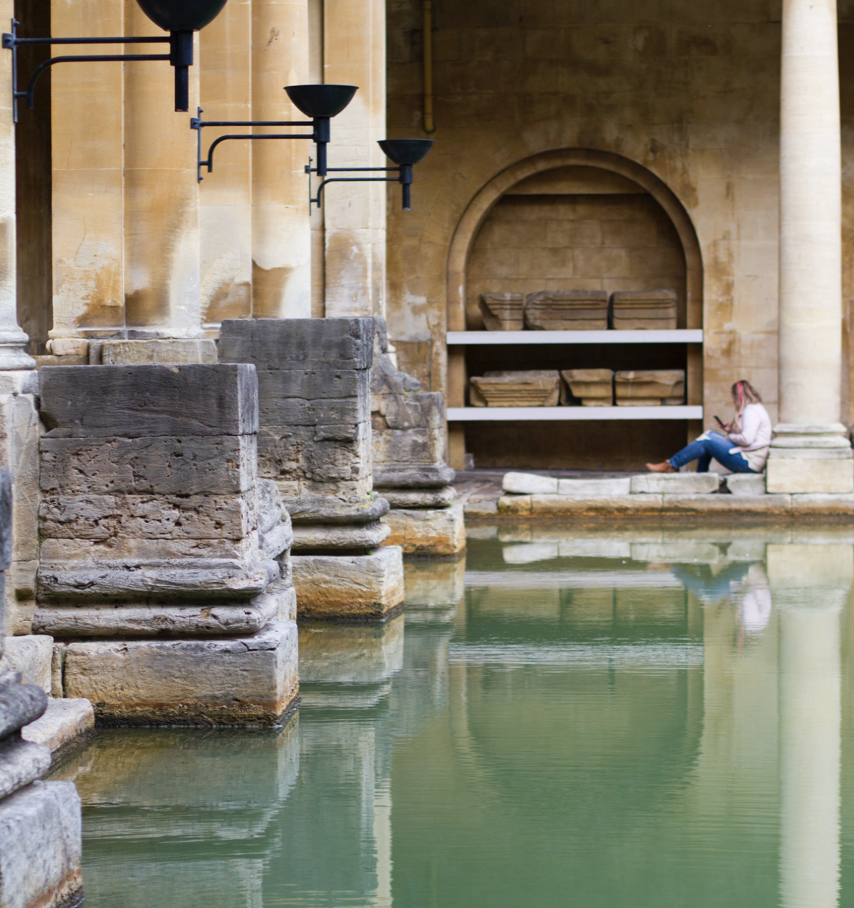
When Is Best To Visit the Roman Baths?
The best times of year to visit the Roman Baths in Bath are during the shoulder seasons of spring (April-May) and autumn (September-October). During these months, the weather is mild and pleasant, and there are fewer tourists than during the peak summer months.
If you are planning to visit the Roman Baths during the summer months (June-August), be prepared for larger crowds and hotter weather. The baths are open from 9:00 AM to 9:00 PM during the summer months, so you may want to consider visiting early in the morning or late in the evening to avoid the crowds.
If you are visiting the Roman Baths during the winter months (November-March), be aware that the weather can be cold and wet. The baths are open from 9:00 AM to 6:00 PM during the winter months.

Events at The Roman Baths
The Roman Baths in Bath, England, offer a variety of weekly events throughout the year. These events are designed to appeal to a wide range of visitors from those interested in health and well-being to history lovers. Here is a sample of the weekly events that are currently offered at the Roman Baths:
- T’ai Chi on the Terrace: This weekly class is a great way to relax and unwind in the beautiful setting of the Roman Baths. T’ai Chi is a gentle form of exercise that is suitable for all ages and abilities.
- Through the Eyes of Minerva: This exhibition takes visitors on a journey through the Roman Baths from the perspective of the goddess Minerva. The exhibition features a variety of artifacts and interactive displays.
Sunrise Tours:
The sunrise tours at the Roman Baths in Bath, England, are a unique experience for visitors. These early morning tours give you the chance to explore the ancient site before it opens to the public.
The sunrise tours begin at 9am and lasts for one hour. Visitors are led by an expert guide who will share the fascinating history of the Roman Baths and its significance. Visitors will also have the opportunity to see some of the unique artifacts that are housed in the museum, such as the gilt bronze head of the goddess Sulis Minerva and the magnificent Gorgon’s Head. One of the best things about the sunrise tours is that they are limited to a small number of people. This means that visitors can enjoy a more intimate and personal experience. The tours are also a great way to avoid the crowds that typically flock to the Roman Baths later in the day. The sunrise tours are available on Mondays and Fridays from February to June. Tickets are best to be booked in advance and cost £60 per person.
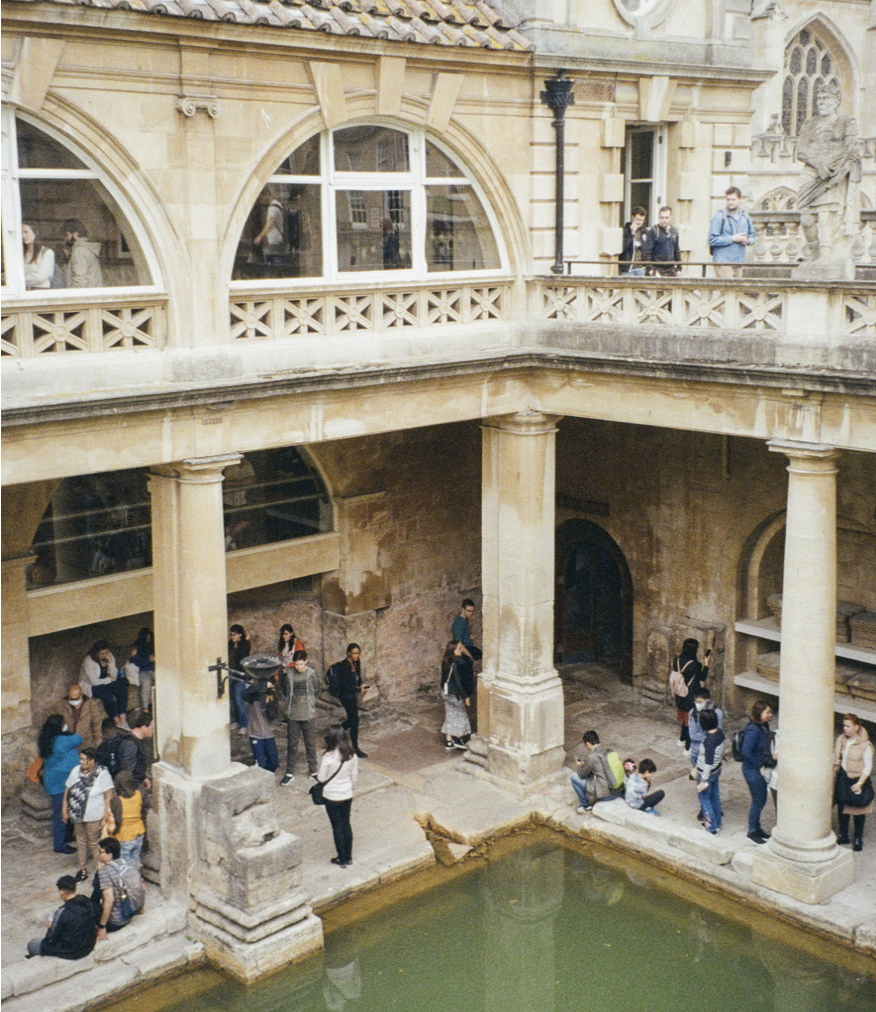
Opening Hours
Current Opening Hours: 9am – 6pm (these hours are subject to change depending on the month and time of year).
The Roman Baths are open every day except 25th and 26th of December.
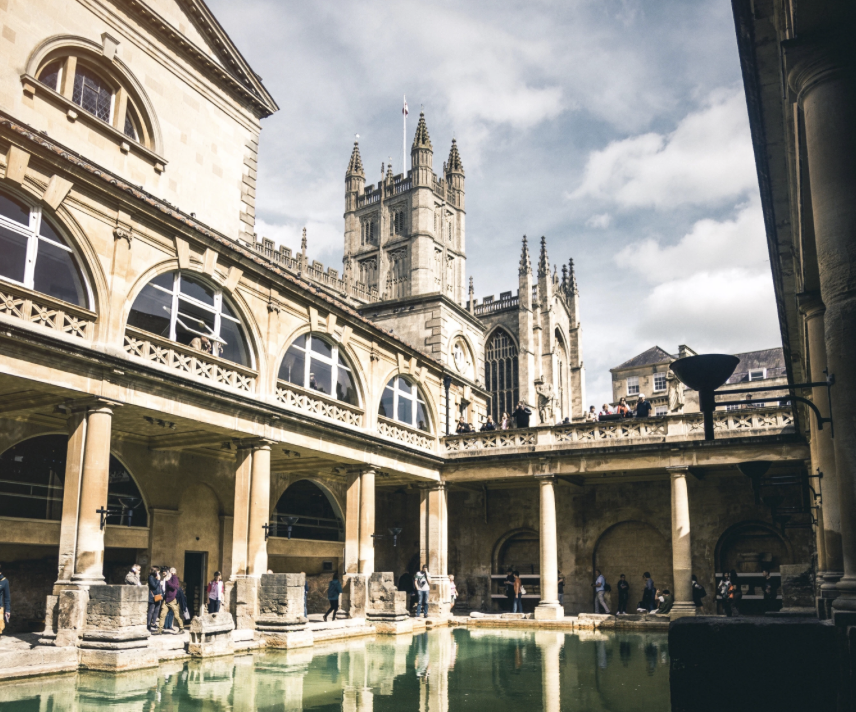
How Long Should You Spend at the Roman Baths?
Overall, we would recommend spending at least 2 hours at the Roman Baths in Bath. This will give you enough time to explore the ruins and learn about the history of the baths in detail.
If you are interested in learning more about the Roman Baths, you may want to consider taking a guided tour (see below). The tours last about 1 hour and 30 minutes, and they provide a wealth of information about the baths and Roman life in Britain.
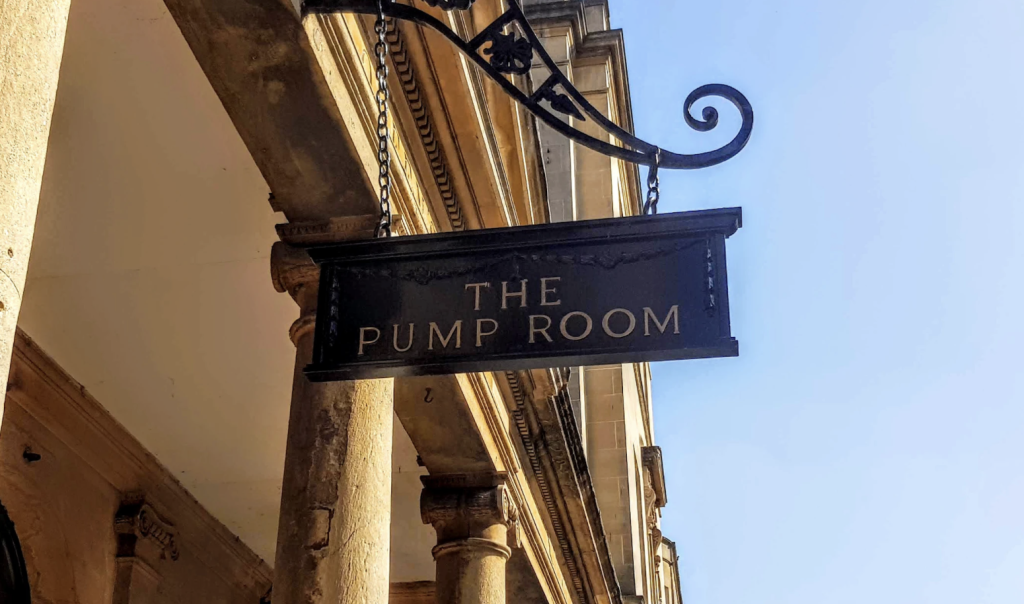
Tours and Tickets Information
It is advisable to book your tickets in advance, especially during peak season. There are a variety of tickets available for the Roman Baths, depending on your needs and budge. Below are each of the different options:
- Standard tickets give you full access to all areas of the Roman Baths, including the Great Bath, the Temple of Sulis Minerva, and the museum. Standard tickets are available for adults, children, and families.
- Concessionary tickets are available for students, seniors, and people with disabilities. Concessionary tickets are also available for groups of 10 or more people.
- Audio guide tickets include a handheld audio guide that provides information about the Roman Baths in English or French. Audio guide tickets are available for adults and children.
- Tour tickets include a guided tour of the Roman Baths. Guided tours are available in English and last for approximately one hour. Tour tickets are available for adults and children.
- Family tickets are available for two adults and up to four children. Family tickets are a great way to save money if you’re visiting the Roman Baths with your family.
- Blue Peter badge holder s receive free entry to the Roman Baths.
- Discovery Card holders also receive free entry to the Roman Baths. The Discovery Card is a free pass that gives residents of Bath & North East Somerset access to a variety of attractions in the area.
Take A Tour
One of the best-rated tour which we would recommend is one provided with GetYourGuide. It is worth being aware that some tours will include the Baths in their description but often don’t include the price of an entrance ticket.
This tour includes the entrance ticket and even allows you to skip the queues, proving you with quick access even on a busy day.
Learn more about the GetYourGuide Tour of the Roman Baths here with an experienced, friendly and very knowledgable Blue Badge Tourist Guide (which also includes a walking tour of the city also, offering value for money).
Conclusion: The Roman Baths in Bath
That concludes our guide about the Roman Baths in Bath. The Roman Baths in Bath are a historic must-see for any visit to the city. You don’t need to be a history-lover to appreciate the significance of the baths either. They are one of the best-preserved Roman baths in the world, and they offer visitors a glimpse into the life of a Roman citizen.
Overall, be sure to consider the time of year to visit, the milder seasons will bring potentially higher crowds or opt for quieter, cooler months. Furthermore, consider whether you want to book a tour which will provide in-depth history and background on the baths, or even a sunrise tour for a quieter option with beautiful sunrise view over the city.
We hope this article has provided you with inspiration for your trip to Bath and has given you all the information you needed about the Roman Baths. Additionally, if you need any further recommendations or questions before your trip, do not hesitate to get in contact via our contact form.
Read More Similar to: The Roman Baths in Bath
- The 12 Best Things To Do in Bath UK
- The Best Places To Eat in Bath England (2024)
- The Best Free Things To Do in Bath, England
- The 10 Best Hotels in Bath, England (Tried and Tested)
- 11 Reasons To Visit The Loire Atlantique
- Is Nantes Worth Visiting? Here’s 8 Reasons Why You Should Visit
- What is The Best Time Of Year To Visit Bath, England?
You’ll Also Love

Reader Interactions
Leave a reply cancel reply.
Your email address will not be published. Required fields are marked *
Save my name, email, and website in this browser for the next time I comment.
Notify me of follow-up comments by email.
Notify me of new posts by email.
- Privacy Policy
Copyright © 2024 Taking The Red Eye · Theme by 17th Avenue
- In the Press
- Work with us
- Rome & Vatican Rome Vatican Colosseum Rome Food
- Italy Florence & Tuscany Venice & Northern Italy Pompeii & Herculaneum Amalfi Coast & Capri Naples & Southern Italy
A Guide to the Roman Baths at Bath
Tue 24 Oct 2023
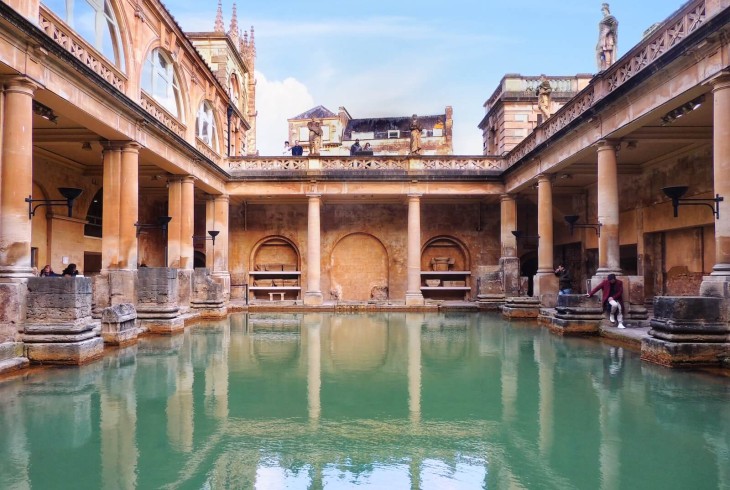
With its fascinating history, spectacular Georgian architecture and rich literary heritage (think the witty repartee of Jane Austen’s characters as they promenade down cobbled lanes), magnificent Bath is one of the most charming cities in all of England. Amongst the series of glittering highlights that Bath has to offer, the first amongst equals must be the magnificent ancient thermal spa complex that gives the city its name. Easily one of the most important Roman archaeological sites outside the Mediterranean, a visit to Bath’s baths offers the unique opportunity to travel back in time to the heyday of Roman Britain almost 2,000 years ago.
Discover the story of this incredible UNESCO World Heritage Site with us, and find out why a visit to Bath needs to be on your to-do list next time you’re in England - conveniently, it’s an easy day trip from London !
Roman Bathing Rituals

But first, some background. Roman enthusiasm for communal bathing was legendary: in Rome alone massive thermal complexes like the Baths of Diocletian and the Baths of Caracalla served thousands of citizens every day. Water was considered to be a gift from the gods in antiquity, and Romans were convinced of the therapeutic benefits of bathing.
The rituals at the baths encompassed a number of well-defined phases: the first stage typically involved plunging into the icy waters of a cold pool known as a frigidarium in order to stimulate circulation. The next stop was the tepidarium , whose relatively warmer temperatures helped bathers to adjust before making their way to the caldarium , where a hot bath and steam treatments awaited. After oiling up, bathers were scraped down with an instrument known as a strigil before returning to the frigidarium for a final rinse.
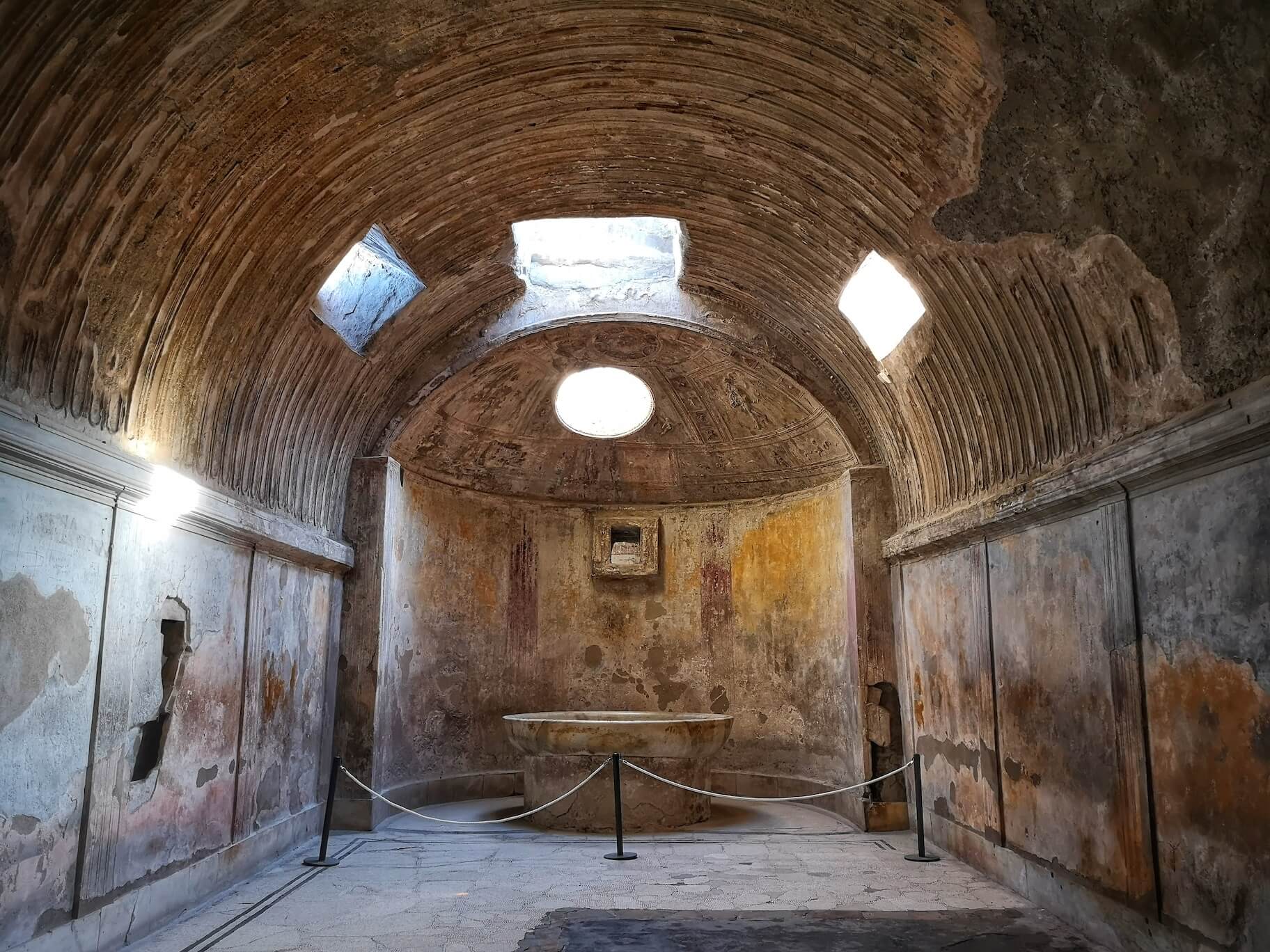
In addition to the well-established health and hygiene benefits associated with bathing, regular visits to the baths had an important social function in the ancient Roman world: it was here that citizens might catch up with the latest gossip, learn of the important news of the day, transact business deals or simply hang out with friends and colleagues chatting, playing games and gambling. Major bath complexes often even had fully-fledged gyms and lavishly decorated libraries attached - mosaics from the library at the Baths of the Caracalla (now housed in the Vatican museums) offer some of the most vivid portraits of gladiators to survive from antiquity.
As the empire expanded and Roman colonies spread to the farthest-flung corners of the known world, Romans brought their bathing customs with them: for the soldiers, bureaucrats and elite officials that kept the empire’s dominions ticking over, a day at the baths was a much-needed reminder of the comforts of home.
Britain had been in the sights of land and resource hungry Roman generals since Julius Caesar made a series of forays onto the island between 55 and 54 BC, and the emperor Claudius finally launched a fully-fledged invasion just under a century later in 43 AD. Major settlements at Londinium (London) Camulodonum (Colchester) and Verulamium (St. Albans) provided the first footholds in the new territory, and with them the story of Roman Britain had truly begun.
The Roman Baths at Bath in Antiquity
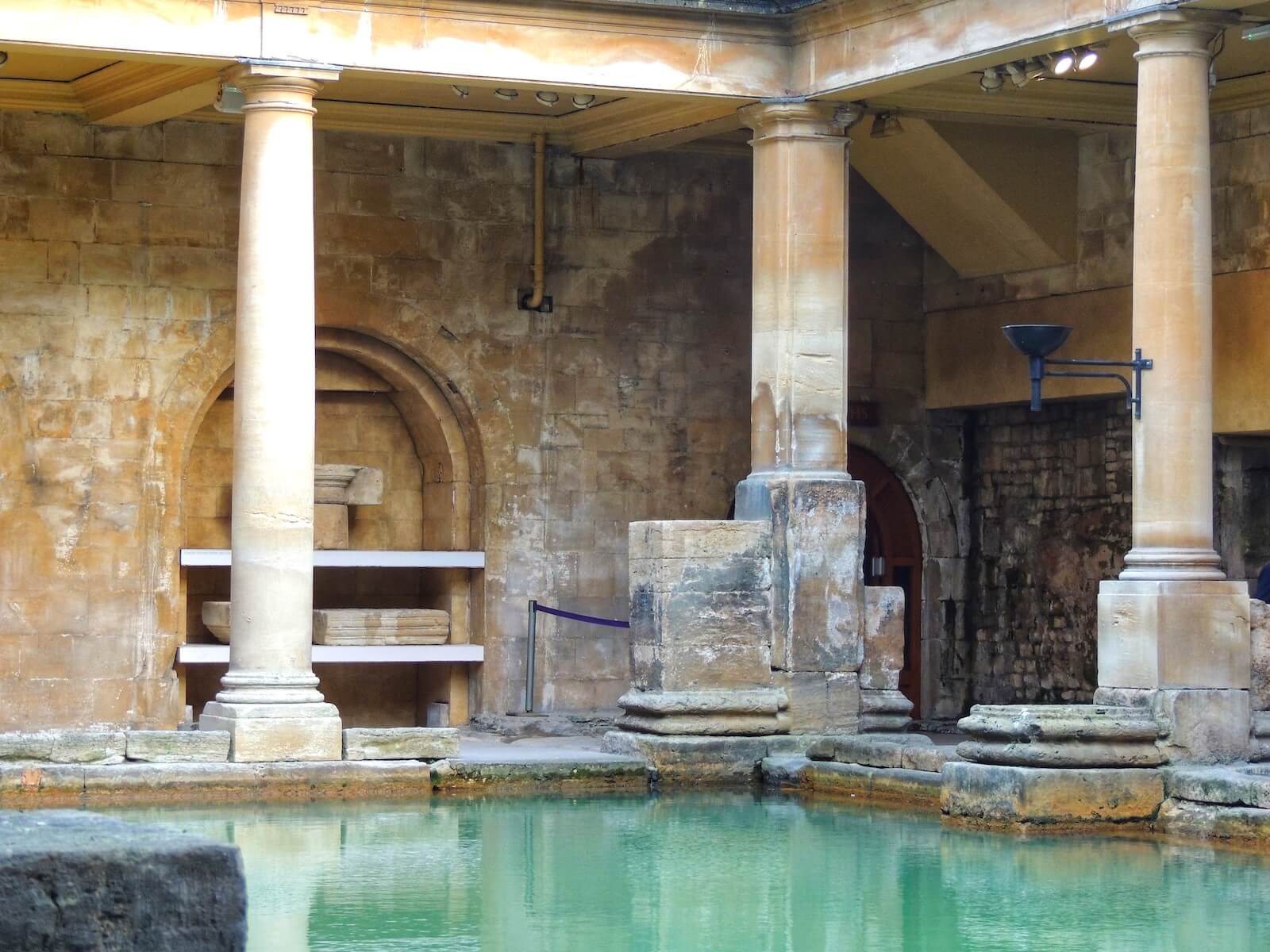
The stunning thermal complex at Bath has its origins around the year 70 AD, and centred around a hot spring known as the Aquae Sulis that the Roman invaders considered to possess extraordinary, divinely-inspired health benefits. To valorise the site, local Roman officials built an elaborate baths complex over the springs alongside a grandiose temple dedicated to Sulis-Minerva, the goddess of healing who was thought to inhabit the spring. It’s not known who exactly was responsible for the foundation of the Roman temple and baths, but the sophisticated architecture and design indicates that the site had powerful backers.
The Sacred Spring
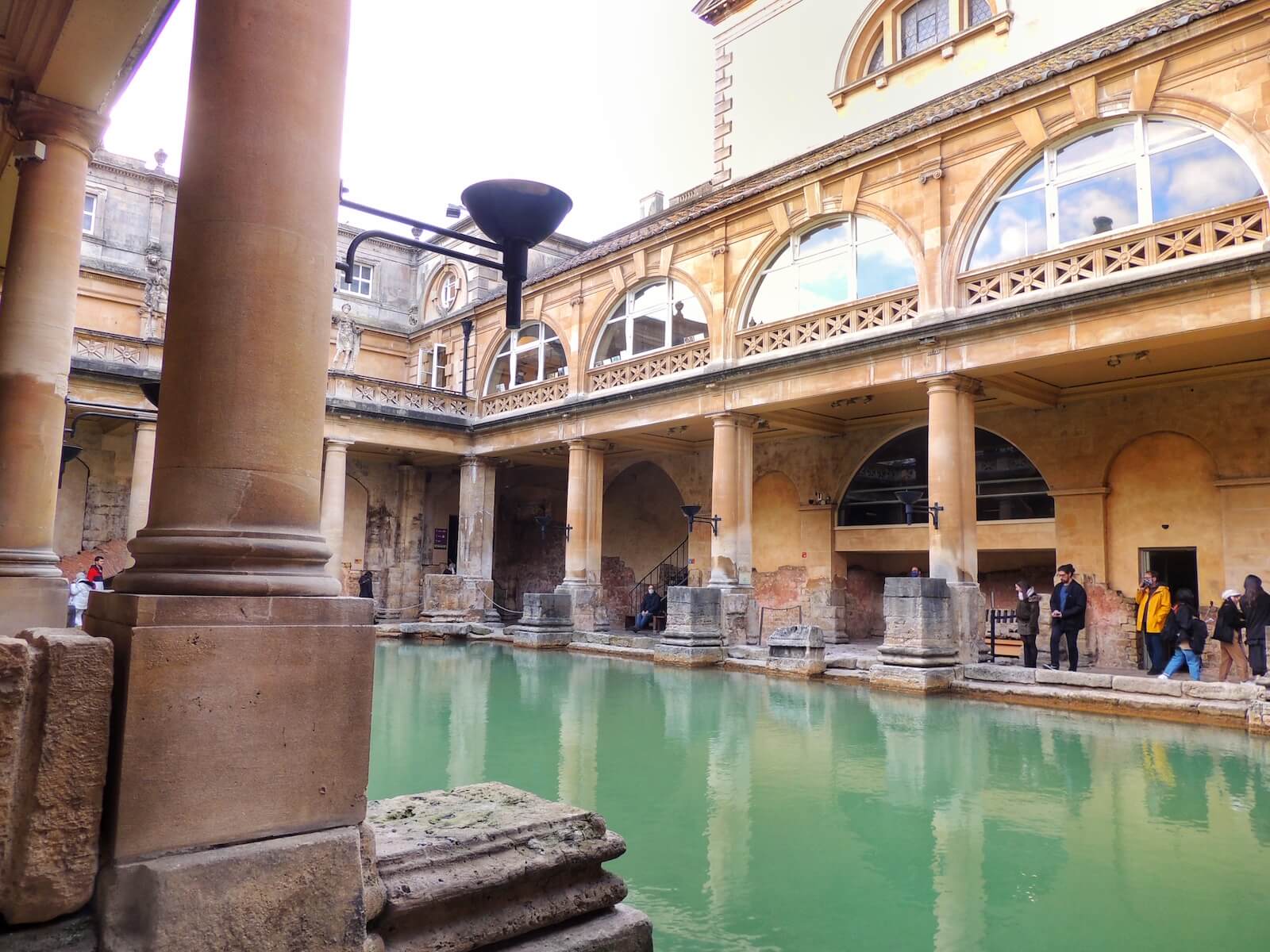
The boiling water that bubbles up from the earth beneath the baths owes its existence to a unique geo-thermic phenomenon. Over the course of thousands of years, rainwater has seeped slowly through the porous limestone rock characteristic of the local landscape, down, down through the earth’s crust and towards its molten core - picking up heat and an array of minerals including calcium, sodium, magnesium, and potassium along the way. The laws of physics dictate that the pressurised water begins to rise again once it reaches a depth of around 4,000 metres, and eventually the still hot (between 110 and 120 degrees fahrenheit), mineral laden water surges out of the bedrock through three fissures in the earth at the incredible rate of 1.44 million litres per day.
The thermal springs at Bath were known to the pre-Roman prehistoric denizens of the Mendips thousands of years before the final conquest of Britain in the year 43 AD, and a shrine to the Celtic goddess Sulis already existed in the area. To the bathing-crazed Romans too it seemed like a gift from the gods, and they wasted little time in building their own temple dedicated to Sulis repurposed as the Roman goddess Minerva - ancient Romans were syncretic in their beliefs, and were always ready to pay homage to new gods in the distant lands to which they ventured. And so the new settlement that sprang up here came to be known as Aquae Sulis.
The Temple of Sulis-Minerva

Remains of this grand temple, the best preserved of Roman Britain, can be seen beneath the baths complex. The temple itself rose on a large, 2-metre tall podium approached via a flight of steps from the surrounding courtyard. Corinthian columns held up a pediment and frieze decorated with sculptures. Sections of the pediment, with its threatening bearded Gorgon head decoration, can be seen in the subterranean museum, alongside a number of fascinating ancient finds including a large cache of coins that were thrown into the sacred spring as votive offerings to the goddess. You can also see a magnificent sculptured head in gilt bronze of Sulis Minerva here was discovered by workmen in 1727, the first major archaeological find on the site and the one which kickstarted excavations of Roman Bath.
The Great Bath

The Great Bath was at the heart of the ancient bathing complex. Here the restorative waters of the hot spring, known as the Fons Sulis, were siphoned and collected into a large lead-lined pool measuring 24 metres by 12 metres, and 1.6 metres deep, where bathers would immerse themselves in the sulphuric liquid to take advantage of its healing properties. The pool was surrounded by an arcade with a marble pavement and benches so visitors to the baths could stroll in between dips. Although the bath is open to the elements today, it would have been covered in antiquity; an initial timber roof was replaced by a soaring barrel vault in brick and concrete sometime in the 2nd century AD.
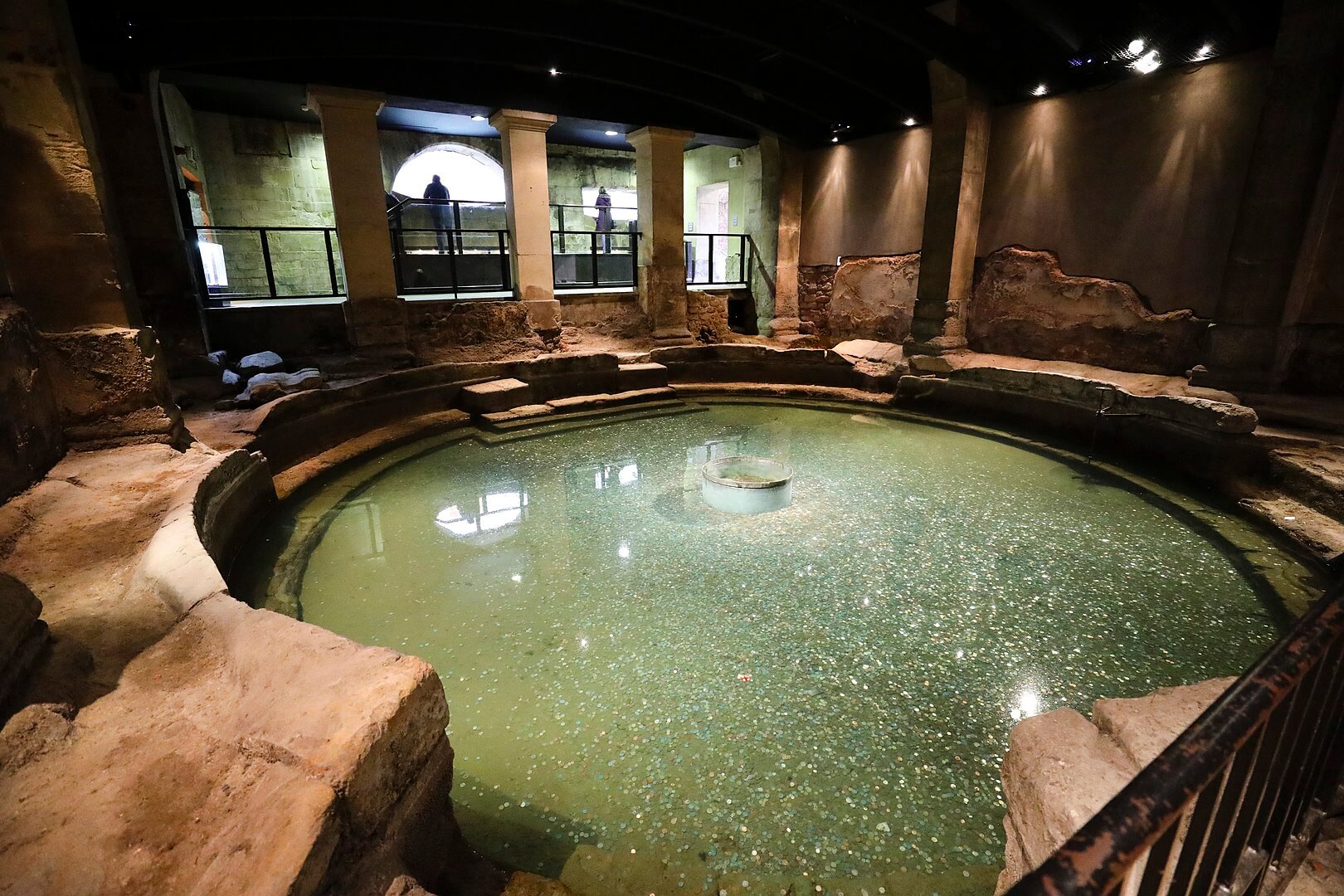
At the western end of the complex the conventional rooms of a traditional Roman bath appeared - the frigardium, tepidarium and caldarium , as well as a laconicum , or dry sweat room. Excavations have uncovered the complex hypocaust system of pipes and steam that heated the floors, raised on small brick pillars, under the bathing spaces. Digital projections of ancient Roman bathers pop up here and there along the walls of the bathing room, providing insight into what went on here in antiquity.
The King’s Bath
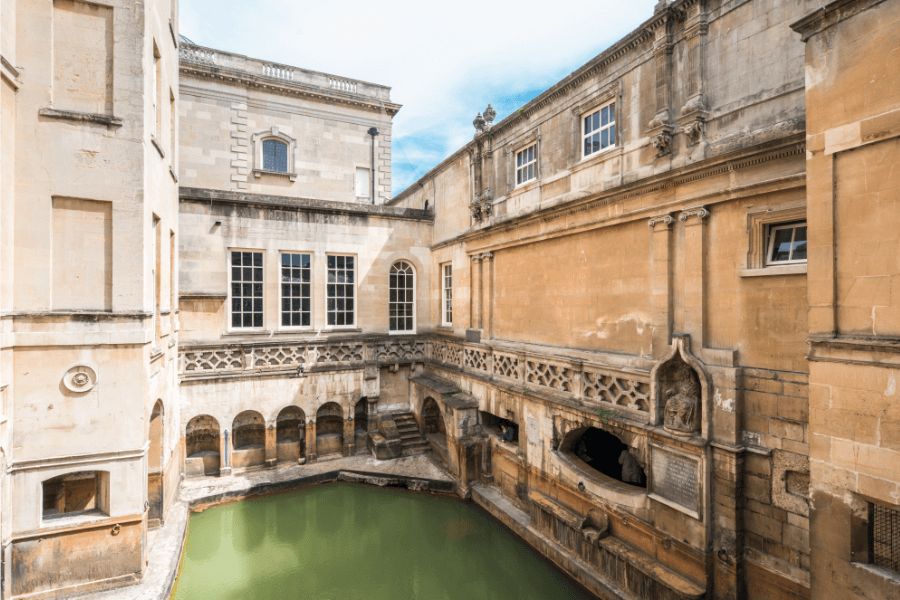
The baths were in use by the Romans for over 300 years, before they fell into disuse and decline as Roman influence in Britain waned. The vaulted Roman bath probably collapsed in on itself in the 6th century, and the wooden piles that supported the pool sunk deep into the mud. The spring remained known to residents of the area, however, and in the 12th century another bathing pool was built adjacent to the Great Pool, making use of the walls that the ancient Roman engineers built around the spring itself as foundations. This new medieval complex was probably the brainchild of John of Tours, a priest and doctor who became the city’s bishop, and was known as the King’s Bath. A contemporary text describes how 'from all over England, sick people come to wash away their infirmities in the healing waters’ during this period.

The King’s bath had niches installed into the sides of the pool where bathers could sit covered to their necks in the curative waters. A statue of the mythical British king Bladud, who according to legend founded the city after a restorative dip in the brackish local waters cured him of a nasty bout of leprosy in 863 BC, presides over the proceedings. A smaller bathing pool sits alongside the King’s Baths. Originally known as the New Bath, it was renamed the Queen’s Bath in honour of Queen Anne of Denmark, who visited the site in 1613.
Developing medical interest in the curative properties of the spa waters meant that the baths became increasingly popular throughout the early modern period, spurred on by local physicians waxing lyrically about the miraculous effects of the local water to heal all manner of ills - from rheumatism to palsy, trembling limbs and even amnesia. The diarist Samuel Pepys visited the Baths in 1668, and recalled seeing great throngs of bathers from every rank and class of society all thrown together in the mineral-rich waters, ‘parboiled’ from the heat.
The Terrace
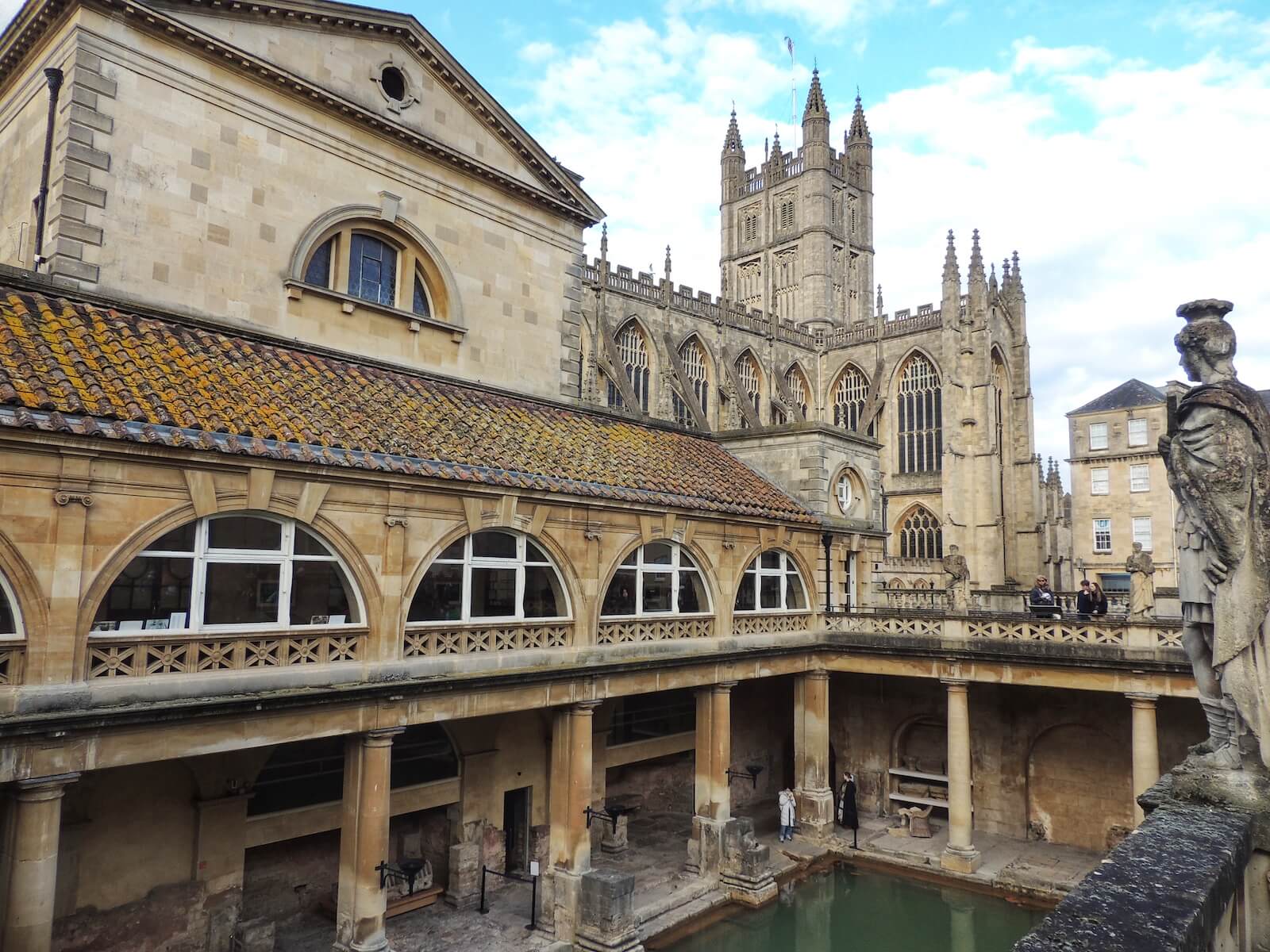
The popularity of the baths as a must-visit destination only grew as the centuries wore on, reaching a peak in the Georgian and Regency era when the curative properties of the water were renowned across the country, and helped make Bath one of England’s most fashionable cities.
The current aspect of the baths owes much to this period, and today the complex is immersed in a spectacular series of early 19th-century neoclassical buildings designed by the father-and-son architect team John Wood the Elder and John Wood the younger, whose work you’ll also be able to admire at the Royal Crescent, the Circus and Queen Square. From the sweeping terrace that they built atop the baths you can get a fabulous view down into the vibrant green waters of the ancient Great Pool. The terrace is watched over by statues depicting Roman Emperors and governors.
The Pump Room

Nowhere embodies the fashionable world of Regency-era Bath as immortalised so brilliantly in the novels of Jane Austen better than the Pump Room, a magnificent hall studded with chandeliers, elegant tiles and paintings where the great and the good of Georgian England came to quite literally ‘take the waters.’ The mineral-laden waters of the Spring were pumped up here from an elegant fountain (hence the name) to be drunk by patrons for its supposed health benefits.
The Pump Room was the premier place to see and be seen, and Austen described how ‘every creature in Bath was to be seen in the room at different periods of the fashionable hours.' Now home to the Pump Room restaurant, it’s still a mighty popular spot today, and you might well find yourself tumbling in here for afternoon tea after a long day exploring the Baths. And the water? Well, you can still sample the it in the Pump Room, but fear not - these days it’s been carefully treated and filtered to make sure you’re not getting any unwelcome bacteria alongside the 42 minerals that make the water famous. Be warned, though, it is something of an acquired taste!
How to Visit
The Roman Baths are one of England’s top visitor attractions, and can get very busy during the weekends and summer months. It’s essential to book your timed entrance ticket in advance to avoid disappointment. For up to date pricing and to book your tickets, visit the Roman Baths official website. If you’d like to take the hassle out of arranging your visit and explore the Roman Baths in the company of an expert, then consider taking a private tour of Bath.
Through Eternity Tours offer private day-trips from London to Bath. Discover the magnificent sights of England’s finest Georgian city, from the incredible ancient Roman Baths to the Royal Crescent and more in the company of a local expert guide - follow the link below to find out more: Bath and Stonehenge Day Trip from London .
Post Categories
Suggested Tours

Best of London Tour with Westminster Abbey and the National Gallery
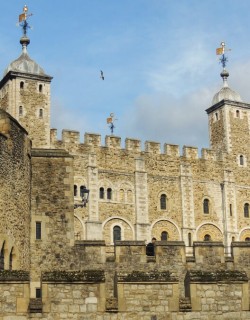
Tower of London and Borough Market Tour
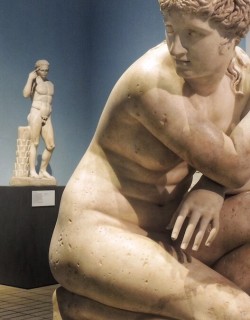
British Museum and Bloomsbury Walking Tour
Bath and Stonehenge Day Trip from London
Subscribe to our newsletter and receive 5% off your first booking!
You'll also receive fascinating travel tips and insights from our expert team
Subscribe to our free newsletter
Thank you for subscribing!
You should shortly receive a confirmation message with your discount code. If you do not receive this within 5 minutes, please email [email protected].

Sign Up Today
Start your 14 day free trial today

History Hit Story of England: Making of a Nation
Roman Baths – Bath
City of Bath, England, United Kingdom
The Roman Baths in Bath is an Ancient Roman thermal spa and one of the best preserved examples of its kind.

Peta Stamper
17 may 2021.

About Roman Baths – Bath
The world famous Roman Baths complex in Bath, UK , contains an incredible set of thermal spas and an impressive ancient Roman bathing house. First discovered in the 19th century, the Roman Baths are one of the best preserved ancient Roman sites in the UK and continue to be a major tourist attraction.
Roman Baths – Bath history
The Romans Baths were initially built as part of the town of Aqua Sulis, which was founded in 44 AD. Vast and lavish, the baths were able to accommodate far more people than just the residents of this town and were intended as visiting spot for Romans across the Empire. As with other contemporary bath complexes , in Bath the baths were a focal point for the town: a place for socialising and spirituality.
It is unsurprising that the Romans chose to build such magnificent baths in Bath. The area benefits from hot springs from the Mendip Hills which arrive at the Roman Baths at a temperature of 46 degrees Celsius and rise due to enormous pressure.
Prior to the Romans discovering these springs, the Celts dedicated this phenomenon to the Godess Sulis. The Romans equated Sulis with their own deity, Minerva , and kept the original name by calling the town Aqua Sulis – the waters of Sulis.
Roman Baths – Bath today
Today, the Roman Baths offer an incredibly comprehensive insight into the lives of the ancient Romans in the town and around Britain. While the site looks quite small from the outside, a visit can last several hours.
One of the first things one sees upon entering the site is a view from the terrace above the Great Bath. Overlooked by 19th century statues of various Roman icons, the terrace is the centrepiece of the site and a first glimpse into what lies ahead. Later on in the tour, visitors arrive at the Great Bath, where it is possible to stand right alongside the water. There are even costumed characters on site to create an authentic mood and entertain younger visitors.
The sacred spring is next along the tour: visible through a floor to ceiling window, visitors can view the original spring of hot water which was dedicated to Minerva due to its believed healing powers. The spring was also a place of worship where people threw coins, curses, wishes and prayers. Many of these messages can be seen at the Roman Baths ranging from humorous to sinister.
The Temple and the Temple Courtyard were similarly sacred spaces within the Baths. The Temple dates to the late 1st century, active until 391 AD when it was closed by Emperor Theodosius as Christianity became the Empire’s state religion. Walking through the Temple Courtyard, videos are shown to demonstrate what this once magnificent site would have looked like and how it was used. It is also here that you can see the gilded bronze head of Minerva.
Among other sites at the Roman Baths, there is a comprehensive museum dedicated to exploring the lives of the ancient Roman citizens of Bath and an ancient drain used as an overflow system. Around the Great Bath itself, explore the numerous saunas, swimming pools, heated baths and changing facilities at the site.
Audio tours, available in English, Spanish, German, French, Italian, Dutch, Japanese and Mandarin and are included in the ticket price or visitors can join one of the hourly guided tours. The audio tour includes sections by the famous author Bill Bryson, and there are also children’s audio guides.
Getting to the Roman Baths – Bath
The Romans Baths are located within Bath’s historic centre. For those driving, Bath is along the A4 and A36 roads, a 40 minute drive from Bristol and 2 and a half hours via the M4 from London. If using public transport, the 94, 752, UCB, X79, X84, X85, X88 bus lines stop at Bath Abbey , a 2 minute walk from the baths. Bath Spa train station with links to London and the South West is a 6 minute walk away.
Featured In

Somerset's Historic Sites
Roman baths, ruined abbeys and the oldest residential street in England are all found within the pretty county of Somerset. Here's our pick of 10 of the very best historic sites to visit there.

The Top Historic Spa Towns to Visit in Europe
From Roman bathhouses to mineral-rich mountain springs: soak up some history at these 7 historic spa towns and bathing sites around Europe.

Roman Baths in Europe
Immerse yourself in the history of the Roman Empire at these remarkable ancient ruins of bathhouses and hypocausts across Europe.

Historic Attractions in England
Discover the best historic sites in England, from Hadrian's Wall to Bletchley Park and more.
10 of the Best UK Historic Sites
Discover 10 of the best Historic Sites in the United Kingdom, from the Roman Baths in Bath to Edinburgh Castle and more.

Roman Sites in England
Discover some of the best Roman sites in England, from the iconic Hadrian's Wall to the country's largest Roman residence of Fishbourne Palace. With amphitheatres, mosaics, forts, and bath houses to explore, this guide will walk you through what remains of one of history's most famous Empires.

Related Articles

Tacfarinas: Rome’s North African Nightmare

The World’s Oldest Profession: Prostitution in Ancient Rome
Watch and listen.

Septimus Severus in Scotland with Simon Elliott

Life and Death in Roman London: The City Falls
You may also like.

The 10 Best Bronze Age Sites to Visit in the World

5 Historic Mazes to Explore in England

Explore the Key Sites of Henry VIII’s Life and Reign

5 of the Best Hillforts in England

10 British Churches Ruined During the Dissolution of the Monasteries

The Best English Civil War Sites and Battlefields

11 British Royal Residences

10 Must-See Medieval Landmarks in England

10 of the Best Norman Sites in Britain

10 Historic Sites Associated with Anne Boleyn

10 Key Crusader Ruins and Monuments

Viking Sites in Scotland: 5 Areas with Nordic History

10 Historic Sites You Should Not Miss in 2023

Historic Sites Associated with Mary Queen of Scots
Thousands more children will be able to visit Bath's Roman Baths for free
The Roman Baths is one of the most complete time capsules of Roman Life in Britain
- 05:41, 8 SEP 2024

Want to receive the latest top stories from around Bath straight to your inbox?
We have more newsletters
More school children will be able to visit the Roman Baths and Victoria Art Gallery for free thanks to a new Free School Visits scheme launched by Bath & North East Somerset Council.
Free visits and learning sessions will be available to state-funded primary and secondary schools across the UK where 30% or more of pupils receive free school meals. This scheme builds on the council’s emphasis on making heritage and culture accessible for all. Booking is now open for Free School Visits from September.
Councillor Paul Roper, Cabinet Member for Economic & Cultural Sustainable Development, Bath & North East Somerset Council, said: "High-quality, immersive school trips should be accessible to all students. We understand that cost can be a significant barrier for schools, and we hope that our new offer of free entry and free learning sessions for eligible schools will make a difference. We are committed to sharing Bath’s rich heritage and, through this new initiative, we aim to ensure that more children can experience the excitement of learning in an unforgettable setting."
The Roman Baths is one of the most complete time capsules of Roman Life in Britain, and each year brings the past to life for more than 30,000 school children. Schools can enjoy self-guided visits to the site as well as curriculum focused teaching sessions in the state-of-the-art Roman Baths Clore Learning Centre. The award-winning learning programme invites school groups to discover Roman life and culture, explore feats of engineering and science, and get hands on with history with collection handling and archaeological digs in the immersive investigation zone.
The Victoria Art Gallery in the heart of Bath welcomes students of all ages to learn about art and develop their creativity. Learning sessions offer immersive, interactive and accessible ways to explore the Gallery’s collection and temporary exhibitions of contemporary and historic art – and share the stories of artists and their work.
Lindsey Braidley, Learning & Participation Manager at Bath’s Heritage Services, said: "Experiencing history and art firsthand is invaluable for young learners. Not only do school visits enhance learning, but engaging with heritage also provides significant benefits for health and well-being. For many children, a school trip to a museum or gallery might be their only opportunity to discover heritage and culture, and we want to ensure this is available to as many students as possible.
As well as offering a memorable way to discover history, a visit to the Roman Baths can inspire conversations around culture, science, lifestyle, engineering, health, and other subjects across the curriculum. We look forward to hearing from eligible schools to arrange their free visit.”
Somerset Live WhatsApp Breaking News and Top Stories

Join Somerset Live’s WhatsApp community for top stories and breaking news sent directly to your phone
Somerset Live is now on WhatsApp and we want you to join our community.
Through the app, we’ll send the latest breaking news, top stories, exclusives and much more straight to your phone.
To join our community you need to already have WhatsApp. All you need to do is click this link and select ‘Join Community’.
No one will be able to see who is signed up and no one can send messages except the Somerset Live team.
We also treat community members to special offers, promotions and adverts from us and our partners. If you don’t like our community, you can check out at any time you like.
To leave our community, click on the name at the top of your screen and choose ‘Exit group’.
If you’re curious, you can read our Privacy Notice.
Click here to join our WhatsApp community.
- Most Recent

Explore Bath's world heritage

Other things to do in Bath
Changing narratives of bath's heritage.

As part of Black History Month at Bath Spa University, hear from speakers from well-known institutions in Bath to take a deeper look at the hidden histories of Black people in Britain, hear new perspectives on stories you thought you knew and understand the work that is being carried out in decolonising our history. The panel of speakers will be:
- Amanda Hart – Roman Baths and Pump Room Manager
- Dr Amy Frost - Senior Curator of Bath Preservation Trust
- Cathryn Spence - Curator and Archivist at Bath Abbey
- Mark De’Lisser - Bath based poet, facilitator and youth mentor
- Polly Andrews – Learning Manager at Bath Abbey
- Tim Moore - National Trust Project Curator at Bath Assembly Rooms
Event Details
The event will be hosted at the Michael Tippett Centre at Bath Spa University, doors will be open from 6pm and the event will start at 6:30pm. Drinks and canapés will be served.
Michael Tippett Centre, Newton St Loe, Bath, BA2 9BN
Share this page
Follow us on social media.
Stay updated
Privacy Policy
Pope arrives in the remote jungles of Papua New Guinea with a ton of humanitarian aid and toys

VANIMO, Papua New Guinea — Pope Francis traveled to the remote jungles of Papua New Guinea on Sunday to celebrate the Catholic Church on the peripheries, bringing with him a ton of medicine, musical instruments, and a message of love for the people who live there.
Francis flew aboard a Royal Australian Air Force C-130 transport plane from Port Moresby to Vanimo, on the northwest coast of the South Pacific nation. There, Francis met with the local Catholic community and the missionaries from his native Argentina who have been ministering to them.
For an Argentine pope who marveled in 2013 at having been chosen from the “end of the Earth” to lead the church, it was a voyage to another end of the Earth on the longest, farthest trip of Francis’s pontificate.
Advertisement
Francis has previously traveled to the edge of the Arctic (to apologize to the Inuit people for church abuses), into the Peruvian Amazon (to draw attention to its plight), and to the plains of Ur, Iraq (to boost Christian-Muslim ties). But even by his standards, Sunday’s trip to remote Vanimo was extraordinary.
A crowd of an estimated 20,000 people gathered on the field in front of the Vanimo cathedral singing and dancing when Francis arrived, and he promptly put on a feathered headdress that had been presented to him.
In remarks from a raised stage, Francis praised the church workers who go out to try to spread the faith. But he urged the residents of Vanimo to work at home at being good to one another. He urged them to be like an orchestra, so that all members of the community come together harmoniously to overcome rivalries.
Doing so, he said, would help to “drive out fear, superstition, and magic from people’s hearts, to put an end to destructive behaviors such as violence, infidelity, exploitation, and alcohol and drug abuse, evils which imprison and take away the happiness of so many of our brothers and sisters.”
It was a reference to the tribal violence over land and other disputes that have long characterized the country’s culture but have grown more lethal in recent years. Francis arrived in Papua New Guinea to urge an end to the violence, including gender-based violence, and for a sense of civic responsibility to prevail.
Francis had started the day with a Mass before an estimated 35,000 people at the stadium in the capital, Port Moresby. In his homily, Francis told the crowd that they may well feel themselves distant from both their faith and the institutional church, but that God was near to them.
“You who live on this large island in the Pacific Ocean may sometimes have thought of yourselves as a far away and distant land, situated at the edge of the world,” Francis said. “Yet … today the Lord wants to draw near to you, to break down distances, to let you know that you are at the center of his heart and that each one of you is important to him.”
Francis was elected pope largely on the strength of a speech he gave to his fellow cardinals in 2013 about the need for the church to go out to the “peripheries” where people need God most. In keeping with that philosophy, Francis has largely shunned foreign trips to European capitals, preferring instead far-flung communities where Catholics are often a minority.
Vanimo, population 11,000, certainly fits the bill of being remote. It is located near Papua New Guinea’s border with Indonesia, where the jungle meets the sea, and is for the most part only reachable by plane or boat.
Francis, history’s first Latin American pope, has also had a special affinity for the work of Catholic missionaries. As a young Argentine Jesuit, he had hoped to serve as a missionary in Japan but was prevented from going because of his poor health.
Now, as pope, he has often held up missionaries as models for the church.
The Rev. Martin Prado, an Argentine missionary of the Institute of the Incarnate Word religious order, was responsible for getting the pope to Vanimo.
As he waited for Francis to arrive Sunday, he recounted for reporters the “crazy” story of how he accompanied a group of Vanimo parishioners to Rome in 2019, and ended up scoring an audience with the pope after his parishioners insisted that they wanted to give him some gifts.
Prado, who has spent the past 10 of his 36 years working as a missionary in Vanimo, said he wrote a note, left it for the pope at the Vatican hotel where he lives, and the next day received an email from Francis' secretary inviting his group in.
“I invited him, but he wanted to come,” Prado said. “He has a big heart for people. It’s not just words: He does what he says.”
Prado said some people deep in the interior of the diocese, in the jungle where cars have yet to arrive, need clothes, and for them a plate of rice and tuna fish “is glorious.”
Francis was bringing a cargo of about a ton of medicine, clothing, musical instruments, and toys, the Vatican said. Prado said Francis was also helping to build a new secondary school. He said half of the children of the diocese are unable to go to high school because there simply aren’t enough spots for them.
The event had a very Argentine flair to it: On the stage was a statue of the Virgin of Lujan, the patron of Argentina who is particularly dear to Francis and whose name also graces the local girls' school. When Francis met privately after the event with the nuns and missionary priests, they served him mate, the Argentine tea.
There are about 2.5 million Catholics in Papua New Guinea, according to Vatican statistics, out of a population in the Commonwealth nation believed to be around 10 million. The Catholics practice the faith along with traditional Indigenous beliefs, including animism and sorcery.
Francis’s visit to Vanimo was the highlight of his visit to Papua New Guinea, the second leg of his four-nation tour of Southeast Asia and Oceania. After first stopping in Indonesia, Francis heads on Monday to East Timor and then wraps up his visit in Singapore later in the week.

IMAGES
VIDEO
COMMENTS
The Roman Baths are in the centre of Bath, 100 miles west of London. Find out how to get there, plan your visit, buy tickets online and explore the Roman bathing experience with audioguides and guided tours.
Visit the stone remains of one of the finest religious spas of the ancient world, hidden beneath the present city of Bath. Explore different ways to experience this place, such as walking tours, bus tours, and audio guides, and see photos and reviews from other visitors.
Visit the Roman Baths, a UNESCO World Heritage Site, and discover 2,000 years of history. Learn about the Roman culture, architecture, and religion through exhibitions, events, and tours.
Visit the Roman Baths, one of the best-preserved Roman remains in the world, where you can see the steaming spring water and explore the ruins and treasures. Learn about the history and culture of the Aquae Sulis people and enjoy events, audio guides and special offers.
Learn about the history, tickets, and tips for visiting the Roman Baths, a well-preserved complex of bathhouses and temples from the Roman Empire. See the hot springs, the museum, and the Pump Room, and discover some fun facts and trivia about the site.
Experience how Bath's residents would have lived in the late 18th Century with a visit to No 1 Royal Crescent. For a modern take on a Roman Bath, visit the Thermae Baths with their open-air rooftop pool filled and heated with the natural spring water the Romans would have used.
Bath is a rare double-inscribed World Heritage Site, with two UNESCO inscriptions: one for its Roman and Georgian heritage and one for its spa culture. Explore the history, management and attractions of this exceptional city through the World Heritage Centre, app and guide.
The Roman Baths are well-preserved thermae in Bath, England, dating from the 1st to the 5th century AD. They are a major tourist attraction and contain the Sacred Spring, the Roman Temple, the Roman Bath House, and a museum.
Learn about the history and significance of the Roman Baths, one of the best-preserved ancient Roman spas in the world. Discover how to visit, what to see and do, and where to sample the healing waters of the Sacred Spring.
The Baths. 1,170,000 litres of steaming spring water reaching 46 °C still fill the bathing site every single day. The Romans believed that this was the mystical work of the Gods but we now know that the water source, which comes from the King's Spring, fell as rainwater around 10,000 BC. Visit The Great Bath, the magnificent epicentre to the ...
Learn about the Roman Baths, the only place in the UK with natural warm springs and a stunning ancient spa and temple. Find out how to visit, what to see, and how to get discounts or free entry.
Learn about the ancient history of the Roman Baths in Bath, England, where the Romans built a temple and bath complex around a sacred spring. Discover how the site was transformed by the Romans and the locals, and what you can see and do at the museum today.
Learn about the ancient Roman baths in Bath, England, where you can admire the thermal springs, the temple and the antique objects. Find out the best time to visit, how to get there and what to see, including the famous curse notes.
The Roman Baths is an archaeological site that contains the remains of a large Roman bath complex, built around the year 138. The Roman Bath (a significant structure first discovered in 1590, and subsequently restored in the 18th century), is the main feature of the site. The Roman Baths were used as a public bath house where the Romans bathed ...
The Roman Baths are conveniently located in the center of the historic city of Bath, England. The address is Stall Street, Bath, BA1 1LZ. The site is easily accessible by public transportation, with several bus stops and a train station nearby. If you prefer to drive, there are parking facilities available in close proximity to the baths.
The Roman Baths are right in the center of Bath on Stall St. The entrance is in Abbey Church Yard. Opening hours vary depending on the season so check the website for an up-to-date schedule (they are generally open from 9am-5pm, however, with extended hours in the summer). Admission costs 27.50 GBP on weekends and 25.50 GBP on weekdays.
The Roman Baths in Bath are one of the city's unique attractions and the number one thing to see in this charming UNESCO World Heritage city. A hot spring was enclosed in the 2nd century AD, the Romans built their temple to the Goddess Sulis Minerva here, and fashionable Georgian society flocked in the 18th century to take the waters. Roman ...
Bath is a historic and elegant city in the UK, famous for its Roman Baths, Georgian architecture and cultural attractions. Find out how to plan your visit, explore the best places to stay, eat and enjoy, and discover the latest events and festivals in Bath.
How to Visit the Roman Baths in England. Here's what you need to know to visit the Roman Baths: Address: The Roman Baths, Abbey Church Yard, Bath, BA1 1LZ. Hours: In July and August the Roman Baths are open until late evening. Tickets: Admission to the Roman Baths is £ 20-25 per ticket, depending on when you go.
The best times of year to visit the Roman Baths in Bath are during the shoulder seasons of spring (April-May) and autumn (September-October). During these months, the weather is mild and pleasant, and there are fewer tourists than during the peak summer months. If you are planning to visit the Roman Baths during the summer months (June-August ...
Learn about the ancient thermal spa complex that gave Bath its name and explore its fascinating history, spectacular Georgian architecture and rich literary heritage. Discover the story of the sacred spring, the temple of Sulis-Minerva, the Great Bath and the Roman bathing rituals.
Visit the Roman Baths in Bath, UK, one of the best preserved ancient Roman sites in the UK. Learn about the history, culture and religion of the Romans through the thermal spas, the sacred spring, the temple and the museum.
See Bath Abbey, perhaps the country's finest example of perpendicular gothic architecture; Visit the Roman Baths to see the fascinating items and legacies left by the Romans; Discover the Royal Crescent, 30 Grade-1 listed houses and the greatest example of Georgian architecture in England; Explore the Circus and learn about this architectural ...
More school children will be able to visit the Roman Baths and Victoria Art Gallery for free thanks to a new Free School Visits scheme launched by Bath & North East Somerset Council. Free visits ...
Mark De'Lisser - Bath based poet, facilitator and youth mentor; Polly Andrews - Learning Manager at Bath Abbey; Tim Moore - National Trust Project Curator at Bath Assembly Rooms; Event Details. The event will be hosted at the Michael Tippett Centre at Bath Spa University, doors will be open from 6pm and the event will start at 6:30pm.
Roman Baths Clore Learning Centre Find out what it was like to live in Roman Bath with fun activities, crafts and crazy rituals. Friday 6 and Tuesday 10 September, 6-8pm. ... There are many more places to visit across Bath & North East Somerset during the 10-day celebration. For full listings, ...
Take advantage of The Roman Baths' later opening times and soak up the rich history of this remarkably preserved 2,000 year old site. Pause to enjoy the special atmosphere around the Great Bath, which will is torchlit every evening throughout the summer. Image: The Roman Baths
The Queen has opened and toured the new Dyson Cancer Centre at The Royal United Hospitals Bath NHS Foundation Trust. Her Majesty also met and spoke to clinical staff and patients receiving treatment in the Medlock Unit (Chemotherapy and Day Unit). The Royal United Hospital provides cancer services ...
Zillow has 7 photos of this $368,900 4 beds, 2 baths, 2,059 Square Feet single family home located at 122 Roman Heights Ave, Alexander, AR 72002 built in 2024. MLS #24032688.
Pope Francis traveled to the remote jungles of Papua New Guinea on Sunday to celebrate the Catholic Church on the peripheries, bringing with him a ton of medicine, musical instruments, and a ...